Paul van Yperen's Blog, page 184
September 16, 2020
Let's Sing-Along!
With the arrival of sound films, musicals conquered the international cinema. Europe had its own genre in the early 1930s: the film operetta. Especially in Germany and France, this genre with such stars as Lilian Harvey, Henri Garat, and Martá Eggerth became so popular that publishers started to make Sing-Along cards. The French publisher P-C in Paris specialised in these cards with the text and music of the most popular film songs. EFSP selected 24 P-C postcards, so... Let's Sing-Along!
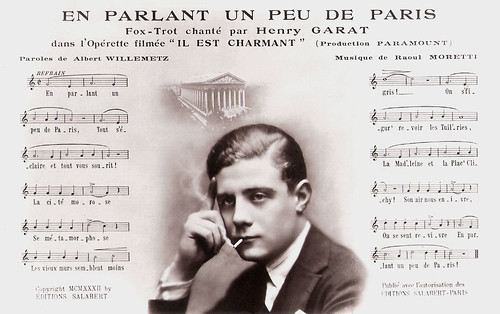
French postcard by P-C, Paris, no. 1. Photo: Paramount. Henri Garat sang the song 'En parlant un peu de Paris' in Il est charmant/He Is Charming (Louis Mercanton, 1932). Text by Albert Willemetz and music by Raoul Moretti. Copyright: Editions Salabert, Paris, 1932.
‘Beau garcon’ Henri Garat (1902-1959) was a popular singer and leading man in light romances during the 1930s. In 1930 he made his first film for the Ufa, Flagrant délit/Burglars (Hanns Schwarz, Georges Tréville, 1930). He replaced Willy Fritsch in the French adaptation of the popular German film operetta Die Drei von der Tankstelle (1930) starring Lilian Harvey and the result, Le chemin du Paradis/The Road to Paradise (Wilhelm Thiele, Max de Vaucorbeil, 1930) was a huge success and made Garat a 'grand vedette' in France.
He replaced Fritsch again in the French but also in the English versions of Der Kongress Tanzt (1931): Le congrès s'amuse (Erik Charell, Jean Boyer, 1931) and Congress Dances (Erik Charell, Jean Boyer, 1931), both with Lilian Harvey . Other films with Harvey were La fille et le garçon/The Girl and the Boy (Roger Le Bon, Wilhelm Thiele, 1931), Princesse, à vos ordres/Adorable (Hanns Schwarz, Max de Vaucorbeil, 1931) and Un rêve blond/Happy Ever After (André Daven, Paul Martin, 1932) based on a script by Walter Reisch and Billy Wilder. His songs in these films became huge hits.

French postcard by P-C, Paris, no. 4. Photo: Paramount. Meg Lemonnier sang the waltz 'Il est charmant' in Il est charmant/He is Charming (Louis Mercanton, 1932), also with Henri Garat . Text by Albert Willemetz, and music by Raoul Moretti. Copyright: Editions Salabert, Paris, 1932.
French actress and singer Meg Lemonnier (1905-1988) was most active in the French cinema of the 1930s. In the early days of the talking pictures, she made her film debut in Mon gosse de père/My Kid of a Father (Jean de Limur, 1930). It was an alternate language version of The Parisian (Jean de Limur, 1931), both featuring Hollywood star Adolphe Menjou .
In the following years, Lemonnier nicely played more or less saucy ingénues in romantic comedies and film operettas. She accompanied the popular jeune premier Henri Garat in many of his successes produced by Paramount, such as the filmed versions of Il est charmant/He is Charming (Louis Mercanton, 1932) and Un soir de réveillon/Christmas Eve (Karl Anton, 1933). Lemmonier sang the hit 'Être une poule' (Being a Tart) in Un soir de réveillon.
Meg Lemonnier sings 'Il est charmant' in Il est charmant/He is Charming (Louis Mercanton, 1932). Source:
Jozef Sterkens (YouTube).
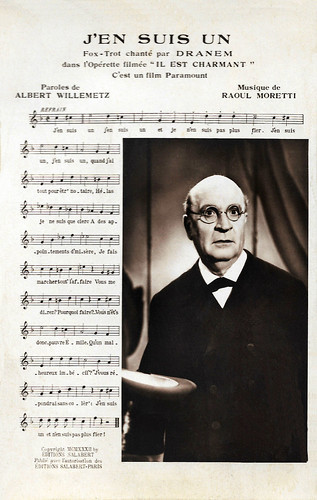
French postcard by P-C, Paris, no. 7. Photo: Paramount. Dranem sings the foxtrot 'J'en suis un' in the operetta film Il est Charmant/He Is Charming (Louis Mercanton, 1932). Words by Albert Willemetz and music by Raoul Moretti. Copyright: Editions Salabert, Paris, 1932.
Dranem (1869-1935) was a French comic singer, music hall, stage, and film actor. He already appeared in Pathé shorts in the early 1900s. The advent of sound film in the late 1920s made Dranem again much in demand for screen roles. In the early 1930s, he played in some 13 films, from which several with himself in the lead, such as La poule/The Hen (1932), and Ah! Quelle gare!/Ah! What a girl! (1933), or at least as the main male antagonist.
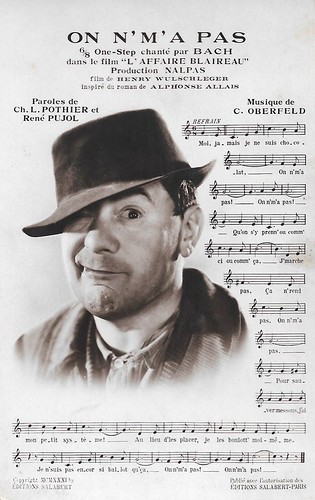
French postcard by P-C, Paris, no. 8. Photo: Nalpas. Bach sang the song 'On n' m' a pas' (a 6/8 One-Step) in L'affaire Blaireau (Henry Wulschleger, 1932). Text by Ch. L. Pothier and René Pujol, and music by C. Oberfeld. Copyright: Editions Salabert, Paris, 1931.
Bach (1882-1953) was a popular French actor, singer, and music hall performer. He starred in early sound comedies like Une grave erreur/A serious mistake (Joe Francis, 1930) and Le tampon du capiston/The capiston tampon (Joe Francis, Jean Toulout, 1930). In the following years, he appeared in such Comique Troupiers (coarse comedies) as En bordée/Bordered (Joe Francis, Henry Wulschleger, 1931), L'affaire Blaireau/The Blaireau Case (Henry Wulschleger, 1932), and Le champion du régiment/The Regiment's Champion (Henry Wulschleger, 1932) with Josette Day . He co-starred with Georges Tréville and Charles Montel in L'enfant de ma soeur/My sister's child (Henry Wulschleger, 1933) and Bach millionnaire/Bach the Millionaire (Henry Wulschleger, 1933).

French postcard by Editions P-C, Paris, no. 9. Photo: Ufa. Henri Garat sang the waltz 'Ville d'amour' in Le congrès s'amuse/The Congress Dances (Jean Boyer, Erik Charell, 1931), an alternate language version of Der Kongreß tanzt (Erik Charell, 1931) and The Congress Dances (Erik Charell, 1932). Multiple-language versions were common in the years following the introduction of sound film, before the practice of dubbing became widespread. In the German version, Willy Fritsch played Garat's role, and sang the song 'Das muss ein Stück vom Himmel sein!' Text by Jean Boyer and music by Werner R. Heymann. Copyright: Ufaton Verlag, Berlin / Editions Salabert, Paris, 1931.
Together Harvey and Fritsch would make eleven box office hits

French postcard by Editions P-C, Paris, no. 10. Photo: Ufa (Alliance Cinématographique Européenne). Lilian Harvey the Fox-trot 'Serait-ce un rêve?' in Le congrès s'amuse/The Congress Dances (Jean Boyer, Erik Charell, 1931), the alternate language version of Der Kongreß tanzt (Erik Charell, 1931) and The Congress Dances (Erik Charell, 1932). Text by Jean Boyer and music by Werner R. Heymann. Copyright: Ufaton Verlag, Berlin / Editions Salabert, Paris, 1931.
British born, German actress and singer Lilian Harvey (1906-1968) was Ufa's biggest star of the 1930s. Because of her training as a singer and a dancer, Ufa found a great use for her in light operettas. In the hit Liebeswalzer/The Love Waltz (Wilhelm Thiele, 1930) she starred with 'sunny boy' Willy Fritsch , and they became the 'dream couple' of the German cinema. Together Harvey and Fritsch would make eleven box office hits, including Hokuspokus/Hocuspocus (Gustav Ucicky, 1930), Die Drei von der Tankstelle/Three Good Friends (Wilhelm Thiele, 1930), and Ein blonder Traum/A Blonde Dream (Paul Martin, 1932). Their best film was the immensely popular film operetta Der Kongress tanzt/The Congress Dances (Erik Charell, 1931).
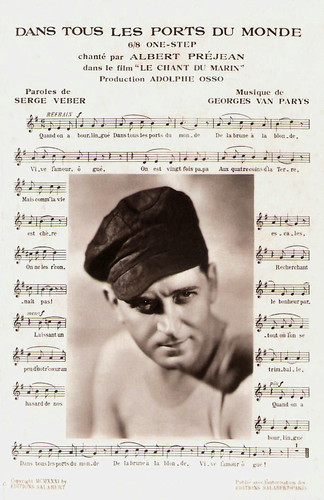
French postcard by P-C, Paris, no. 13. Photo: Films Osso. Albert Préjean sang the song 'Dans tous les ports du monde' (a 6/8 one step) in Le chant du marin/Sailor's Song (Carmine Gallone, 1932). Text by Serge Veber, and music by Georges van Parys. Copyright: Editions Salabert, Paris, 1931.
French actor and singer Albert Préjean (1894-1979) was a former WWI flying ace. He is best known for playing heroes in the silent films of René Clair, jeunes premiers in French early sound musicals, and for playing George Siménon's detective Maigret. In their his first sound feature, Sous Les Toits de Paris (René Clair, 1930), Préjean played the street performer Albert who leads the assembly line in singing the film's title song. Préjean went on to play singing working class heroes in L'Opéra de Quat'Sous (G.W. Pabst, 1931), Un soir de rafle (Carmine Gallone, 1931), the operetta Dédé (René Guissart, 1934), L'Or dans la rue (Curtis Bernhardt, 1934) and with Joséphine Baker in Princesse Tam-Tam (Edmond T. Gréville, 1935).
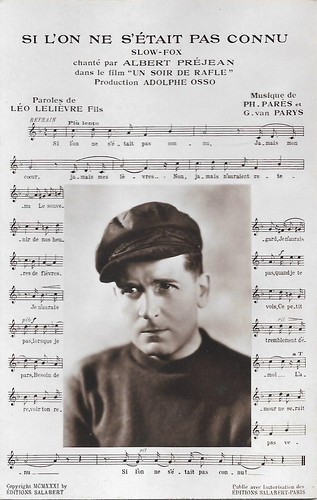
French postcard by P.C., Paris, no. 14. Photo: Films Osso. Albert Préjean sang the Slow-Fox 'Si l'on ne s'était pas connu' in Un soir de rafle (Carmine Gallone, 1931). Text by Léo Lelièvre fils, and music by Ph. Parès and G. van Parys. Copyright: Ed. Salabert, Paris, 1931.
Albert Préjean sings 'Si l'on ne s'était pas connu'. Source: Vieux Disques (YouTube).

French postcard by P-C, Paris, no. 16. Photo: Ufa. Lilian Harvey sings the Fox-Trot 'Je suis come ca' in La fille et le garcon (Roger Le Bon, Wilhelm Thiele, 1932), the alternate-language version of Zwei Herzen und ein Schlag (Wilhelm Thiele, 1932). Text by Jean Boyer, and music by Jean Gilbert. Copyright: Ufaton, Berlin / Ed. Salabert, Paris, 1932.
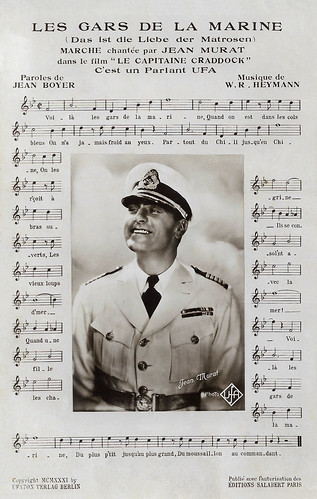
French postcard by Editions P-C, Paris, no. 17. Photo: Ufa. Jean Murat sang the march 'Les Gars de la marine' in Le Capitaine Craddock/Monte Carlo Madness (Hanns Schwarz, Max de Vaucorbeil, 1931). Text by Jean Boyer and music by Werner R. Heymann. Copyright: Ufaton Verlag, Berlin / Editions Salabert, Paris, in 1931. Sent by mail in 1932.
French actor Jean Murat (1888-1968) became a star as a handsome young soldier in silent films of the 1920s. The sound film allowed audiences to hear his beautiful deep voice. A success was the Paramount production Un Trou dans le Muir/The Hole In the Wall (René Barberis, 1930) with Dolly Davis, based on a play by Yves Mirande.
Even in his forties, Jean Murat retained the youthful leading man looks that had vaulted him to stardom. In 1931 he married Annabella . Together they starred in films like Paris-Méditerranée/Companion Wanted (Joe May, 1932), Mademoiselle Josette, ma femme/Miss Josette, My Wife (André Berthomieu, 1933) and L'équipage/Flight into Darkness (Anatole Litvak, 1935). He also appeared in such classic French films as La Kermesse Heroique (1935) and L'Eternal Retour (1943).
A fashionable and charming star of the German and French cinema
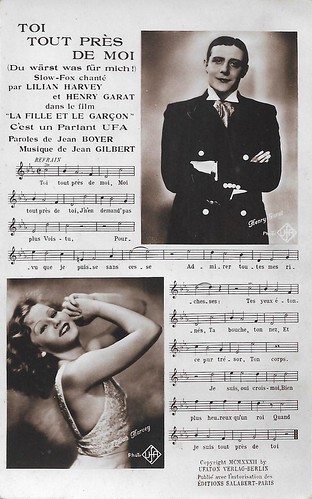
French postcard by P-C, Paris, no. 18. Photo: Ufa. Henri Garat and Lilian Harvey sang the Slow-Fox 'Toi tout près de moi' (Du wärst was für mich!) in La fille et le garcon (Roger le Bon, Wilhelm Thiele, 1932), an alternate-language version of Zwei Herzen und ein Schlag (Wilhelm Thiele, 1932). Text by Jean Boyer, and music by Jean Gilbert. Copyright: Ufaton Verlag, Berlin / Editions Salabert, Paris.
Henri Garat and Lilian Harvey sing 'Toi tout près de moi'. Source: hyppolite 1 (YouTube).

French postcard by Editions P-C, Paris, no. 19. Photo: Adolphe Osso / Gloria Film. Le Choer sang the military march 'Adieu, vieille Europe' in Le Sergent X/Sergeant X (Vladimir Strizhevsky, 1932).Text by Simon Delyon and music by René Mercier and Henri Forterre. Copyright: Editions Salabert, Paris, 1932.
Russian actor Ivan Mozzhukhin (in French Ivan Mosjoukine and in German Iwan Mosjukin) (1889-1939) was a legendary star of the European silent film, who shone in Russia, France, Germany and Austria, but suffered in Hollywood. Mozzhukhin continued to star in sound films like Le Sergent X/Sergeant X (Vladimir Strizhevsky, 1932), albeit with a smaller success.

French postcard by P-C, Paris, no. 25. Photo: Gaumont / Franco-Film / Aubert. Grazia Del Rio sang the 'valse musette' 'Les d'moisell's de Montparnasse' in La petite de Montparnasse/Die Mädels von Montparnasse (Hanns Schwarz, 1932). Text by Lucien Boyer, and music by F. Wachsmann. Copyright: Alrobi, Berlin/ Ed. Salabert, Paris.
Little is known about the personal life of Italian actress and singer Grazia Del Rio, but probably because of her singing voice and clear vocals she had a prolific career in the earliest years of sound cinema. Between 1930 and 1933 she had a short but intense film career in Italy and France, peaking with La stella del cinema (Mario Almirante, 1931) in which she starred herself.
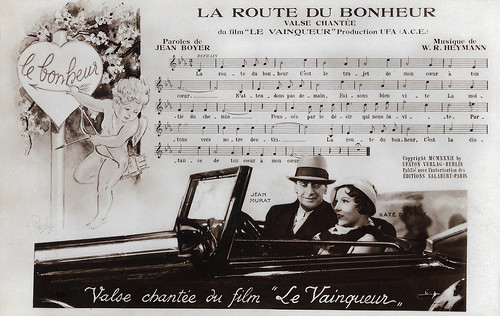
French postcard by Editions P-C, Paris, no. 29. Photo: Ufa (A.C.E.). Käthe von Nagy and Jean Murat sang the waltz 'Le route du bonheur' in Le Vainqueur/The Victor (Hans Hinrich, Paul Martin, 1932), an alternate-language version of Der Sieger (Hans Hinrich, Paul Martin, 1932) with Hans Albers in the role of Murat. 'Le route du bonheur' was a French version of the song 'Es führt kein andrer Weg zur Seligkeit'. Text by Jean Boyer and music by Werner R. Heymann. Copyright: Ufaton Verlag, Berlin / Editions Salabert, Paris, 1932.
Hungarian actress Käthe von Nagy (1904-1973) started as the ‘Backfish’ of German films of the late 1920s. In the early 1930s, she became a fashionable and charming star of the German and French cinema. To her successes of the 1930s belong Ihre Majestät die Liebe/Her Majesty Love (Joe May, 1930) with Franz Lederer , Meine Frau, die Hochstaplerin/My Wife, the Impostor (Kurt Gerron, 1931) opposite Heinz Rühmann , Ronny (Reinhold Schünzel, 1931), Ich bei Tag und Du bei Nacht/I by Day, You by Night (Ludwig Berger, 1932) opposite Willy Fritsch , Der Sieger/The Victor (Hans Hinrich, Paul Martin, 1932) with Hans Albers , and Das Schöne Abenteuer/Beautiful Adventure (Reinhold Schünzel, 1932).
Because of her multilingual education she was able to act in the French cinema too. As Kate de Nagy she became a star in France. To her French productions belong La Capitaine Craddock/Captain Craddock (Hanns Schwarz, Max de Vaucorbeil, 1931) with Jean Murat , La route impériale/The Imperial Road (Marcel L’Herbier, 1935) with Pierre Richard-Willm , and Cargaison blanche/Woman Racket (Robert Siodmak, 1937).
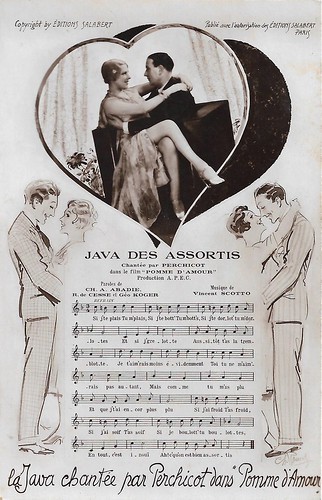
French postcard by P-C, Paris, no. 30. Photo: A.P.E.C. André Perchicot sings 'Java des assortis' in Pomme d'amour (Jean Dréville, 1932). Text by Ch. A. Abadie, R. de Cesse and Géo Koger, and music by Vincent Scotto. Copyright: Éditions Salabert, Paris.
André Perchicot or just Perchicot (1888-1950) was a professional cyclist and WWI pilot, who later became a singer and film actor. Perchicot acted in three feature films, as well as in a music clip: the German film Anny Music Hall (Carl Lamac, 1930) starring Anny Ondra , Pomme d'amour (Jean Dréville, 1932), the short À la Varenne (Jean Dréville, 1933) - an ancestor of the music video, and Sapho (Léonce Perret, 1934), staring Mary Marquet .
Perchicot sings Java des assortis. Source: lysgauty1 (YouTube).
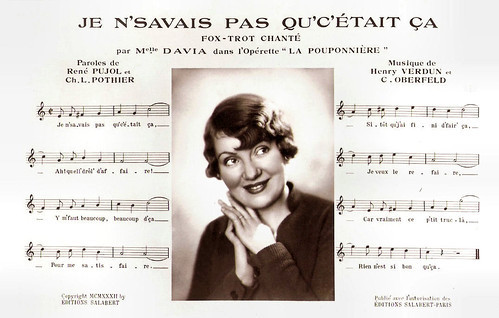
French postcard by Editions P-C, Paris, no. 32.Davia sang the Fox-trot 'Je n'savais pas qu'c'était ça' in La Pouponnière/The nursery (Jean Boyer, 1933). Text by René Pujol and Ch. L. Pothier, and music by Henry Verdun and C. Oberfeld. Copyright: Editions Salabert, Paris, 1932.
Davia (1898-1996) was a French singer and vaudeville actress who appeared between 1932 and 1966 in ten films. During the Roaring Twenties and until the Second World War, Davia had great success in operettas and musicals, particularly those by Albert Willemetz. After the introduction of sound film, she made her film debut in the musical Passionnément/Passionately (René Guissart, Louis Mercanton, 1932) with Florelle and Fernand Gravey .
Jean Boyer, who had written the script for this film then directed her in the film operetta La Pouponnière/The nursery (Jean Boyer, 1933), which was written by Albert Willemetz, and was produced by the French subsidiary of Paramount. She played another supporting role in the Paramount musical Simone est comme ça/Simone is like that (Karl Anton, 1933) with Meg Lemonnier and Henri Garat . She also played a role in the short comedy Quatre à Troyes/Four in Troyes (Pierre-Jean Ducis, 1934), and opposite Pauley and Saint-Granier in the comedy Un coup de rouge/A shot of red (Gaston Roudès, 1937).
No French studios had been converted for the sound film yet
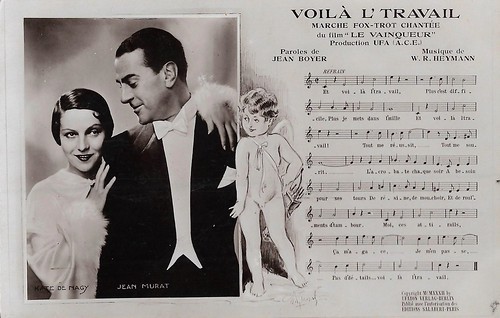
French postcard by P-C, Paris, no. 33. Photo: Ufa (ACE). Jean Murat and Käthe von Nagy sang the march-foxtrot 'Voilà l'travail' in Le Vainqueur (Hans Hinrich, Paul Martin, 1932), the alternate-language version of Der Sieger (Hans Hinrich, Paul Martin, 1932). Text: Jean Boyer, and music by W.R. Heymann. Copyright: Ufaton Verlag, Berlin / Ed. Salabert, Paris, 1932.
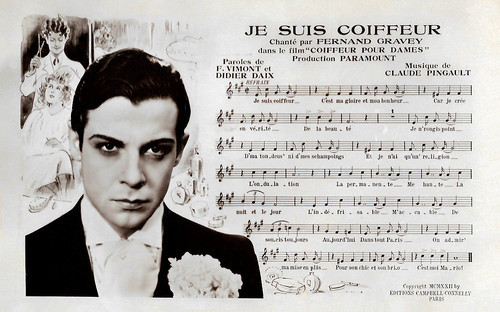
French postcard by P-C, Paris, no. 50. Photo: Paramount. Fernand Gravey performs the song 'Je suis coiffeur' in Coiffeur pour dames/Ladies Hairdresser (René Guissart, 1932. Text by F. Vimont and Didier Dax, and music by Claude Pingault. Copyright: Editions Campbell Connelly, Paris, 1932
Fernand Gravey (1905-1970) was an elegant Franco-Belgian stage, screen, and television actor, successfully working in Belgium, France, England, and Hollywood. Gravey’s debut in sound cinema came in 1930 with his role Armand Petitjean in L'amour chant (Robert Florey, 1930), one of several films at the Paris sound studio of Paramount. For years Gravey was the smiling, refined actor in boulevard comedies on the screen, often directed by René Guissart. His success in the French version of Ludwig Berger’s Ich bei Tag und du bei Nacht (1932) paved his way to London and later Hollywood.
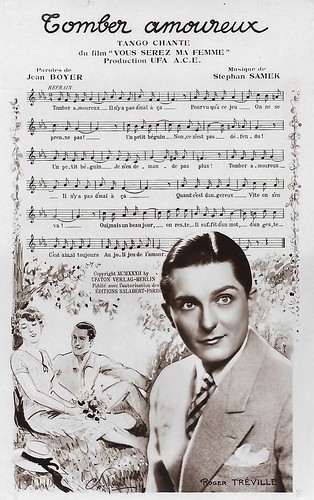
French postcard by P-C, Paris, no. 53. Photo: UFA/ ACE. Roger Tréville sang the tango 'Tomber amoureux' in Vous serez ma femme (Carl Boese, Serge de Poligny, 1932). Text by Jean Boure, and music by Stephan Samer. Copyright: Ufaton Verlag, Berlin / Ed. Salabert, Paris, 1932.
French singer and actor Roger Tréville (1902-2005) was a popular star of the early 1930s. Between 1908 and 1980 he appeared in more than fifty films and TV series in France but also in Great Britain, Germany, Italy, and the USA. He also appeared in silent films such as the Alphonse Daudet adaptation Jack (Robert Saidreau, 1925), but with his beautiful voice, he was perfect for the sound film. His breakthrough was the comedy The Parisian (Jean de Limur, 1930) with Adolphe Menjou and Elissa Landi . Among his films of the early 1930s were also Son altesse l’amour (Robert Péguy, Erich Schmidt, 1931) with Annabella , Enlevez-moi (Leonce Perret, 1932) with Arletty , Minuit, place Pigalle (Roger Richebé, 1934) with Raimu , and Parlez moi d’amour (René Guissart, 1935).
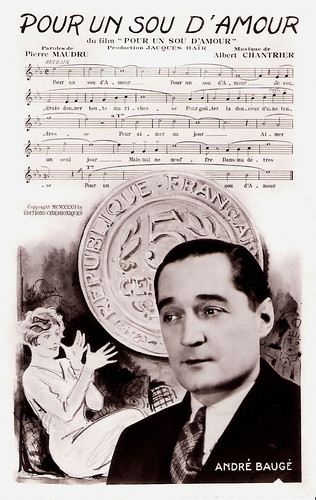
French postcard by P-C, Paris, no. 55. André Baugé sang the title song of Pour un sou d'amour (1932). Text by Pierre Maudru and music by Albert Chantrier. Copyright: Editions Cinéphoniques, 1932.
André Baugé (1893-1966) was a French baritone, active in opera and operetta. Baugé appeared in La Route est belle (Robert Florey, 1930), one of the first French sound films with music by Szulc. As no French studios had been converted for the sound film yet, it was shot at Elstree Studios in Britain. In Germany, he starred opposite Liane Haid and Willi Forst in Petit officier... Adieu! (Géza von Bolváry, 1930), an alternate-language version of the operetta Das Lied ist aus (Géza von Bolváry, 1930).
The next year, he had a supporting part in another example, Le petit café/The Little Cafe (Ludwig Berger, 1931), a French-language American Pre-Code musical film starring Maurice Chevalier . The film is an alternative language version of Playboy of Paris (Ludwig Berger, 1930). The film received a better reception from critics than the English-language version.
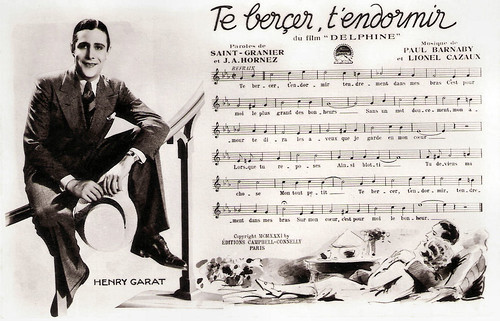
French postcard by P-C, Paris, no. 58. Henri Garat sang the title song of 'Delphine' (Roger Capellani, 1931). Text by Saint-Granier and J.A. Hornez, and music by Paul Barnaby and Lionel Cazaux. Copyright: Editions Campbell-Connelly, Paris, 1931.
The silver age of the operetta
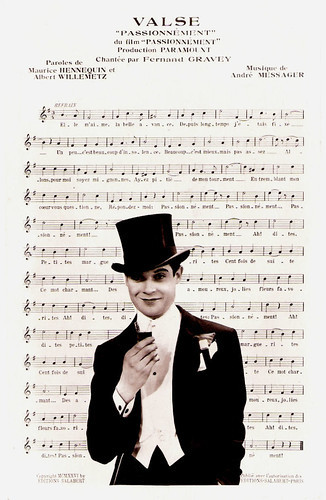
French postcard by P-C, Paris, no. 89. Photo: Paramount. Fernand Gravey sang the song 'Passionnément' in Passionnément/Passionately (René Guissart, Louis Mercanton, 1932). Text by Maurice Hennequin and Albert Willemetz, and music by André Messager. Copyright: Editions Salabert, Paris, 1926.

French postcard by Editions P-C, Paris, no. 108. Photo: Ufa. Márta Eggerth sings the Slow Fox 'C'est un amour qui passe' in C'est un amour qui passe (Geza von Bolvary, 1932), an alternate language version of Ein Lied, ein Kuß, ein Mädel/A Song, a Kiss, a Girl (Géza von Bolváry, 1932). Text by Jean Sorbier and music by Robert Stolz. Copyright: Alrobi, Berlin / Editions Salabert, Paris, 1932.
Hungarian-born singer and actress Márta Eggerth (1912-2013) maintained a global career for over 70 years. She was the popular and talented star of 30 German and Austrian operetta films of the 1930s. Many of the 20th century's most famous operetta composers, including Franz Lehár, Fritz Kreisler, Robert Stolz, Oscar Straus, and Paul Abraham, composed works especially for her. Her film career took off with the German sound film Bräutigamswitwe/Let's Love and Laugh (Richard Eichberg, 1931) co-starring Georg Alexander . The success of the film resulted in international fame.
Her German film debut was soon followed by more film operettas like Trara um Liebe/Trumpet Call of Love (Richard Eichberg, 1931) and Moderne Mitgift/Modern Dowry (E.W. Emo, 1932). Franz Léhar composed the music for Es war einmal ein Walzer/Once There Was a Waltz (Victor Janson, 1932), especially for Eggerth. In the silver age of the operetta Eggerth starred in numerous successful film operettas and musical comedies as the cheeky, captivating girl, but she also played more tragic roles. To her great successes belong Das Blaue vom Himmel/The Blue from the Sky (Victor Janson, 1932), Leise flehen meine Lieder/Lover Divine (Willi Forst, 1933), Unfinished Symphony (Anthony Asquith, Willi Forst, 1934), Der Zarewitsch (Victor Janson, 1933), and Die Czardasfürstin/The Csardas Princess (Georg Jacoby, 1934). Critics praised her musical abilities, but also her nuanced acting. After the rise of the Nazis, she continued her career with her partner Jan Kiepura in the US.
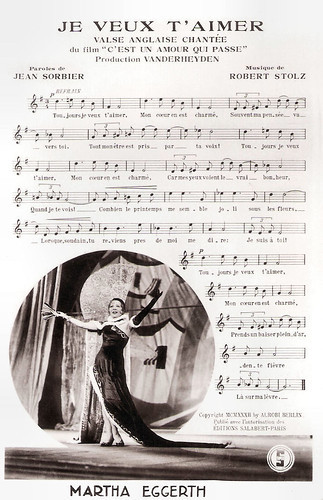
French postcard by Editions P-C, Paris, no. 113. Photo: Super Film / Vanderheyden. Márta Eggerth sang the English Waltz 'Je veux t'aimer' in C'est un amour qui passe, the French language version of Ein Lied, ein Kuß, ein Mädel/A Song, a Kiss, a Girl (Géza von Bolváry, 1932).Text by Jean Sorbier and music by Robert Stolz. Copyright: Alrobi, Berlin / Editions Salabert, Paris, 1932.
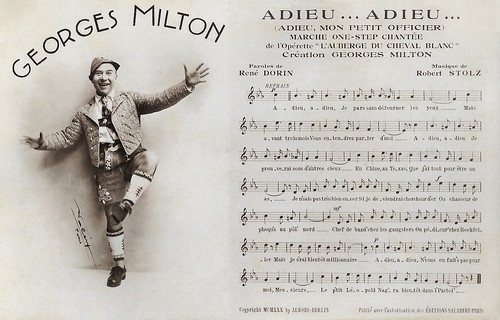
French postcard by Editions P-C, Paris, no. 114. Photo: Walery, Paris. Georges Milton sang the one-step march 'Adieu... Adieu...' (Adieu, mon petit officier) in the stage operetta 'L'auberge du cheval blanc' (The White Horse Inn). Text by René Dorin and music by Robert Stolz (music). Copyright: Alrobi, Berlin / Editions Salabert, Paris, in 1930.
Georges Milton (1886-1970) was a French singer and actor. With his daring, merry songs Milton expressed the atmosphere of the French roaring twenties. He peaked in the French cinema of the 1930s as the character Bouboule. The postcard was for a song in a stage operetta in which he appeared. The film operetta was in the mid-1930s at its return and P-C soon stopped making Sing-Along cards.
Georges Milton sings 'Adieu... Adieu...'. Source: jonjamg (YouTube).

French postcard by P-C, Paris, no. 1. Photo: Paramount. Henri Garat sang the song 'En parlant un peu de Paris' in Il est charmant/He Is Charming (Louis Mercanton, 1932). Text by Albert Willemetz and music by Raoul Moretti. Copyright: Editions Salabert, Paris, 1932.
‘Beau garcon’ Henri Garat (1902-1959) was a popular singer and leading man in light romances during the 1930s. In 1930 he made his first film for the Ufa, Flagrant délit/Burglars (Hanns Schwarz, Georges Tréville, 1930). He replaced Willy Fritsch in the French adaptation of the popular German film operetta Die Drei von der Tankstelle (1930) starring Lilian Harvey and the result, Le chemin du Paradis/The Road to Paradise (Wilhelm Thiele, Max de Vaucorbeil, 1930) was a huge success and made Garat a 'grand vedette' in France.
He replaced Fritsch again in the French but also in the English versions of Der Kongress Tanzt (1931): Le congrès s'amuse (Erik Charell, Jean Boyer, 1931) and Congress Dances (Erik Charell, Jean Boyer, 1931), both with Lilian Harvey . Other films with Harvey were La fille et le garçon/The Girl and the Boy (Roger Le Bon, Wilhelm Thiele, 1931), Princesse, à vos ordres/Adorable (Hanns Schwarz, Max de Vaucorbeil, 1931) and Un rêve blond/Happy Ever After (André Daven, Paul Martin, 1932) based on a script by Walter Reisch and Billy Wilder. His songs in these films became huge hits.

French postcard by P-C, Paris, no. 4. Photo: Paramount. Meg Lemonnier sang the waltz 'Il est charmant' in Il est charmant/He is Charming (Louis Mercanton, 1932), also with Henri Garat . Text by Albert Willemetz, and music by Raoul Moretti. Copyright: Editions Salabert, Paris, 1932.
French actress and singer Meg Lemonnier (1905-1988) was most active in the French cinema of the 1930s. In the early days of the talking pictures, she made her film debut in Mon gosse de père/My Kid of a Father (Jean de Limur, 1930). It was an alternate language version of The Parisian (Jean de Limur, 1931), both featuring Hollywood star Adolphe Menjou .
In the following years, Lemonnier nicely played more or less saucy ingénues in romantic comedies and film operettas. She accompanied the popular jeune premier Henri Garat in many of his successes produced by Paramount, such as the filmed versions of Il est charmant/He is Charming (Louis Mercanton, 1932) and Un soir de réveillon/Christmas Eve (Karl Anton, 1933). Lemmonier sang the hit 'Être une poule' (Being a Tart) in Un soir de réveillon.
Meg Lemonnier sings 'Il est charmant' in Il est charmant/He is Charming (Louis Mercanton, 1932). Source:
Jozef Sterkens (YouTube).

French postcard by P-C, Paris, no. 7. Photo: Paramount. Dranem sings the foxtrot 'J'en suis un' in the operetta film Il est Charmant/He Is Charming (Louis Mercanton, 1932). Words by Albert Willemetz and music by Raoul Moretti. Copyright: Editions Salabert, Paris, 1932.
Dranem (1869-1935) was a French comic singer, music hall, stage, and film actor. He already appeared in Pathé shorts in the early 1900s. The advent of sound film in the late 1920s made Dranem again much in demand for screen roles. In the early 1930s, he played in some 13 films, from which several with himself in the lead, such as La poule/The Hen (1932), and Ah! Quelle gare!/Ah! What a girl! (1933), or at least as the main male antagonist.

French postcard by P-C, Paris, no. 8. Photo: Nalpas. Bach sang the song 'On n' m' a pas' (a 6/8 One-Step) in L'affaire Blaireau (Henry Wulschleger, 1932). Text by Ch. L. Pothier and René Pujol, and music by C. Oberfeld. Copyright: Editions Salabert, Paris, 1931.
Bach (1882-1953) was a popular French actor, singer, and music hall performer. He starred in early sound comedies like Une grave erreur/A serious mistake (Joe Francis, 1930) and Le tampon du capiston/The capiston tampon (Joe Francis, Jean Toulout, 1930). In the following years, he appeared in such Comique Troupiers (coarse comedies) as En bordée/Bordered (Joe Francis, Henry Wulschleger, 1931), L'affaire Blaireau/The Blaireau Case (Henry Wulschleger, 1932), and Le champion du régiment/The Regiment's Champion (Henry Wulschleger, 1932) with Josette Day . He co-starred with Georges Tréville and Charles Montel in L'enfant de ma soeur/My sister's child (Henry Wulschleger, 1933) and Bach millionnaire/Bach the Millionaire (Henry Wulschleger, 1933).

French postcard by Editions P-C, Paris, no. 9. Photo: Ufa. Henri Garat sang the waltz 'Ville d'amour' in Le congrès s'amuse/The Congress Dances (Jean Boyer, Erik Charell, 1931), an alternate language version of Der Kongreß tanzt (Erik Charell, 1931) and The Congress Dances (Erik Charell, 1932). Multiple-language versions were common in the years following the introduction of sound film, before the practice of dubbing became widespread. In the German version, Willy Fritsch played Garat's role, and sang the song 'Das muss ein Stück vom Himmel sein!' Text by Jean Boyer and music by Werner R. Heymann. Copyright: Ufaton Verlag, Berlin / Editions Salabert, Paris, 1931.
Together Harvey and Fritsch would make eleven box office hits

French postcard by Editions P-C, Paris, no. 10. Photo: Ufa (Alliance Cinématographique Européenne). Lilian Harvey the Fox-trot 'Serait-ce un rêve?' in Le congrès s'amuse/The Congress Dances (Jean Boyer, Erik Charell, 1931), the alternate language version of Der Kongreß tanzt (Erik Charell, 1931) and The Congress Dances (Erik Charell, 1932). Text by Jean Boyer and music by Werner R. Heymann. Copyright: Ufaton Verlag, Berlin / Editions Salabert, Paris, 1931.
British born, German actress and singer Lilian Harvey (1906-1968) was Ufa's biggest star of the 1930s. Because of her training as a singer and a dancer, Ufa found a great use for her in light operettas. In the hit Liebeswalzer/The Love Waltz (Wilhelm Thiele, 1930) she starred with 'sunny boy' Willy Fritsch , and they became the 'dream couple' of the German cinema. Together Harvey and Fritsch would make eleven box office hits, including Hokuspokus/Hocuspocus (Gustav Ucicky, 1930), Die Drei von der Tankstelle/Three Good Friends (Wilhelm Thiele, 1930), and Ein blonder Traum/A Blonde Dream (Paul Martin, 1932). Their best film was the immensely popular film operetta Der Kongress tanzt/The Congress Dances (Erik Charell, 1931).

French postcard by P-C, Paris, no. 13. Photo: Films Osso. Albert Préjean sang the song 'Dans tous les ports du monde' (a 6/8 one step) in Le chant du marin/Sailor's Song (Carmine Gallone, 1932). Text by Serge Veber, and music by Georges van Parys. Copyright: Editions Salabert, Paris, 1931.
French actor and singer Albert Préjean (1894-1979) was a former WWI flying ace. He is best known for playing heroes in the silent films of René Clair, jeunes premiers in French early sound musicals, and for playing George Siménon's detective Maigret. In their his first sound feature, Sous Les Toits de Paris (René Clair, 1930), Préjean played the street performer Albert who leads the assembly line in singing the film's title song. Préjean went on to play singing working class heroes in L'Opéra de Quat'Sous (G.W. Pabst, 1931), Un soir de rafle (Carmine Gallone, 1931), the operetta Dédé (René Guissart, 1934), L'Or dans la rue (Curtis Bernhardt, 1934) and with Joséphine Baker in Princesse Tam-Tam (Edmond T. Gréville, 1935).

French postcard by P.C., Paris, no. 14. Photo: Films Osso. Albert Préjean sang the Slow-Fox 'Si l'on ne s'était pas connu' in Un soir de rafle (Carmine Gallone, 1931). Text by Léo Lelièvre fils, and music by Ph. Parès and G. van Parys. Copyright: Ed. Salabert, Paris, 1931.
Albert Préjean sings 'Si l'on ne s'était pas connu'. Source: Vieux Disques (YouTube).

French postcard by P-C, Paris, no. 16. Photo: Ufa. Lilian Harvey sings the Fox-Trot 'Je suis come ca' in La fille et le garcon (Roger Le Bon, Wilhelm Thiele, 1932), the alternate-language version of Zwei Herzen und ein Schlag (Wilhelm Thiele, 1932). Text by Jean Boyer, and music by Jean Gilbert. Copyright: Ufaton, Berlin / Ed. Salabert, Paris, 1932.

French postcard by Editions P-C, Paris, no. 17. Photo: Ufa. Jean Murat sang the march 'Les Gars de la marine' in Le Capitaine Craddock/Monte Carlo Madness (Hanns Schwarz, Max de Vaucorbeil, 1931). Text by Jean Boyer and music by Werner R. Heymann. Copyright: Ufaton Verlag, Berlin / Editions Salabert, Paris, in 1931. Sent by mail in 1932.
French actor Jean Murat (1888-1968) became a star as a handsome young soldier in silent films of the 1920s. The sound film allowed audiences to hear his beautiful deep voice. A success was the Paramount production Un Trou dans le Muir/The Hole In the Wall (René Barberis, 1930) with Dolly Davis, based on a play by Yves Mirande.
Even in his forties, Jean Murat retained the youthful leading man looks that had vaulted him to stardom. In 1931 he married Annabella . Together they starred in films like Paris-Méditerranée/Companion Wanted (Joe May, 1932), Mademoiselle Josette, ma femme/Miss Josette, My Wife (André Berthomieu, 1933) and L'équipage/Flight into Darkness (Anatole Litvak, 1935). He also appeared in such classic French films as La Kermesse Heroique (1935) and L'Eternal Retour (1943).
A fashionable and charming star of the German and French cinema

French postcard by P-C, Paris, no. 18. Photo: Ufa. Henri Garat and Lilian Harvey sang the Slow-Fox 'Toi tout près de moi' (Du wärst was für mich!) in La fille et le garcon (Roger le Bon, Wilhelm Thiele, 1932), an alternate-language version of Zwei Herzen und ein Schlag (Wilhelm Thiele, 1932). Text by Jean Boyer, and music by Jean Gilbert. Copyright: Ufaton Verlag, Berlin / Editions Salabert, Paris.
Henri Garat and Lilian Harvey sing 'Toi tout près de moi'. Source: hyppolite 1 (YouTube).

French postcard by Editions P-C, Paris, no. 19. Photo: Adolphe Osso / Gloria Film. Le Choer sang the military march 'Adieu, vieille Europe' in Le Sergent X/Sergeant X (Vladimir Strizhevsky, 1932).Text by Simon Delyon and music by René Mercier and Henri Forterre. Copyright: Editions Salabert, Paris, 1932.
Russian actor Ivan Mozzhukhin (in French Ivan Mosjoukine and in German Iwan Mosjukin) (1889-1939) was a legendary star of the European silent film, who shone in Russia, France, Germany and Austria, but suffered in Hollywood. Mozzhukhin continued to star in sound films like Le Sergent X/Sergeant X (Vladimir Strizhevsky, 1932), albeit with a smaller success.

French postcard by P-C, Paris, no. 25. Photo: Gaumont / Franco-Film / Aubert. Grazia Del Rio sang the 'valse musette' 'Les d'moisell's de Montparnasse' in La petite de Montparnasse/Die Mädels von Montparnasse (Hanns Schwarz, 1932). Text by Lucien Boyer, and music by F. Wachsmann. Copyright: Alrobi, Berlin/ Ed. Salabert, Paris.
Little is known about the personal life of Italian actress and singer Grazia Del Rio, but probably because of her singing voice and clear vocals she had a prolific career in the earliest years of sound cinema. Between 1930 and 1933 she had a short but intense film career in Italy and France, peaking with La stella del cinema (Mario Almirante, 1931) in which she starred herself.

French postcard by Editions P-C, Paris, no. 29. Photo: Ufa (A.C.E.). Käthe von Nagy and Jean Murat sang the waltz 'Le route du bonheur' in Le Vainqueur/The Victor (Hans Hinrich, Paul Martin, 1932), an alternate-language version of Der Sieger (Hans Hinrich, Paul Martin, 1932) with Hans Albers in the role of Murat. 'Le route du bonheur' was a French version of the song 'Es führt kein andrer Weg zur Seligkeit'. Text by Jean Boyer and music by Werner R. Heymann. Copyright: Ufaton Verlag, Berlin / Editions Salabert, Paris, 1932.
Hungarian actress Käthe von Nagy (1904-1973) started as the ‘Backfish’ of German films of the late 1920s. In the early 1930s, she became a fashionable and charming star of the German and French cinema. To her successes of the 1930s belong Ihre Majestät die Liebe/Her Majesty Love (Joe May, 1930) with Franz Lederer , Meine Frau, die Hochstaplerin/My Wife, the Impostor (Kurt Gerron, 1931) opposite Heinz Rühmann , Ronny (Reinhold Schünzel, 1931), Ich bei Tag und Du bei Nacht/I by Day, You by Night (Ludwig Berger, 1932) opposite Willy Fritsch , Der Sieger/The Victor (Hans Hinrich, Paul Martin, 1932) with Hans Albers , and Das Schöne Abenteuer/Beautiful Adventure (Reinhold Schünzel, 1932).
Because of her multilingual education she was able to act in the French cinema too. As Kate de Nagy she became a star in France. To her French productions belong La Capitaine Craddock/Captain Craddock (Hanns Schwarz, Max de Vaucorbeil, 1931) with Jean Murat , La route impériale/The Imperial Road (Marcel L’Herbier, 1935) with Pierre Richard-Willm , and Cargaison blanche/Woman Racket (Robert Siodmak, 1937).

French postcard by P-C, Paris, no. 30. Photo: A.P.E.C. André Perchicot sings 'Java des assortis' in Pomme d'amour (Jean Dréville, 1932). Text by Ch. A. Abadie, R. de Cesse and Géo Koger, and music by Vincent Scotto. Copyright: Éditions Salabert, Paris.
André Perchicot or just Perchicot (1888-1950) was a professional cyclist and WWI pilot, who later became a singer and film actor. Perchicot acted in three feature films, as well as in a music clip: the German film Anny Music Hall (Carl Lamac, 1930) starring Anny Ondra , Pomme d'amour (Jean Dréville, 1932), the short À la Varenne (Jean Dréville, 1933) - an ancestor of the music video, and Sapho (Léonce Perret, 1934), staring Mary Marquet .
Perchicot sings Java des assortis. Source: lysgauty1 (YouTube).

French postcard by Editions P-C, Paris, no. 32.Davia sang the Fox-trot 'Je n'savais pas qu'c'était ça' in La Pouponnière/The nursery (Jean Boyer, 1933). Text by René Pujol and Ch. L. Pothier, and music by Henry Verdun and C. Oberfeld. Copyright: Editions Salabert, Paris, 1932.
Davia (1898-1996) was a French singer and vaudeville actress who appeared between 1932 and 1966 in ten films. During the Roaring Twenties and until the Second World War, Davia had great success in operettas and musicals, particularly those by Albert Willemetz. After the introduction of sound film, she made her film debut in the musical Passionnément/Passionately (René Guissart, Louis Mercanton, 1932) with Florelle and Fernand Gravey .
Jean Boyer, who had written the script for this film then directed her in the film operetta La Pouponnière/The nursery (Jean Boyer, 1933), which was written by Albert Willemetz, and was produced by the French subsidiary of Paramount. She played another supporting role in the Paramount musical Simone est comme ça/Simone is like that (Karl Anton, 1933) with Meg Lemonnier and Henri Garat . She also played a role in the short comedy Quatre à Troyes/Four in Troyes (Pierre-Jean Ducis, 1934), and opposite Pauley and Saint-Granier in the comedy Un coup de rouge/A shot of red (Gaston Roudès, 1937).
No French studios had been converted for the sound film yet

French postcard by P-C, Paris, no. 33. Photo: Ufa (ACE). Jean Murat and Käthe von Nagy sang the march-foxtrot 'Voilà l'travail' in Le Vainqueur (Hans Hinrich, Paul Martin, 1932), the alternate-language version of Der Sieger (Hans Hinrich, Paul Martin, 1932). Text: Jean Boyer, and music by W.R. Heymann. Copyright: Ufaton Verlag, Berlin / Ed. Salabert, Paris, 1932.

French postcard by P-C, Paris, no. 50. Photo: Paramount. Fernand Gravey performs the song 'Je suis coiffeur' in Coiffeur pour dames/Ladies Hairdresser (René Guissart, 1932. Text by F. Vimont and Didier Dax, and music by Claude Pingault. Copyright: Editions Campbell Connelly, Paris, 1932
Fernand Gravey (1905-1970) was an elegant Franco-Belgian stage, screen, and television actor, successfully working in Belgium, France, England, and Hollywood. Gravey’s debut in sound cinema came in 1930 with his role Armand Petitjean in L'amour chant (Robert Florey, 1930), one of several films at the Paris sound studio of Paramount. For years Gravey was the smiling, refined actor in boulevard comedies on the screen, often directed by René Guissart. His success in the French version of Ludwig Berger’s Ich bei Tag und du bei Nacht (1932) paved his way to London and later Hollywood.

French postcard by P-C, Paris, no. 53. Photo: UFA/ ACE. Roger Tréville sang the tango 'Tomber amoureux' in Vous serez ma femme (Carl Boese, Serge de Poligny, 1932). Text by Jean Boure, and music by Stephan Samer. Copyright: Ufaton Verlag, Berlin / Ed. Salabert, Paris, 1932.
French singer and actor Roger Tréville (1902-2005) was a popular star of the early 1930s. Between 1908 and 1980 he appeared in more than fifty films and TV series in France but also in Great Britain, Germany, Italy, and the USA. He also appeared in silent films such as the Alphonse Daudet adaptation Jack (Robert Saidreau, 1925), but with his beautiful voice, he was perfect for the sound film. His breakthrough was the comedy The Parisian (Jean de Limur, 1930) with Adolphe Menjou and Elissa Landi . Among his films of the early 1930s were also Son altesse l’amour (Robert Péguy, Erich Schmidt, 1931) with Annabella , Enlevez-moi (Leonce Perret, 1932) with Arletty , Minuit, place Pigalle (Roger Richebé, 1934) with Raimu , and Parlez moi d’amour (René Guissart, 1935).

French postcard by P-C, Paris, no. 55. André Baugé sang the title song of Pour un sou d'amour (1932). Text by Pierre Maudru and music by Albert Chantrier. Copyright: Editions Cinéphoniques, 1932.
André Baugé (1893-1966) was a French baritone, active in opera and operetta. Baugé appeared in La Route est belle (Robert Florey, 1930), one of the first French sound films with music by Szulc. As no French studios had been converted for the sound film yet, it was shot at Elstree Studios in Britain. In Germany, he starred opposite Liane Haid and Willi Forst in Petit officier... Adieu! (Géza von Bolváry, 1930), an alternate-language version of the operetta Das Lied ist aus (Géza von Bolváry, 1930).
The next year, he had a supporting part in another example, Le petit café/The Little Cafe (Ludwig Berger, 1931), a French-language American Pre-Code musical film starring Maurice Chevalier . The film is an alternative language version of Playboy of Paris (Ludwig Berger, 1930). The film received a better reception from critics than the English-language version.

French postcard by P-C, Paris, no. 58. Henri Garat sang the title song of 'Delphine' (Roger Capellani, 1931). Text by Saint-Granier and J.A. Hornez, and music by Paul Barnaby and Lionel Cazaux. Copyright: Editions Campbell-Connelly, Paris, 1931.
The silver age of the operetta

French postcard by P-C, Paris, no. 89. Photo: Paramount. Fernand Gravey sang the song 'Passionnément' in Passionnément/Passionately (René Guissart, Louis Mercanton, 1932). Text by Maurice Hennequin and Albert Willemetz, and music by André Messager. Copyright: Editions Salabert, Paris, 1926.

French postcard by Editions P-C, Paris, no. 108. Photo: Ufa. Márta Eggerth sings the Slow Fox 'C'est un amour qui passe' in C'est un amour qui passe (Geza von Bolvary, 1932), an alternate language version of Ein Lied, ein Kuß, ein Mädel/A Song, a Kiss, a Girl (Géza von Bolváry, 1932). Text by Jean Sorbier and music by Robert Stolz. Copyright: Alrobi, Berlin / Editions Salabert, Paris, 1932.
Hungarian-born singer and actress Márta Eggerth (1912-2013) maintained a global career for over 70 years. She was the popular and talented star of 30 German and Austrian operetta films of the 1930s. Many of the 20th century's most famous operetta composers, including Franz Lehár, Fritz Kreisler, Robert Stolz, Oscar Straus, and Paul Abraham, composed works especially for her. Her film career took off with the German sound film Bräutigamswitwe/Let's Love and Laugh (Richard Eichberg, 1931) co-starring Georg Alexander . The success of the film resulted in international fame.
Her German film debut was soon followed by more film operettas like Trara um Liebe/Trumpet Call of Love (Richard Eichberg, 1931) and Moderne Mitgift/Modern Dowry (E.W. Emo, 1932). Franz Léhar composed the music for Es war einmal ein Walzer/Once There Was a Waltz (Victor Janson, 1932), especially for Eggerth. In the silver age of the operetta Eggerth starred in numerous successful film operettas and musical comedies as the cheeky, captivating girl, but she also played more tragic roles. To her great successes belong Das Blaue vom Himmel/The Blue from the Sky (Victor Janson, 1932), Leise flehen meine Lieder/Lover Divine (Willi Forst, 1933), Unfinished Symphony (Anthony Asquith, Willi Forst, 1934), Der Zarewitsch (Victor Janson, 1933), and Die Czardasfürstin/The Csardas Princess (Georg Jacoby, 1934). Critics praised her musical abilities, but also her nuanced acting. After the rise of the Nazis, she continued her career with her partner Jan Kiepura in the US.

French postcard by Editions P-C, Paris, no. 113. Photo: Super Film / Vanderheyden. Márta Eggerth sang the English Waltz 'Je veux t'aimer' in C'est un amour qui passe, the French language version of Ein Lied, ein Kuß, ein Mädel/A Song, a Kiss, a Girl (Géza von Bolváry, 1932).Text by Jean Sorbier and music by Robert Stolz. Copyright: Alrobi, Berlin / Editions Salabert, Paris, 1932.

French postcard by Editions P-C, Paris, no. 114. Photo: Walery, Paris. Georges Milton sang the one-step march 'Adieu... Adieu...' (Adieu, mon petit officier) in the stage operetta 'L'auberge du cheval blanc' (The White Horse Inn). Text by René Dorin and music by Robert Stolz (music). Copyright: Alrobi, Berlin / Editions Salabert, Paris, in 1930.
Georges Milton (1886-1970) was a French singer and actor. With his daring, merry songs Milton expressed the atmosphere of the French roaring twenties. He peaked in the French cinema of the 1930s as the character Bouboule. The postcard was for a song in a stage operetta in which he appeared. The film operetta was in the mid-1930s at its return and P-C soon stopped making Sing-Along cards.
Georges Milton sings 'Adieu... Adieu...'. Source: jonjamg (YouTube).
Published on September 16, 2020 22:00
September 15, 2020
Michela Belmonte
Michela Belmonte (1925-1978) was an Italian film actress of the Fascist era and the younger sister of film star Maria Denis. She was discovered by Roberto Rosselini, but after only three films, she left the film business.
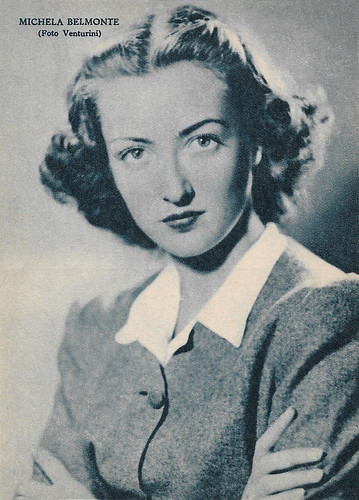
Italian postcard by Rizzoli & C., Milano, 1942. Photo: Venturini.
[image error]
Italian postcard by ASER (A. Scarmiglia Edizioni Roma), no. 112. Photo: Dinami e Malandrino.
To Rome to try to get into the film
Michela Belmonte was the stage name of Michela Beomonte, who was born on Padoa in 1925.
After attending secondary school, Belmonte moved to Rome to try to get into the film.
She was noticed by Roberto Rossellini who hired for a small part opposite Massimo Girotti in Un pilota ritorna/A Pilot returns (Roberto Rossellini, 1942). The film forms part of Rossellini's 'Fascist trilogy' along with La nave bianca/The White Ship (1941) and L'uomo dalla croce/The Man with a Cross (1943). It was made with the co-operation of the Italian Air Force
Yet, this part was impressive enough for Mario Mattoli to let her play one of the protagonists of the war drama I tre aquilotti/The Three Pilots (Mario Mattoli, 1942) with Leonardo Cortese , Carlo Minello and Alberto Sordi . It was shot at the Cinecittà Studios in Rome and at the Accademia Aeronautica in Caserta.
In 1943 she made her third and final film, the comedy Il nostro prossimo/Our Neighbour (Gherardo Gherardi, Giuseppe Aldo Rossi, 1943), and with Belmonte starring alongside Antonio Gandusio , Maurizio D'Ancora, Rina Morelli and Paolo Stoppa .
Following the overthrow of Benito Mussolini's regime in 1943, she retired from acting. In her later career, she focused on literature and archeology.
Michela Belmonte passed away in Alicante in Spain in 1978. She was only 52.
[image error]
Italian postcard by ASER (A. Scarmiglia Edizioni Roma), no. 154.
[image error]
Italian postcard by ASER (A. Scarmiglia Edizoni Roma), no. 213. Photo: Ciolfi. Michela Belmonte and Leonardo Cortese in I tre aquilotti/The Three Pilots (Mario Mattoli, 1942).
[image error]
Italian postcard by B.F.F. Edit. (Casa Editr. Ballerini & Fratini, Firenze), no. 2006. Photo: Venturini, Roma.
Sources: Wikipedia (Italian and English) and .

Italian postcard by Rizzoli & C., Milano, 1942. Photo: Venturini.
[image error]
Italian postcard by ASER (A. Scarmiglia Edizioni Roma), no. 112. Photo: Dinami e Malandrino.
To Rome to try to get into the film
Michela Belmonte was the stage name of Michela Beomonte, who was born on Padoa in 1925.
After attending secondary school, Belmonte moved to Rome to try to get into the film.
She was noticed by Roberto Rossellini who hired for a small part opposite Massimo Girotti in Un pilota ritorna/A Pilot returns (Roberto Rossellini, 1942). The film forms part of Rossellini's 'Fascist trilogy' along with La nave bianca/The White Ship (1941) and L'uomo dalla croce/The Man with a Cross (1943). It was made with the co-operation of the Italian Air Force
Yet, this part was impressive enough for Mario Mattoli to let her play one of the protagonists of the war drama I tre aquilotti/The Three Pilots (Mario Mattoli, 1942) with Leonardo Cortese , Carlo Minello and Alberto Sordi . It was shot at the Cinecittà Studios in Rome and at the Accademia Aeronautica in Caserta.
In 1943 she made her third and final film, the comedy Il nostro prossimo/Our Neighbour (Gherardo Gherardi, Giuseppe Aldo Rossi, 1943), and with Belmonte starring alongside Antonio Gandusio , Maurizio D'Ancora, Rina Morelli and Paolo Stoppa .
Following the overthrow of Benito Mussolini's regime in 1943, she retired from acting. In her later career, she focused on literature and archeology.
Michela Belmonte passed away in Alicante in Spain in 1978. She was only 52.
[image error]
Italian postcard by ASER (A. Scarmiglia Edizioni Roma), no. 154.
[image error]
Italian postcard by ASER (A. Scarmiglia Edizoni Roma), no. 213. Photo: Ciolfi. Michela Belmonte and Leonardo Cortese in I tre aquilotti/The Three Pilots (Mario Mattoli, 1942).
[image error]
Italian postcard by B.F.F. Edit. (Casa Editr. Ballerini & Fratini, Firenze), no. 2006. Photo: Venturini, Roma.
Sources: Wikipedia (Italian and English) and .
Published on September 15, 2020 22:00
September 14, 2020
The Way of All Flesh (1927)
The Way of All Flesh (Victor Fleming, 1927) is one of the famous lost films. Only a fragment of 8,5 minutes of the film has turned up. One of the assets of the film was the powerful performance of German actor Emil Jannings. It was his first Hollywood film and his portrayal is reminiscent of his characters in his previous German films, Der letzte Mann/The Last Laugh (F.W. Murnau, 1924) and Variété/Variety (E.A. Dupont, 1925). Jannings won the first Academy Award as Best Actor for his roles in both The Way of All Flesh (1927) and The Last Command (Ernst Lubitsch, 1928).
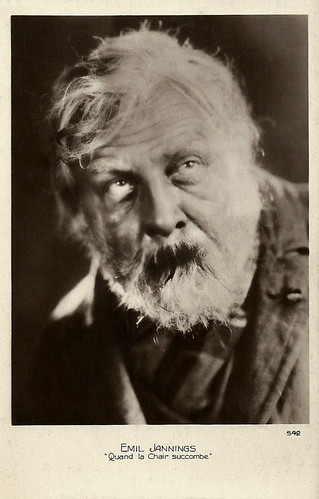
French postcard by Editions Cinémagazine, no. 542. Photo: Emil Jannings in Quand la Chair succombe/The Way of All Flesh (Victor Fleming, 1927).
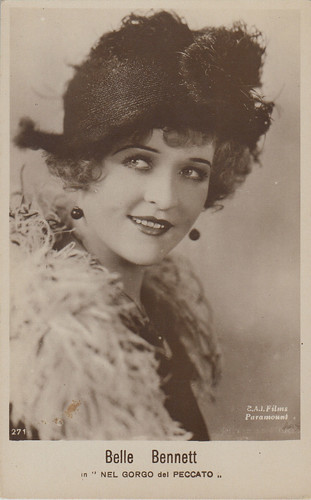
Italian postcard by G.B. Falci, Milano, no. 271. Photo: Paramount. This is Phyllis Haver, not Belle Bennett. This portrait is from the film Nel gorgo del peccato/The Way of All Flesh (Victor Fleming, 1927) in which the two actresses starred together. Collection: Marlene Pilaete.
The old tramp in the Christmas snowstorm
The Way of All Flesh (Victor Fleming, 1927) is based on a story by Perley Poore Sheehan, adapted by Lajos Biró. The film opens in the early 1900s. Emil Jannings plays August Schiller, a bank clerk in Milwaukee who is happy with both his job and with his dear wife Belle Bennett and their six children.
But when bank officials ask him to transport $1,000 in securities to Chicago, he meets on the train a bleached blonde seductress (Phyllis Haver), who catches a glimpse of what he is carrying. She flirts with him, convinces him to buy her a bottle of champagne, and takes him to a saloon run by a crook (Fred Kohler).
The next morning he awakes alone in a dilapidated bedroom, without the money. He finds the woman, and at first pleads with her, then intimidates her to return the stolen securities. He is knocked unconscious by the saloon owner and dragged to a nearby railroad track.
As the crook strips him of everything that might lead to his identification, Schiller recovers consciousness, and in a struggle, the crook falls on the path of an oncoming train and is killed. The desperate Schiller flees and wants to take his own life. Then he reads in a newspaper that he is supposedly dead, the crook's mangled body having been identified as Schiller's. Jannings decides to go along with the story to spare his family embarrassment and scandal.
The time passes to twenty years later. Schiller is aged and unkempt, employed to pick up trash in a park. He sees his own family go to a cemetery and place a wreath on his grave. Later in a Christmas snowstorm, Schiller makes his way to his former home. He sees that the son (Donald Keith) whom he had taught to play the violin is now a successful musician. He walks away, carrying in his pocket a dollar that his son has given him, not recognising that the old tramp is his father.
In 1940, the film was remade by Paramount as The Way of All Flesh (Louis King, 1940) with Akim Tamiroff, Gladys George, and Muriel Angelus.
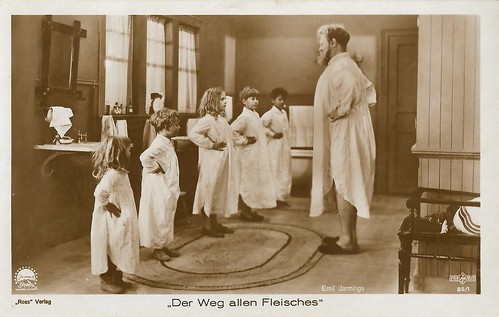
German postcard by Ross Verlag, no. 85/1. Photo: Parufamet. Emil Jannings in The Way of All Flesh (Victor Fleming, 1927).
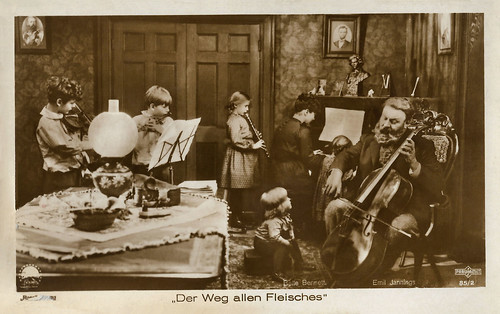
German postcard by Ross Verlag, no. 85/2. Photo: Parufamet. Belle Bennett and Emil Jannings in The Way of All Flesh (Victor Fleming, 1927).
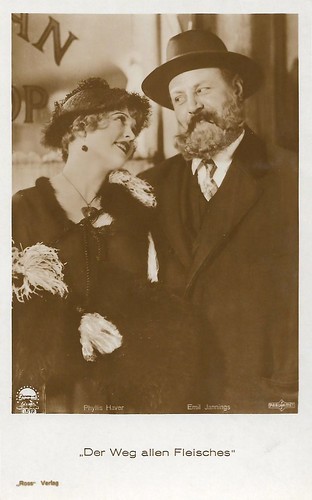
German postcard by Ross Verlag, no. 85/3. Photo: Parufamet. Emil Jannings and Phyllis Haver in The Way of All Flesh (Victor Fleming, 1927).
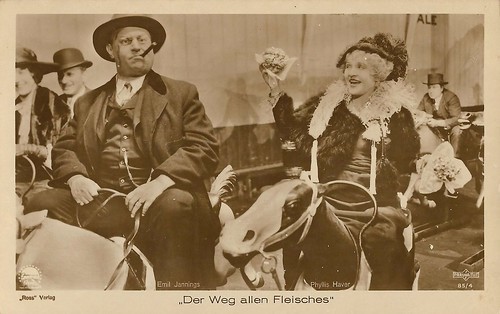
German postcard by Ross Verlag, no. 85/4. Photo: Parufamet. Emil Jannings and Phyllis Haver in The Way of All Flesh (Victor Fleming, 1927).
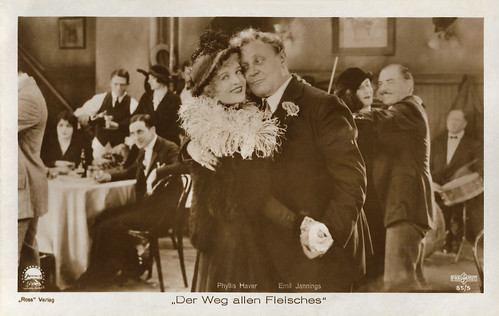
German postcard by Ross Verlag, no. 85/5. Photo: Parufamet. Emil Jannings and Phyllis Haver in The Way of All Flesh (Victor Fleming, 1927).
The surviving fragment of The Way of All Flesh (1927). Source: da218835 (YouTube).
Sources: Janiss Garza (AllMovie), Wikipedia, and IMDb.

French postcard by Editions Cinémagazine, no. 542. Photo: Emil Jannings in Quand la Chair succombe/The Way of All Flesh (Victor Fleming, 1927).

Italian postcard by G.B. Falci, Milano, no. 271. Photo: Paramount. This is Phyllis Haver, not Belle Bennett. This portrait is from the film Nel gorgo del peccato/The Way of All Flesh (Victor Fleming, 1927) in which the two actresses starred together. Collection: Marlene Pilaete.
The old tramp in the Christmas snowstorm
The Way of All Flesh (Victor Fleming, 1927) is based on a story by Perley Poore Sheehan, adapted by Lajos Biró. The film opens in the early 1900s. Emil Jannings plays August Schiller, a bank clerk in Milwaukee who is happy with both his job and with his dear wife Belle Bennett and their six children.
But when bank officials ask him to transport $1,000 in securities to Chicago, he meets on the train a bleached blonde seductress (Phyllis Haver), who catches a glimpse of what he is carrying. She flirts with him, convinces him to buy her a bottle of champagne, and takes him to a saloon run by a crook (Fred Kohler).
The next morning he awakes alone in a dilapidated bedroom, without the money. He finds the woman, and at first pleads with her, then intimidates her to return the stolen securities. He is knocked unconscious by the saloon owner and dragged to a nearby railroad track.
As the crook strips him of everything that might lead to his identification, Schiller recovers consciousness, and in a struggle, the crook falls on the path of an oncoming train and is killed. The desperate Schiller flees and wants to take his own life. Then he reads in a newspaper that he is supposedly dead, the crook's mangled body having been identified as Schiller's. Jannings decides to go along with the story to spare his family embarrassment and scandal.
The time passes to twenty years later. Schiller is aged and unkempt, employed to pick up trash in a park. He sees his own family go to a cemetery and place a wreath on his grave. Later in a Christmas snowstorm, Schiller makes his way to his former home. He sees that the son (Donald Keith) whom he had taught to play the violin is now a successful musician. He walks away, carrying in his pocket a dollar that his son has given him, not recognising that the old tramp is his father.
In 1940, the film was remade by Paramount as The Way of All Flesh (Louis King, 1940) with Akim Tamiroff, Gladys George, and Muriel Angelus.

German postcard by Ross Verlag, no. 85/1. Photo: Parufamet. Emil Jannings in The Way of All Flesh (Victor Fleming, 1927).

German postcard by Ross Verlag, no. 85/2. Photo: Parufamet. Belle Bennett and Emil Jannings in The Way of All Flesh (Victor Fleming, 1927).

German postcard by Ross Verlag, no. 85/3. Photo: Parufamet. Emil Jannings and Phyllis Haver in The Way of All Flesh (Victor Fleming, 1927).

German postcard by Ross Verlag, no. 85/4. Photo: Parufamet. Emil Jannings and Phyllis Haver in The Way of All Flesh (Victor Fleming, 1927).

German postcard by Ross Verlag, no. 85/5. Photo: Parufamet. Emil Jannings and Phyllis Haver in The Way of All Flesh (Victor Fleming, 1927).
The surviving fragment of The Way of All Flesh (1927). Source: da218835 (YouTube).
Sources: Janiss Garza (AllMovie), Wikipedia, and IMDb.
Published on September 14, 2020 22:00
September 13, 2020
Oliver Reed
Brooding macho Oliver Reed (1938-1999) was one of England's darker leading men and villainous character actors. He juggled over 60 film roles in 40 years and a full-blooded social life of women, booze, and bar fights. After a start in Hammer films, Reed worked often with acclaimed British directors Ken Russell, Richard Lester, and Michael Winner. His final role was as the old, gruff gladiator trainer in Ridley Scott's Gladiator (2000).

Dutch postcard by Art Unlimited, Amsterdam, no. B 2201. Photo: Robin Barton, 1988.
A steady flow of bad-guy roles in horrors, costume dramas, and suspense thrillers
Robert Oliver Reed was born in 1938, in Wimbledon, England. His parents were Peter Reed, a sports journalist, and Marcia Reed née Napier-Andrews. He had two brothers. David Reed became his business manager and his half-brother Simon Reed became his press agent. He was a nephew of film director Sir Carol Reed. And he was a grandson of actor-manager Herbert Beerbohm Tree, who founded the Royal Academy of Dramatic Art (RADA) in 1904.
Party animal Reed did not complete high school. He ended up taking on a variety of blue-collar jobs. His first job at the age of 17 was as a bouncer at a Soho nightclub. In 1960, he suddenly burst into films, showing up in the background of the Hammer films The Two Faces of Dr. Jekyll (Terence Fisher, 1960), and Sword of Sherwood Forest (Terence Fisher, 1960), and as a gay ballet dancer in the criminal comedy The League of Gentlemen (Basil Dearden, 1960).
His first starring role came with Hammer, as the title character in Curse of the Werewolf (Terence Fisher, 1961). Robert Armstrong at AllMovie : "Years later, he would serve as the narrator on a full Hammer retrospective, putting his sonorous speaking voice to good use and paying homage to his roots. Such early work paved the way for a steady flow of bad-guy roles in horrors, costume dramas, and suspense thrillers. Reed's intense, glowering features could also be manipulated for believable ethnic characterizations."
Films such as the Science-Fiction horror film The Damned (Joseph Losey, 1962) and Pirates of Blood River (John Gilling, 1962) followed. His first of six collaborations with Michael Winner came with The System/The Girl Getters (1964). The film was seen by Ken Russell who then cast Reed in the title role of The Debussy Film (1965), a TV biopic of Claude Debussy. It was the first time he broke away from villainous roles. According to Wikipedia , Reed later said: "Hammer films had given me my start and Michael Winner my bread then Ken Russell came on the screen and gave me my art."
Reed co-starred with Rita Tushingham in the Canadian-British co-production, The Trap (Sidney Hayers, 1966). His career stepped up another level when he starred in his second film with Winner, the popular comedy film The Jokers (Michael Winner, 1966), alongside Michael Crawford. His third Winner film was I'll Never Forget What's'isname (Michael Winner, 1967), with Orson Welles . Reed was reunited with Ken Russell for another TV film, Dante's Inferno (1967), playing Dante Gabriel Rossetti.
In 1968, he won his first leading role in a universally well-received film, the Oscar-winner Oliver! (Carol Reed, 1968), in which he played murderous thief Bill Sikes. Despite complaints of nepotism, Reed insisted he had to persuade his uncle to cast him, even though his credentials closely matched the needs of the part.
Another watershed moment came in 1969 when Ken Russell cast him as one of the leads in his adaptation of D.H. Lawrence's Women in Love (1969). Robert Armstrong at AllMovie: "While the film was a well-received treatise on sexuality and marriage, it achieved some notoriety for featuring the first-ever full-frontal male nudity in an English-language commercial film. Reed and Alan Bates engage in a memorable nude wrestling match that audaciously fleshes out the film's themes. Reportedly, Russell had planned to scrap the scene, worried about censor backlash, until Reed wrestled him into including it, literally pinning him down, in Russell's kitchen. Still, Reed told the Los Angeles Times he had to drink a bottle of vodka before he could relax enough to film the scene."

East-German postcard by Progress Film-Verleih, no. 2921, 1967. Rita Tushingham and Oliver Reed in The Trap (Sidney Hayers, 1966).

Romanian postcard by Casa Filmului Acin, no. 51. Oliver Reed and Rita Tushingham in The Trap (Sidney Hayers, 1966).
A Night with three bottles of downed rum and arm wrestling victories over five sailors
Oliver Reed and Ken Russell would work together five more times, including The Devils (1971) and Tommy (1975), in which Reed played Frank Hobbs.
Reed was also known for portraying musketeer Athos in three of Richard Lester's film versions of Alexandre Dumas' famous tale. Reed appeared in The Three Musketeers (1973) and its sequel, The Four Musketeers (1974), which originally had been planned as one long film. He revived the role for The Return of the Musketeers (1989).
During the filming of the windmill duel scene in the first film, Reed was nearly killed when he was stabbed in the throat. Add in 36 stitches to repair cuts on his face after a bar fight in 1963, and the actor had more than his share of scrapes.
Reed peaked in many ways in the mid-1970s and had to settle on genre work for much of his later career. Films such as Dr. Heckyl and Mr. Hype (Charles B. Griffith, 1980), Venom (Piers Haggard, 1982), Gor (John Norman, 1987), and Dragonard (Gérard Kikoïne, 1987) became his regular source of paychecks for many years.
More interesting films were David Cronenberg's The Brood (1979), Nicolas Roeg's Castaway (1987), or Terry Gilliam's The Adventures of Baron Munchausen (1989).
Reed's most familiar role for modern audiences was also his last. The actor appeared in Oscar-winner Gladiator (Ridley Scott, 2000) as Proximo, the amoral merchant who trains the enslaved fighters to kill and be killed. When he died midway through production, Reed unwittingly became part of a groundbreaking three-million-dollar endeavor by director Ridley Scott to digitally re-create his likeness in order to film Proximo's death scene. A three-dimensional image of Reed's face was scanned into computers so it could smile and talk, then digitally grafted onto a body double.
In 1999, Oliver Reed died in Valetta, Malta, where Gladiator was being filmed. Robert Armstrong at AllMovie : "the result of a heart attack brought on by one last night of hard-drinking, which included three bottles of downed rum and arm wrestling victories over five sailors." He was survived by his second wife, Josephine Burge. He was the father of Mark Thurloe Reed (1961) with his first wife Kate Byrne and of Sarah Reed (1970) from his 12-year relationship to dancer Jacqueline Daryl.
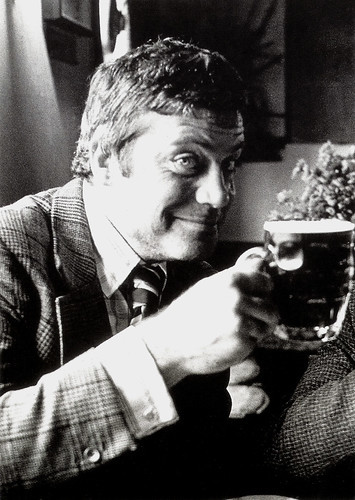
British postcard in the 'Greatest' Series - Drunks by Boomerang. Photo: John Curtis / Rex.
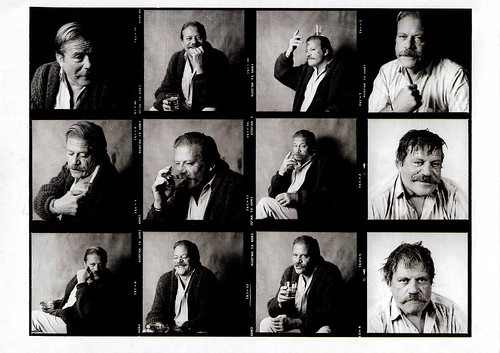
British postcard by Olympus / London Cardguide Ltd / Cinema House, London. Photos: Koo Stark. Caption: From the Olympus Cameras sponsored exhibition 'Stark Image' at The Gallery Bar, Grosvenor House Hotel, Park Lane June 3rd-20th.
Sources: Robert Armstrong (AllMovie), Wikipedia, and .

Dutch postcard by Art Unlimited, Amsterdam, no. B 2201. Photo: Robin Barton, 1988.
A steady flow of bad-guy roles in horrors, costume dramas, and suspense thrillers
Robert Oliver Reed was born in 1938, in Wimbledon, England. His parents were Peter Reed, a sports journalist, and Marcia Reed née Napier-Andrews. He had two brothers. David Reed became his business manager and his half-brother Simon Reed became his press agent. He was a nephew of film director Sir Carol Reed. And he was a grandson of actor-manager Herbert Beerbohm Tree, who founded the Royal Academy of Dramatic Art (RADA) in 1904.
Party animal Reed did not complete high school. He ended up taking on a variety of blue-collar jobs. His first job at the age of 17 was as a bouncer at a Soho nightclub. In 1960, he suddenly burst into films, showing up in the background of the Hammer films The Two Faces of Dr. Jekyll (Terence Fisher, 1960), and Sword of Sherwood Forest (Terence Fisher, 1960), and as a gay ballet dancer in the criminal comedy The League of Gentlemen (Basil Dearden, 1960).
His first starring role came with Hammer, as the title character in Curse of the Werewolf (Terence Fisher, 1961). Robert Armstrong at AllMovie : "Years later, he would serve as the narrator on a full Hammer retrospective, putting his sonorous speaking voice to good use and paying homage to his roots. Such early work paved the way for a steady flow of bad-guy roles in horrors, costume dramas, and suspense thrillers. Reed's intense, glowering features could also be manipulated for believable ethnic characterizations."
Films such as the Science-Fiction horror film The Damned (Joseph Losey, 1962) and Pirates of Blood River (John Gilling, 1962) followed. His first of six collaborations with Michael Winner came with The System/The Girl Getters (1964). The film was seen by Ken Russell who then cast Reed in the title role of The Debussy Film (1965), a TV biopic of Claude Debussy. It was the first time he broke away from villainous roles. According to Wikipedia , Reed later said: "Hammer films had given me my start and Michael Winner my bread then Ken Russell came on the screen and gave me my art."
Reed co-starred with Rita Tushingham in the Canadian-British co-production, The Trap (Sidney Hayers, 1966). His career stepped up another level when he starred in his second film with Winner, the popular comedy film The Jokers (Michael Winner, 1966), alongside Michael Crawford. His third Winner film was I'll Never Forget What's'isname (Michael Winner, 1967), with Orson Welles . Reed was reunited with Ken Russell for another TV film, Dante's Inferno (1967), playing Dante Gabriel Rossetti.
In 1968, he won his first leading role in a universally well-received film, the Oscar-winner Oliver! (Carol Reed, 1968), in which he played murderous thief Bill Sikes. Despite complaints of nepotism, Reed insisted he had to persuade his uncle to cast him, even though his credentials closely matched the needs of the part.
Another watershed moment came in 1969 when Ken Russell cast him as one of the leads in his adaptation of D.H. Lawrence's Women in Love (1969). Robert Armstrong at AllMovie: "While the film was a well-received treatise on sexuality and marriage, it achieved some notoriety for featuring the first-ever full-frontal male nudity in an English-language commercial film. Reed and Alan Bates engage in a memorable nude wrestling match that audaciously fleshes out the film's themes. Reportedly, Russell had planned to scrap the scene, worried about censor backlash, until Reed wrestled him into including it, literally pinning him down, in Russell's kitchen. Still, Reed told the Los Angeles Times he had to drink a bottle of vodka before he could relax enough to film the scene."

East-German postcard by Progress Film-Verleih, no. 2921, 1967. Rita Tushingham and Oliver Reed in The Trap (Sidney Hayers, 1966).

Romanian postcard by Casa Filmului Acin, no. 51. Oliver Reed and Rita Tushingham in The Trap (Sidney Hayers, 1966).
A Night with three bottles of downed rum and arm wrestling victories over five sailors
Oliver Reed and Ken Russell would work together five more times, including The Devils (1971) and Tommy (1975), in which Reed played Frank Hobbs.
Reed was also known for portraying musketeer Athos in three of Richard Lester's film versions of Alexandre Dumas' famous tale. Reed appeared in The Three Musketeers (1973) and its sequel, The Four Musketeers (1974), which originally had been planned as one long film. He revived the role for The Return of the Musketeers (1989).
During the filming of the windmill duel scene in the first film, Reed was nearly killed when he was stabbed in the throat. Add in 36 stitches to repair cuts on his face after a bar fight in 1963, and the actor had more than his share of scrapes.
Reed peaked in many ways in the mid-1970s and had to settle on genre work for much of his later career. Films such as Dr. Heckyl and Mr. Hype (Charles B. Griffith, 1980), Venom (Piers Haggard, 1982), Gor (John Norman, 1987), and Dragonard (Gérard Kikoïne, 1987) became his regular source of paychecks for many years.
More interesting films were David Cronenberg's The Brood (1979), Nicolas Roeg's Castaway (1987), or Terry Gilliam's The Adventures of Baron Munchausen (1989).
Reed's most familiar role for modern audiences was also his last. The actor appeared in Oscar-winner Gladiator (Ridley Scott, 2000) as Proximo, the amoral merchant who trains the enslaved fighters to kill and be killed. When he died midway through production, Reed unwittingly became part of a groundbreaking three-million-dollar endeavor by director Ridley Scott to digitally re-create his likeness in order to film Proximo's death scene. A three-dimensional image of Reed's face was scanned into computers so it could smile and talk, then digitally grafted onto a body double.
In 1999, Oliver Reed died in Valetta, Malta, where Gladiator was being filmed. Robert Armstrong at AllMovie : "the result of a heart attack brought on by one last night of hard-drinking, which included three bottles of downed rum and arm wrestling victories over five sailors." He was survived by his second wife, Josephine Burge. He was the father of Mark Thurloe Reed (1961) with his first wife Kate Byrne and of Sarah Reed (1970) from his 12-year relationship to dancer Jacqueline Daryl.

British postcard in the 'Greatest' Series - Drunks by Boomerang. Photo: John Curtis / Rex.

British postcard by Olympus / London Cardguide Ltd / Cinema House, London. Photos: Koo Stark. Caption: From the Olympus Cameras sponsored exhibition 'Stark Image' at The Gallery Bar, Grosvenor House Hotel, Park Lane June 3rd-20th.
Sources: Robert Armstrong (AllMovie), Wikipedia, and .
Published on September 13, 2020 22:00
September 12, 2020
Betty Blythe
American silent film actress Betty Blythe (1893-1972) was a brunette, buxom matinee idol. She capitalised on the 'roaring 1920s' infatuation with exotic screen sirens to achieve a brief period of stardom. Betty was notorious as one of the first actresses to appear (semi-)nude on screen in The Queen of Sheba (1922). Over the course of her career, she acted in 63 silent and 56 sound films.
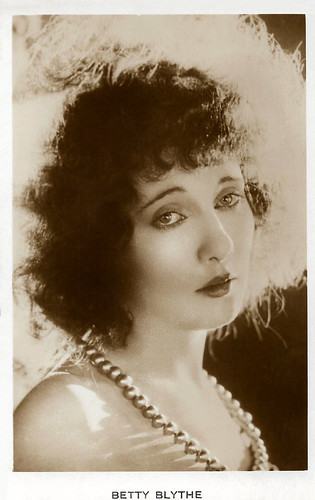
British Real Photograph postcard.

German postcard by Ross Verlag, Berlin, no. 1334/1, 1927-1928. Photo: Fox.
The notorious Betty B.
Betty Blythe was born as Elizabeth Blythe Slaughter in 1893 in Los Angeles.
She attended Westlake School for Girls and the University of Southern California. She had already shortened her name to Betty Blythe when she and three other women posed for a photoshoot of the newest swim fashion for women, a bathing suit. Prior to then, women were expected to wear stockings with full dresses or skirts into the water.
I.S. Mowis at IMDb about her notoriety: "It wasn't that Betty couldn't act, as well - in fact, she had studied art in Paris and at USC and had appeared on stage in a number of traditional plays like 'So Long Letty' in both London and New York."
She worked in vaudeville as the 'California Nightingale' singing songs such as 'Love Tales from Hoffman'. In 1915, she had an unbilled part in Bella Donna (Edwin S. Porter, Hugh Ford, 1915) with Pauline Frederick , for Famous Players Film Company.
In 1918, she joined a roommate on a visit to the Vitagraph Studio in Brooklyn and found immediate employment when one of the directors needed a leading lady for A Game With Fate (Paul Scardon, 1918). Two years later, she wound up in Hollywood, was signed by Fox Studios as a replacement for Theda Bara.
She became the protégé of J. Gordon Edwards, the grandfather of Blake Edwards of 'Pink Panther' fame. She was eventually cast as the star of one of the most lavishly produced films of the decade, The Queen of Sheba (J. Gordon Edwards, 1921). Betty later recalled that she was given 28 costumes to wear, all of which would have fitted comfortably into a shoebox. Alas, only a few stills of the movie survive, a fate shared by most of her other silent films.
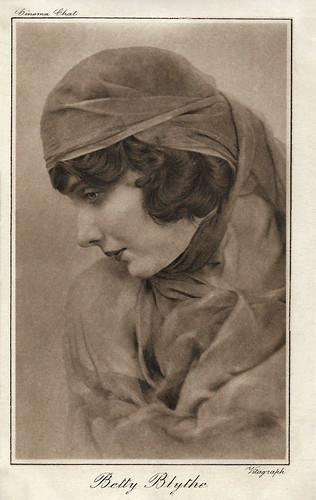
British postcard by Cinema Chat. Photo: Vitagraph.
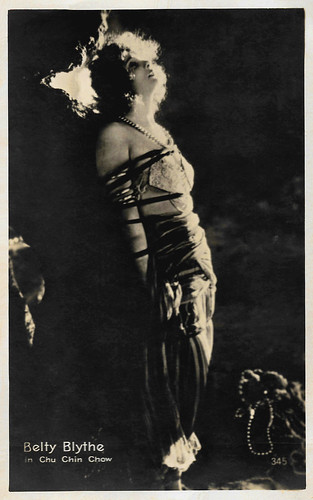
Italian postcard by Vettori, Bologna, no. 345. Photo: James Abbe. Betty Blythe in Chu Chin Chow (Herbert Wilcox, 1923).
Revealing hits in England
Betty Blythe's career was put on hold when J. Gordon Edwards quarreled with Fox and left the studio. For a while, she freelanced, playing leads in films for lesser studios.
She did have a couple of hits in England with Chu-Chin-Chow (Herbert Wilcox, 1923) and She (Leander De Cordova, G.B. Samuelson, 1925). She was also seen to good advantage in less revealing films like Nomads of the North (David Hartford, 1920) with Lon Chaney and In Hollywood with Potash and Perlmutter (Alfred E. Green, 1924), produced by Samuel Goldwyn.
In addition, she did theatrical work, which helped her to smoothly make the transition from silent to talking pictures. By that time, however, public tastes had changed and Betty had aged sufficiently to be classified as a character actress. To her credit, she persisted and appeared in support in many an A-grade production.
In 1960, she was awarded a star on the Hollywood Walk of Fame at 1708 Vine Street. Her last film appearance was a small role in the ballroom scene of My Fair Lady (George Cukor, 1964).
Blythe was married to film director Paul Scardon from 1919 until his death in 1954. She reportedly made $3,500,000 when she sold a section of land that is now part of the Sunset Strip. She lost her fortune in the 1929 stock market crash.
In 1972, Betty Blythe died of a heart attack in Woodland Hills, Los Angeles, at the age of 78. She was interred at Forest Lawn Memorial Park in Glendale, California.
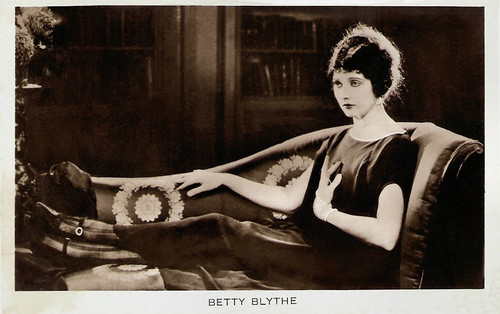
British Real Photograph postcard. Sent by mail in 1928.

French postcard by Cinémagazine-Edition, Paris, no. 218.
Sources: (IMDb), Wikipedia, and .

British Real Photograph postcard.

German postcard by Ross Verlag, Berlin, no. 1334/1, 1927-1928. Photo: Fox.
The notorious Betty B.
Betty Blythe was born as Elizabeth Blythe Slaughter in 1893 in Los Angeles.
She attended Westlake School for Girls and the University of Southern California. She had already shortened her name to Betty Blythe when she and three other women posed for a photoshoot of the newest swim fashion for women, a bathing suit. Prior to then, women were expected to wear stockings with full dresses or skirts into the water.
I.S. Mowis at IMDb about her notoriety: "It wasn't that Betty couldn't act, as well - in fact, she had studied art in Paris and at USC and had appeared on stage in a number of traditional plays like 'So Long Letty' in both London and New York."
She worked in vaudeville as the 'California Nightingale' singing songs such as 'Love Tales from Hoffman'. In 1915, she had an unbilled part in Bella Donna (Edwin S. Porter, Hugh Ford, 1915) with Pauline Frederick , for Famous Players Film Company.
In 1918, she joined a roommate on a visit to the Vitagraph Studio in Brooklyn and found immediate employment when one of the directors needed a leading lady for A Game With Fate (Paul Scardon, 1918). Two years later, she wound up in Hollywood, was signed by Fox Studios as a replacement for Theda Bara.
She became the protégé of J. Gordon Edwards, the grandfather of Blake Edwards of 'Pink Panther' fame. She was eventually cast as the star of one of the most lavishly produced films of the decade, The Queen of Sheba (J. Gordon Edwards, 1921). Betty later recalled that she was given 28 costumes to wear, all of which would have fitted comfortably into a shoebox. Alas, only a few stills of the movie survive, a fate shared by most of her other silent films.

British postcard by Cinema Chat. Photo: Vitagraph.

Italian postcard by Vettori, Bologna, no. 345. Photo: James Abbe. Betty Blythe in Chu Chin Chow (Herbert Wilcox, 1923).
Revealing hits in England
Betty Blythe's career was put on hold when J. Gordon Edwards quarreled with Fox and left the studio. For a while, she freelanced, playing leads in films for lesser studios.
She did have a couple of hits in England with Chu-Chin-Chow (Herbert Wilcox, 1923) and She (Leander De Cordova, G.B. Samuelson, 1925). She was also seen to good advantage in less revealing films like Nomads of the North (David Hartford, 1920) with Lon Chaney and In Hollywood with Potash and Perlmutter (Alfred E. Green, 1924), produced by Samuel Goldwyn.
In addition, she did theatrical work, which helped her to smoothly make the transition from silent to talking pictures. By that time, however, public tastes had changed and Betty had aged sufficiently to be classified as a character actress. To her credit, she persisted and appeared in support in many an A-grade production.
In 1960, she was awarded a star on the Hollywood Walk of Fame at 1708 Vine Street. Her last film appearance was a small role in the ballroom scene of My Fair Lady (George Cukor, 1964).
Blythe was married to film director Paul Scardon from 1919 until his death in 1954. She reportedly made $3,500,000 when she sold a section of land that is now part of the Sunset Strip. She lost her fortune in the 1929 stock market crash.
In 1972, Betty Blythe died of a heart attack in Woodland Hills, Los Angeles, at the age of 78. She was interred at Forest Lawn Memorial Park in Glendale, California.

British Real Photograph postcard. Sent by mail in 1928.

French postcard by Cinémagazine-Edition, Paris, no. 218.
Sources: (IMDb), Wikipedia, and .
Published on September 12, 2020 22:00
September 11, 2020
The World of Rizzoli, Part 4: 1939
The Milanese company Rizzoli & C. in Milan was one of the most prominent publishers of film star postcards in Italy between 1936 and 1942. Through the years, Ivo Blom collected many of the wonderful Rizzoli cards with their glamorous portraits of famous actresses. In a series of posts, Ivo chooses his favourite Rizzoli cards and describes what happened in Italy in this turbulent period. Today, Part 4 about the year 1939.

Italian postcard by Rizzoli & C., Milano, 1939-XVIII. Photo: Ghergo. Sent by mail in 1940.
In 1938, Germana Paolieri acted in five films in 1938, including Giuseppe Verdi/The Life of Giuseppe Verdi (Carmine Gallone, 1938), starring Fosco Giachetti and also with e.g. Gaby Morlay and Maria Cebotari, and Luciano Serra pilota/Luciano Serra, Pilot (Goffredo Alessandrini, 1938), starring Amedeo Nazzari. The film was crowned at the 1938 Venice film festival. Paolieri played in three films in 1939: Traversata nera/Black crossing (Domenico Gambino, 1939) with Camillo Pilotto, Il sogno di Butterfly/The Dream of Butterfly (Carmine Gallone, 1939) starring Maria Cebotari and Fosco Giachetti, which was shown at the 1939 Venice film festival, and Torna, caro ideal!/Return Most Beloved (Guido Brignone, 1939), starring Claudio Gora and Laura Adani. Paolieri always had substantial supporting parts.
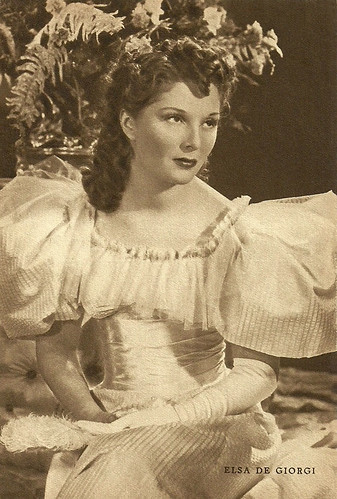
Italian postcard by Rizzoli, 1939.
Elsa De Giorgi played in two films in 1938: La mazurca di papà/Daddy's mazurca (Oreste Biancoli, 1938) with Vittorio De Sica and La sposa dei re/The Bride of the Kings (Duilio Coletti, 1938). In the latter she was Désirée Clary opposite Augusto Marcacci as Napoleon and Mario Pisu as Bernadotte. In 1939 De Giorgi acted in four films: La voce senza volto/The faceless voice (Gennaro Righelli, 1939), La grande luce – Montevergine/The great light - Montevergine (Carlo Campogalliani, 1939), Due milioni per un sorriso/Two million for a smile (Carlo Borghesio, Mario Soldati, 1939), and – the often adapted - Il fornaretto di Venezia/The Fornaretto of Venice (Duilio Coletti, 1939). In the latter, a period piece on an unjustly condemned bakery worker, she was Annetta opposite Roberto Villa as Piero, the ‘fornaretto’.
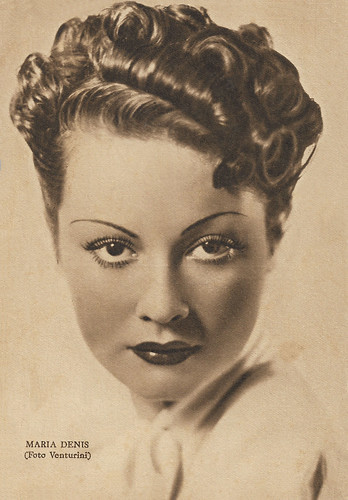
Italian postcard by Rizzoli, Milano, 1939, for Orologi e Cinturini Delgia. Photo: Venturini.
Maria Denis acted in three films opposite Vittorio De Sica in 1938: the nostalgic Napoli d’altri tempi/Naples in the past (Amleto Palermi, 1938), Partire/Departure (Amleto Palermi, 1938), and Hanno rapito un uomo/They've Kidnapped a Man (Gennaro Righelli, 1938). The latter was shown at the Venice Mostra in 1938. In 1939 Denis acted in four films: Le due madri/The Two Mothers (Amleto Palermi, 1939) again with De Sica, Chi sei tu?/Who are you? (Gino Valori, 1939) with Antonio Centa, Belle o brutte si sposan tutte.../Pretty or Plain They All Get Married (Carlo Ludovico Bragaglia, 1939) with Umberto Melnati, and Il documento/The Document (Mario Camerini, 1939). The latter was a comedy by Mario Camerini, also with Ruggeri Ruggeri, Armando Falconi and Maurizio D’Ancora.
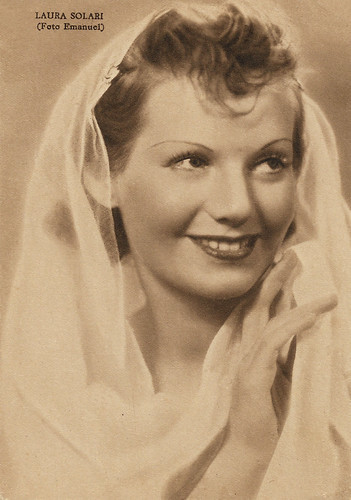
Italian postcard by Rizzoli, Milano, 1939, for Orologi e Cinturini Delgia. Photo: Emanuel.
Laura Solari debuted in 1937 on screen and had her first substantial part in the mystery L'orologio a cucù/The Cuckoo Clock (Camillo Mastrocinque, 1938) with Vittorio De Sica and Oretta Fiume. In 1938 she also played Désirée Clary’s sister in La sposa dei re/The Bride of the Kings (Duilio Coletti, 1938), starring Elsa De Giorgi. In 1939 she acted in four films: the Pirandello adaptation Terra di nessuno (Mario Baffico, 1939) with Mario Ferrari and Nelly Corradi, Una moglie in pericolo/A Woman in Danger (Max Neufeld, 1939) with Marie Glory, Bionda sotto chiave/Blonde under lock and key (Camillo Mastrocinque, 1939) with Vivi Gioi, and Eravamo sette vedoveWe Were Seven Widows (Mario Mattoli, 1939) with Antonio Gandusio.
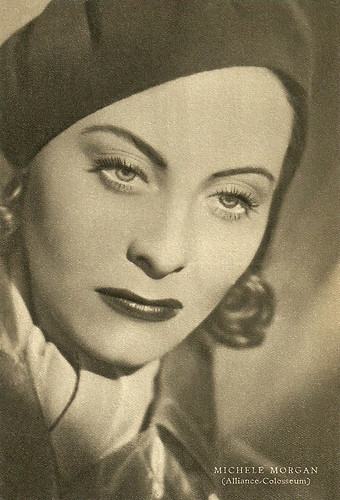
Italian postcard by Rizzoli & C., Milano, 1939. Photo: Alliance-Colosseum. Michèle Morgan in her outfit of Le Quai des brumes/Port of Shadows (Marcel Carné, 1938).
Here you see Michèle Morgan with her classic alpino from the famous film Le Quai des brumes/Port of shadows (Marcel Carné, 1938). Her films of 1939 are lesser known: Le récif de corail/Coral Reefs (Maurice Gleize, 1939) with Jean Gabin, L'entraîneuse/Nightclub Hostess (Albert Valentin, 1939) with Gilbert Gil, and La loi du nord/Law of the north (Jacques Feyder, 1939) with Pierre Richard-Willm.
The tense situation before the war
In the year 1939, the Second World War broke out. On 1 September Germany invaded Poland and Britain and France declared war on Germany. However, Italy would not become belligerent before June 1940. France and Britain did not attack Germany either, so for ¾ years the ‘phony war’ lasted, while the Germans and the Russians made a non-aggression pact in August 1939 by which Poland was split up over Germany and the USSR.
Yet, the situation already had become tenser in early 1939 when Mussolini laid claim on the Mediterranean and the Balkan, referring to the Roman Empire of Antiquity. Explicit links between the First Rome of the Emperors and the Third Rome of Mussolini had already been made clear from the late 1920s onward, with the ‘clearing’ of Roman Antiquity sites such as the Forum and the Tomb of August from later buildings from the Second Rome, that of the papal times.
Mussolini also continued and increased the pre-Fascist era's desires for expansion and colonialism in North Africa. But in 1939 he wanted to break the British and French control of the Mediterranean area and invaded Albania to ease its overpopulation but also as a first step in conquering the Balkan. Italy and Balkan signed the Pact of Steel to help each other militarily. However, Italy was way behind Germany’s military preparations for war.
1939 also signed the end of the Spanish Civil War (1936-1939) in which the Italian army extensively had helped Franco’s Nationalists to beat the Republicans. In hindsight, Italy made several propaganda films to boost morale such as Carmen fra i rossi (1939) and Alcazar (1940). Also, several Spanish actors would work in Italian film productions, such as Imperio Argentina , Conchita Montenegro , and Juan de Landa. Yet, when the war broke out in Italy 1940, and matters became tough, Spain seemed a relatively quiet place to work and live, so several Italian actors and directors went there and stayed until Italy was liberated.
Another country that stood out for its co-productions with Italy was France. Hoping not to be attacked by both Germany and Italy at the same time, the French state promoted co-productions with Italy and sent e.g. French director Jean Renoir to Rome, to make the film Tosca with Imperio Argentina , the Franco-Swiss actor Michel Simon and upcoming Italian star Rossano Brazzi . Shooting would only start in Spring 1940, and soon after the first days, Renoir fled the country when the war broke out. His assistant Carl Koch would take over and finish the film.
French actors such as Junie Astor and Marie Glory , but also Australian actress Betty Stockfeld, British-Canadian actress Rosina Lawrence, Italo-German actor Friedrich/Enrico Benfer , German-British actress Lilian Harvey and German actresses Carla Rust and Lucie English , came to Cinecittà or the Scalera studios to act in Italian films.
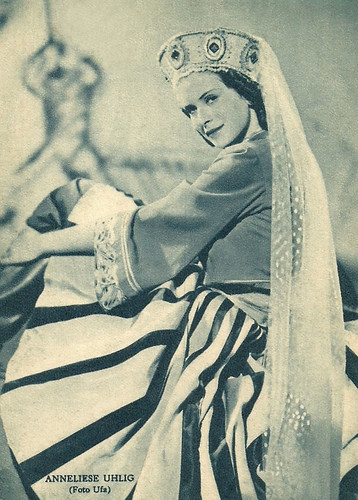
Italian postcard by Rizzoli 1939. Photo: Ufa. Anneliese Uhlig in Der Vorhang fällt/The Curtain Falls (Georg Jacoby, 1939).
Anneliese Uhlig had her breakthrough in 1937-1938 with the German circus film Manege/Die Stimme des Blutes by Italian director Carmine Gallone. (IMDb lists the two films as separate ones but they are the same one). In 1939 Uhlig acted in four German films, Die Stimme aus dem Äther/The Voice from the Ether (Harald Paulsen, 1939), Der Vorhang fällt/The Curtain Falls (Georg Jacoby, 1939), Das Recht auf Liebe/The Right to Love (Joe Stöckel, 1939), and Verdacht auf Ursula/Suspected Ursula (Karl Heinz Martin, 1939). After having rejected Goebbels' advances in 1940, Uhlig was banned from film acting in Germany and proceeded to act in several Italian films, thanks to the mediation of her friend, singer, and actress Maria Cebotari. Yet, in 1943 she was called back to Germany.
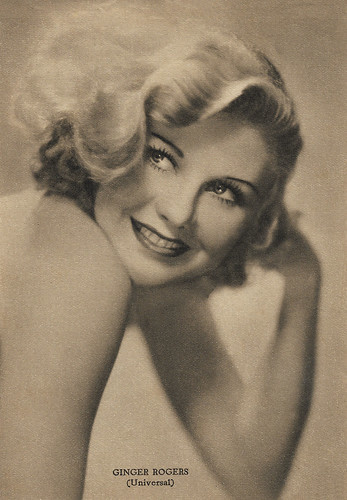
Italian postcard by Rizzoli, Milano, 1939, for Orologi e Cinturini Delgia. Photo: Universal.
It is remarkable Rizzoli still released postcards with American stars after the Hollywood majors had withdrawn from the Italian market in early 1939. However, RKO was not among these majors, so the Fred Astaire & Ginger Rogers musicals by RKO could still be shown. Among these, e.g. Carefree (Mark Sandrich, 1938) and The Story of Vernon and Irene Castle (H.C. Potter, 1939). In 1938-1939 Rogers did also various films at RKO without Astaire, such as Having Wonderful Time (Alfred Santell, 1938) with Douglas Fairbanks jr., Bachelor Mother (Garson Kanin, 1939) with David Niven and Fifth Avenue Girl (Gregory La Cava, 1939) with Walter Connolly.
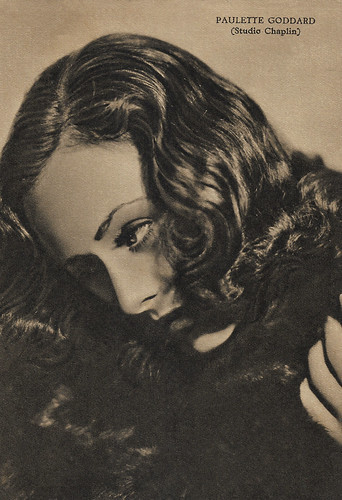
Italian postcard by Rizzoli, Milano, 1939, for Orologi e Cinturini Delgia. Photo: Studio Chaplin.
Paulette Goddard's breakthrough and claim of fame were of course Chaplin's Modern Times (1936), released in Italy in 1937 by United Artists. United Artists was not among the four Hollywood majors that withdrew from the Italian market. So when Goddard continued to act for United Artists in The Young in Heart (Richard Wallace, 1938), this could still be seen in Italy. In 1938 Goddard moved to MGM and afterward to Paramount. In 1940 she returned to United Artists for Chaplin's The Great Dictator. For obvious reasons (the film mocked Hitler and Mussolini), the film was shown in Italy first in June 1945, after the Liberation.
Hollywood absent in Venice
The Venice film festival signalled the tensions of the times. The Coppa Mussolini - the precursor of the Golden Lion attributed to the best national and foreign film between 1934 and 1942 - was given to the Italian propaganda film Abuna Messias/Cardinal Messias (1939) by Goffredo Alessandrini, which legitimised Italy’s war in Ethiopia of the 1930s, by narrating a tale that precedes the war. It portrays the life of Guglielmo Massaia ( Camillo Pilotto ), a nineteenth-century Italian known for his missionary work in the Ethiopian Empire, and having a good bond with king Menelik ( Enrico Glori ). The film was shot in Italian Oriental Africa, the then combined colony of Ethiopia, Eritrea and Somalia.
The Coppa Volpi for best male and female actor were not assigned in 1939. The Coppa della Biennale was given to five films. One was La Fin du Jour (Julien Duvivier, 1939) an homage to stage acting with Louis Jouvet , Michel Simon , Victor Francen , and Madeleine Ozeray . Another was Robert Koch, der Bekämpfer des Todes (Hans Steinhoff, 1939), starring Emil Jannings . A third was the British film The Four Feathers (Zoltan Korda, 1939), with John Clements and Ralph Richardson amidst colonial war in Sudan.
Italian cinematographer Ubaldo Arata won an award for the French film Dernière jeunesse (Jeff Musso, 1939) with Jacqueline Delubac and Raimu , while a bronze medal was given to Es war eine rauschende Ballnacht (Carl Froehlich, 1939), starring Zarah Leander .
While the United States was completely absent in Venice, Germany instead was present with 28 films. These included Willi Forst ’s Bel-Ami, with Olga Tschechowa and Forst himself. France had a smaller section but with memorable titles such as La Bête humaine (Jean Renoir, 1938), with Jean Gabin and Simone Simon , Le jour se lève (Marcel Carné, 1939), with Gabin and Arletty , and Jeunes filles en détresse (G.W. Pabst, 1939) with Micheline Presle and Marcelle Chantal .
Italy was also well presented this time, with 20 films. These included memorable titles such as Castelli in aria (Augusto Genina, 1939) with Vittorio De Sica and Lilian Harvey , Il sogno di Butterfly (Carmine Gallone, 1939) with Maria Cebotari , and, in particular, the Mario Camerini comedy I grandi magazzini, starring Vittorio De Sica and Assia Noris , and in smaller parts Enrico Glori , Luisella Beghi, Virgilio Riento, and Milena Penovich.
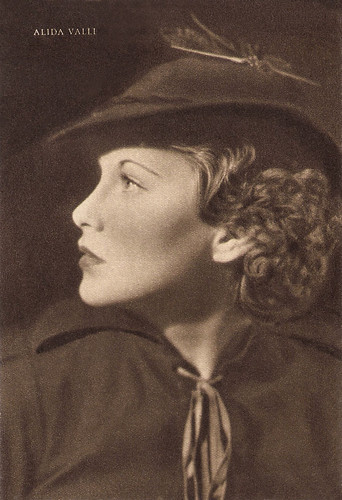
Italian postcard by Rizzoli, Milano, 1939.
Both in 1938 and in 1939 Alida Valli could be seen in three films, comedies and romantic dramas: L’ha fatto una signora/A lady made it (Mario Mattoli, 1938), L’amor mio non muore!/A Night in May (Giuseppe Amato, 1938), and La casa del peccato/The house of sin (Max Neufeld, 1938), and Mille lire al mese/One thousand lire per month (Max Neufeld, 1939), Ballo al castello/Ball at the Castle (Max Neufeld, 1939), and Assenza ingiustificata/Absence Without Leave (Max Neufeld, 1939). Mille lire al mese not only launched a popular song, but it was also one of those late 1930s Italian films reflecting on the upcoming medium of television. Yet Valli’s recognition as a dramatic actress would come first with Piccolo mondo antico/Old-Fashioned World (Mario Soldati, 1941).
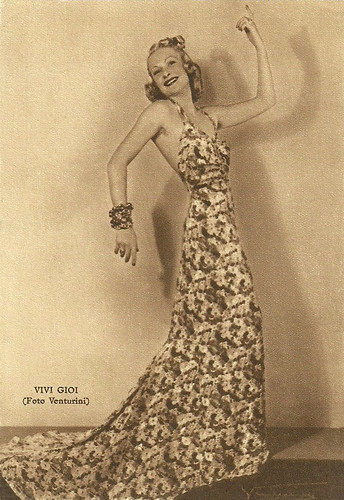
Italian postcard by Rizzoli & C., Milano, 1939. Photo: Venturini.
After two small parts in Mario Camerini’s films Il signor Max/Mister Max (Mario Camerini, 1937) and Ma non è una cosa seria/But It's Nothing Serious (Mario Camerini, 1936), Vivi Gioi had her first lead in the comedy Bionda sotto chiave/The Locked In Blond (Camillo Mastrocinque, 1939) on an American director looking for the right type for his film. Gioi acted in two more films in 1939: Frenesia/Frenzy (Mario Bonnard, 1939) with Dina Galli, Armando Falconi, and Betty Stockfeld, and Mille chilometri al minuto!/A thousand kilometers per minute! (Mario Mattoli, 1939) with Nino Besozzi and Antonio Gandusio.
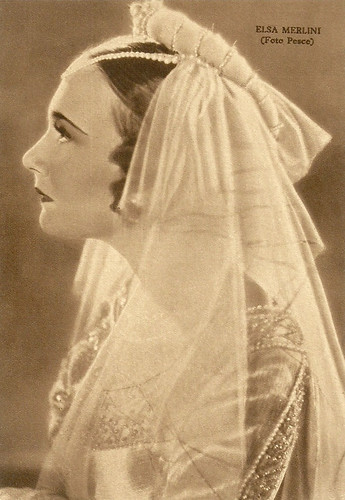
Italian postcard by Rizzoli & C., Milano, 1939. Photo: Pesce.
Elsa Merlini acted in three films in 1938: L’albero di Adamo/Adam's Tree (Mario Bonnard, 1938) with Antonio Gandusio, Amicizia/Friendship (Oreste Biancoli, 1938) with Nino Besozzi, and La dama bianca/The White Lady (Mario Mattoli, 1938), again with Besozzi. In 1939 she was in only one film Ai vostri ordini, signora..., with Vittorio De Sica as a man who poses as the lover of a rich widow (Merlini, of course).
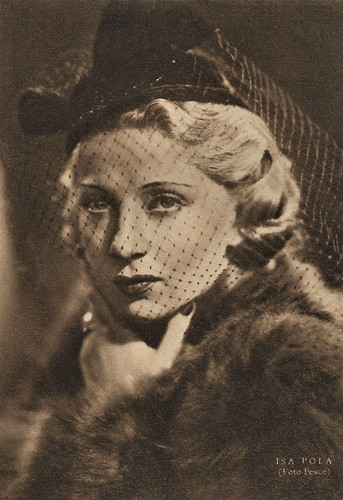
Italian postcard by Rizzoli & C., Milano, 1939. Photo: Pesce.
Isa Pola acted in two films in 1939. She starred in La vedova/The Widow (Goffredo Alessandrini, 1939) with Leonardo Cortese, while she played Santuzza in Cavalleria rusticana (Amleto Palermi, 1939), also with Cortese as Turiddu, Doris Duranti as Lola, and Carlo Ninchi as Alfio. Pola didn’t act in film in 1938.
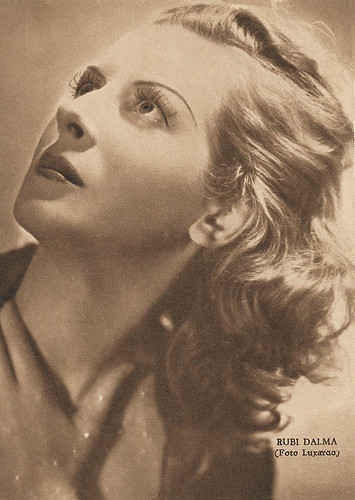
Italian postcard by Rizzoli & C., Milano, 1939. Photo: Luxardo.
After her breakthrough in Il signor Max/Mister Max (Mario Camerini, 1937), Rubi Dalma (or D'Alma) acted in 1938 in L'argine/The Dyke (Corrado D'Errico, 1938) and L’allegro cantante/The Merry Singer (Gennaro Righelli, 1938), and in 1939 in Uragano ai tropici/Hurricane in the tropics (Pier Luigi Faraldo, Gino Talamo, 1939) and Camerini’s Batticuore/Heartbeat (Mario Camerini, 1939). The latter was, just like Mille lire al mese, a comedy in which the early stage of television is mocked. In Batticuore the leads were for Assia Noris (the female star from Il signor Max), playing a spying pickpocket involved in diplomatic scandals, and American actor John Lodge, who did various film in Europe in the 1930s and was married to actress Francesca Braggiotti.
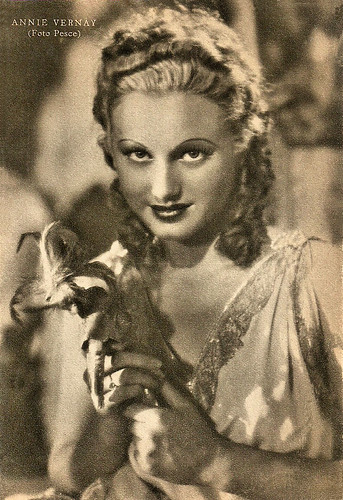
Italian postcard by Rizzoli & C., Milano, 1939. Photo: Pesce.
After her debut in a supporting part in Le mensonge de Nina Petrovna/The Lie of Nina Petrovna (Viktor Tourjansky, Hanns Schwarz, 1937), French actress Annie Vernay went to Italy to star in the Franco-Italian co-production La principessa Tarakanova/Betrayal (Fyodor Otsep (as Fedor Ozep), Mario Soldati, 1938), costarring Pierre Richard-Willm and Suzy Prim. This postcard may well refer to that role. In 1938 Vernay also acted in the French film Le roman de Werther/The Novel of Werther (Max Ophüls, 1938), again with Richard-Willm, and in 1939 she performed in Les otages/The Mayor's Dilemma (Raymond Bernard, 1939), with Saturnin Fabre.
To be continued.
Sources: Wikipedia (Italian and English).

Italian postcard by Rizzoli & C., Milano, 1939-XVIII. Photo: Ghergo. Sent by mail in 1940.
In 1938, Germana Paolieri acted in five films in 1938, including Giuseppe Verdi/The Life of Giuseppe Verdi (Carmine Gallone, 1938), starring Fosco Giachetti and also with e.g. Gaby Morlay and Maria Cebotari, and Luciano Serra pilota/Luciano Serra, Pilot (Goffredo Alessandrini, 1938), starring Amedeo Nazzari. The film was crowned at the 1938 Venice film festival. Paolieri played in three films in 1939: Traversata nera/Black crossing (Domenico Gambino, 1939) with Camillo Pilotto, Il sogno di Butterfly/The Dream of Butterfly (Carmine Gallone, 1939) starring Maria Cebotari and Fosco Giachetti, which was shown at the 1939 Venice film festival, and Torna, caro ideal!/Return Most Beloved (Guido Brignone, 1939), starring Claudio Gora and Laura Adani. Paolieri always had substantial supporting parts.

Italian postcard by Rizzoli, 1939.
Elsa De Giorgi played in two films in 1938: La mazurca di papà/Daddy's mazurca (Oreste Biancoli, 1938) with Vittorio De Sica and La sposa dei re/The Bride of the Kings (Duilio Coletti, 1938). In the latter she was Désirée Clary opposite Augusto Marcacci as Napoleon and Mario Pisu as Bernadotte. In 1939 De Giorgi acted in four films: La voce senza volto/The faceless voice (Gennaro Righelli, 1939), La grande luce – Montevergine/The great light - Montevergine (Carlo Campogalliani, 1939), Due milioni per un sorriso/Two million for a smile (Carlo Borghesio, Mario Soldati, 1939), and – the often adapted - Il fornaretto di Venezia/The Fornaretto of Venice (Duilio Coletti, 1939). In the latter, a period piece on an unjustly condemned bakery worker, she was Annetta opposite Roberto Villa as Piero, the ‘fornaretto’.

Italian postcard by Rizzoli, Milano, 1939, for Orologi e Cinturini Delgia. Photo: Venturini.
Maria Denis acted in three films opposite Vittorio De Sica in 1938: the nostalgic Napoli d’altri tempi/Naples in the past (Amleto Palermi, 1938), Partire/Departure (Amleto Palermi, 1938), and Hanno rapito un uomo/They've Kidnapped a Man (Gennaro Righelli, 1938). The latter was shown at the Venice Mostra in 1938. In 1939 Denis acted in four films: Le due madri/The Two Mothers (Amleto Palermi, 1939) again with De Sica, Chi sei tu?/Who are you? (Gino Valori, 1939) with Antonio Centa, Belle o brutte si sposan tutte.../Pretty or Plain They All Get Married (Carlo Ludovico Bragaglia, 1939) with Umberto Melnati, and Il documento/The Document (Mario Camerini, 1939). The latter was a comedy by Mario Camerini, also with Ruggeri Ruggeri, Armando Falconi and Maurizio D’Ancora.

Italian postcard by Rizzoli, Milano, 1939, for Orologi e Cinturini Delgia. Photo: Emanuel.
Laura Solari debuted in 1937 on screen and had her first substantial part in the mystery L'orologio a cucù/The Cuckoo Clock (Camillo Mastrocinque, 1938) with Vittorio De Sica and Oretta Fiume. In 1938 she also played Désirée Clary’s sister in La sposa dei re/The Bride of the Kings (Duilio Coletti, 1938), starring Elsa De Giorgi. In 1939 she acted in four films: the Pirandello adaptation Terra di nessuno (Mario Baffico, 1939) with Mario Ferrari and Nelly Corradi, Una moglie in pericolo/A Woman in Danger (Max Neufeld, 1939) with Marie Glory, Bionda sotto chiave/Blonde under lock and key (Camillo Mastrocinque, 1939) with Vivi Gioi, and Eravamo sette vedoveWe Were Seven Widows (Mario Mattoli, 1939) with Antonio Gandusio.

Italian postcard by Rizzoli & C., Milano, 1939. Photo: Alliance-Colosseum. Michèle Morgan in her outfit of Le Quai des brumes/Port of Shadows (Marcel Carné, 1938).
Here you see Michèle Morgan with her classic alpino from the famous film Le Quai des brumes/Port of shadows (Marcel Carné, 1938). Her films of 1939 are lesser known: Le récif de corail/Coral Reefs (Maurice Gleize, 1939) with Jean Gabin, L'entraîneuse/Nightclub Hostess (Albert Valentin, 1939) with Gilbert Gil, and La loi du nord/Law of the north (Jacques Feyder, 1939) with Pierre Richard-Willm.
The tense situation before the war
In the year 1939, the Second World War broke out. On 1 September Germany invaded Poland and Britain and France declared war on Germany. However, Italy would not become belligerent before June 1940. France and Britain did not attack Germany either, so for ¾ years the ‘phony war’ lasted, while the Germans and the Russians made a non-aggression pact in August 1939 by which Poland was split up over Germany and the USSR.
Yet, the situation already had become tenser in early 1939 when Mussolini laid claim on the Mediterranean and the Balkan, referring to the Roman Empire of Antiquity. Explicit links between the First Rome of the Emperors and the Third Rome of Mussolini had already been made clear from the late 1920s onward, with the ‘clearing’ of Roman Antiquity sites such as the Forum and the Tomb of August from later buildings from the Second Rome, that of the papal times.
Mussolini also continued and increased the pre-Fascist era's desires for expansion and colonialism in North Africa. But in 1939 he wanted to break the British and French control of the Mediterranean area and invaded Albania to ease its overpopulation but also as a first step in conquering the Balkan. Italy and Balkan signed the Pact of Steel to help each other militarily. However, Italy was way behind Germany’s military preparations for war.
1939 also signed the end of the Spanish Civil War (1936-1939) in which the Italian army extensively had helped Franco’s Nationalists to beat the Republicans. In hindsight, Italy made several propaganda films to boost morale such as Carmen fra i rossi (1939) and Alcazar (1940). Also, several Spanish actors would work in Italian film productions, such as Imperio Argentina , Conchita Montenegro , and Juan de Landa. Yet, when the war broke out in Italy 1940, and matters became tough, Spain seemed a relatively quiet place to work and live, so several Italian actors and directors went there and stayed until Italy was liberated.
Another country that stood out for its co-productions with Italy was France. Hoping not to be attacked by both Germany and Italy at the same time, the French state promoted co-productions with Italy and sent e.g. French director Jean Renoir to Rome, to make the film Tosca with Imperio Argentina , the Franco-Swiss actor Michel Simon and upcoming Italian star Rossano Brazzi . Shooting would only start in Spring 1940, and soon after the first days, Renoir fled the country when the war broke out. His assistant Carl Koch would take over and finish the film.
French actors such as Junie Astor and Marie Glory , but also Australian actress Betty Stockfeld, British-Canadian actress Rosina Lawrence, Italo-German actor Friedrich/Enrico Benfer , German-British actress Lilian Harvey and German actresses Carla Rust and Lucie English , came to Cinecittà or the Scalera studios to act in Italian films.

Italian postcard by Rizzoli 1939. Photo: Ufa. Anneliese Uhlig in Der Vorhang fällt/The Curtain Falls (Georg Jacoby, 1939).
Anneliese Uhlig had her breakthrough in 1937-1938 with the German circus film Manege/Die Stimme des Blutes by Italian director Carmine Gallone. (IMDb lists the two films as separate ones but they are the same one). In 1939 Uhlig acted in four German films, Die Stimme aus dem Äther/The Voice from the Ether (Harald Paulsen, 1939), Der Vorhang fällt/The Curtain Falls (Georg Jacoby, 1939), Das Recht auf Liebe/The Right to Love (Joe Stöckel, 1939), and Verdacht auf Ursula/Suspected Ursula (Karl Heinz Martin, 1939). After having rejected Goebbels' advances in 1940, Uhlig was banned from film acting in Germany and proceeded to act in several Italian films, thanks to the mediation of her friend, singer, and actress Maria Cebotari. Yet, in 1943 she was called back to Germany.

Italian postcard by Rizzoli, Milano, 1939, for Orologi e Cinturini Delgia. Photo: Universal.
It is remarkable Rizzoli still released postcards with American stars after the Hollywood majors had withdrawn from the Italian market in early 1939. However, RKO was not among these majors, so the Fred Astaire & Ginger Rogers musicals by RKO could still be shown. Among these, e.g. Carefree (Mark Sandrich, 1938) and The Story of Vernon and Irene Castle (H.C. Potter, 1939). In 1938-1939 Rogers did also various films at RKO without Astaire, such as Having Wonderful Time (Alfred Santell, 1938) with Douglas Fairbanks jr., Bachelor Mother (Garson Kanin, 1939) with David Niven and Fifth Avenue Girl (Gregory La Cava, 1939) with Walter Connolly.

Italian postcard by Rizzoli, Milano, 1939, for Orologi e Cinturini Delgia. Photo: Studio Chaplin.
Paulette Goddard's breakthrough and claim of fame were of course Chaplin's Modern Times (1936), released in Italy in 1937 by United Artists. United Artists was not among the four Hollywood majors that withdrew from the Italian market. So when Goddard continued to act for United Artists in The Young in Heart (Richard Wallace, 1938), this could still be seen in Italy. In 1938 Goddard moved to MGM and afterward to Paramount. In 1940 she returned to United Artists for Chaplin's The Great Dictator. For obvious reasons (the film mocked Hitler and Mussolini), the film was shown in Italy first in June 1945, after the Liberation.
Hollywood absent in Venice
The Venice film festival signalled the tensions of the times. The Coppa Mussolini - the precursor of the Golden Lion attributed to the best national and foreign film between 1934 and 1942 - was given to the Italian propaganda film Abuna Messias/Cardinal Messias (1939) by Goffredo Alessandrini, which legitimised Italy’s war in Ethiopia of the 1930s, by narrating a tale that precedes the war. It portrays the life of Guglielmo Massaia ( Camillo Pilotto ), a nineteenth-century Italian known for his missionary work in the Ethiopian Empire, and having a good bond with king Menelik ( Enrico Glori ). The film was shot in Italian Oriental Africa, the then combined colony of Ethiopia, Eritrea and Somalia.
The Coppa Volpi for best male and female actor were not assigned in 1939. The Coppa della Biennale was given to five films. One was La Fin du Jour (Julien Duvivier, 1939) an homage to stage acting with Louis Jouvet , Michel Simon , Victor Francen , and Madeleine Ozeray . Another was Robert Koch, der Bekämpfer des Todes (Hans Steinhoff, 1939), starring Emil Jannings . A third was the British film The Four Feathers (Zoltan Korda, 1939), with John Clements and Ralph Richardson amidst colonial war in Sudan.
Italian cinematographer Ubaldo Arata won an award for the French film Dernière jeunesse (Jeff Musso, 1939) with Jacqueline Delubac and Raimu , while a bronze medal was given to Es war eine rauschende Ballnacht (Carl Froehlich, 1939), starring Zarah Leander .
While the United States was completely absent in Venice, Germany instead was present with 28 films. These included Willi Forst ’s Bel-Ami, with Olga Tschechowa and Forst himself. France had a smaller section but with memorable titles such as La Bête humaine (Jean Renoir, 1938), with Jean Gabin and Simone Simon , Le jour se lève (Marcel Carné, 1939), with Gabin and Arletty , and Jeunes filles en détresse (G.W. Pabst, 1939) with Micheline Presle and Marcelle Chantal .
Italy was also well presented this time, with 20 films. These included memorable titles such as Castelli in aria (Augusto Genina, 1939) with Vittorio De Sica and Lilian Harvey , Il sogno di Butterfly (Carmine Gallone, 1939) with Maria Cebotari , and, in particular, the Mario Camerini comedy I grandi magazzini, starring Vittorio De Sica and Assia Noris , and in smaller parts Enrico Glori , Luisella Beghi, Virgilio Riento, and Milena Penovich.

Italian postcard by Rizzoli, Milano, 1939.
Both in 1938 and in 1939 Alida Valli could be seen in three films, comedies and romantic dramas: L’ha fatto una signora/A lady made it (Mario Mattoli, 1938), L’amor mio non muore!/A Night in May (Giuseppe Amato, 1938), and La casa del peccato/The house of sin (Max Neufeld, 1938), and Mille lire al mese/One thousand lire per month (Max Neufeld, 1939), Ballo al castello/Ball at the Castle (Max Neufeld, 1939), and Assenza ingiustificata/Absence Without Leave (Max Neufeld, 1939). Mille lire al mese not only launched a popular song, but it was also one of those late 1930s Italian films reflecting on the upcoming medium of television. Yet Valli’s recognition as a dramatic actress would come first with Piccolo mondo antico/Old-Fashioned World (Mario Soldati, 1941).

Italian postcard by Rizzoli & C., Milano, 1939. Photo: Venturini.
After two small parts in Mario Camerini’s films Il signor Max/Mister Max (Mario Camerini, 1937) and Ma non è una cosa seria/But It's Nothing Serious (Mario Camerini, 1936), Vivi Gioi had her first lead in the comedy Bionda sotto chiave/The Locked In Blond (Camillo Mastrocinque, 1939) on an American director looking for the right type for his film. Gioi acted in two more films in 1939: Frenesia/Frenzy (Mario Bonnard, 1939) with Dina Galli, Armando Falconi, and Betty Stockfeld, and Mille chilometri al minuto!/A thousand kilometers per minute! (Mario Mattoli, 1939) with Nino Besozzi and Antonio Gandusio.

Italian postcard by Rizzoli & C., Milano, 1939. Photo: Pesce.
Elsa Merlini acted in three films in 1938: L’albero di Adamo/Adam's Tree (Mario Bonnard, 1938) with Antonio Gandusio, Amicizia/Friendship (Oreste Biancoli, 1938) with Nino Besozzi, and La dama bianca/The White Lady (Mario Mattoli, 1938), again with Besozzi. In 1939 she was in only one film Ai vostri ordini, signora..., with Vittorio De Sica as a man who poses as the lover of a rich widow (Merlini, of course).

Italian postcard by Rizzoli & C., Milano, 1939. Photo: Pesce.
Isa Pola acted in two films in 1939. She starred in La vedova/The Widow (Goffredo Alessandrini, 1939) with Leonardo Cortese, while she played Santuzza in Cavalleria rusticana (Amleto Palermi, 1939), also with Cortese as Turiddu, Doris Duranti as Lola, and Carlo Ninchi as Alfio. Pola didn’t act in film in 1938.

Italian postcard by Rizzoli & C., Milano, 1939. Photo: Luxardo.
After her breakthrough in Il signor Max/Mister Max (Mario Camerini, 1937), Rubi Dalma (or D'Alma) acted in 1938 in L'argine/The Dyke (Corrado D'Errico, 1938) and L’allegro cantante/The Merry Singer (Gennaro Righelli, 1938), and in 1939 in Uragano ai tropici/Hurricane in the tropics (Pier Luigi Faraldo, Gino Talamo, 1939) and Camerini’s Batticuore/Heartbeat (Mario Camerini, 1939). The latter was, just like Mille lire al mese, a comedy in which the early stage of television is mocked. In Batticuore the leads were for Assia Noris (the female star from Il signor Max), playing a spying pickpocket involved in diplomatic scandals, and American actor John Lodge, who did various film in Europe in the 1930s and was married to actress Francesca Braggiotti.

Italian postcard by Rizzoli & C., Milano, 1939. Photo: Pesce.
After her debut in a supporting part in Le mensonge de Nina Petrovna/The Lie of Nina Petrovna (Viktor Tourjansky, Hanns Schwarz, 1937), French actress Annie Vernay went to Italy to star in the Franco-Italian co-production La principessa Tarakanova/Betrayal (Fyodor Otsep (as Fedor Ozep), Mario Soldati, 1938), costarring Pierre Richard-Willm and Suzy Prim. This postcard may well refer to that role. In 1938 Vernay also acted in the French film Le roman de Werther/The Novel of Werther (Max Ophüls, 1938), again with Richard-Willm, and in 1939 she performed in Les otages/The Mayor's Dilemma (Raymond Bernard, 1939), with Saturnin Fabre.
To be continued.
Sources: Wikipedia (Italian and English).
Published on September 11, 2020 22:00
September 10, 2020
R.I.P.: Diana Rigg (1938-2020)
Yesterday, 10 September 2020, Dame Diana Rigg (1938) has passed away. The English actress was well known as Emma Peel in the classic TV series The Avengers (1965-1968), and later as Lady Olenna Tyrell in Game of Thrones (2013-2017). In between, she had an extensive career in film and theatre. Between 1959 and 1964, she performed for the Royal Shakespeare Company and won several awards, including a Tony and an Emmy award. In the cinema, she made her mark as Countess Teresa di Vicenzo, the only Bond girl to ever get 007 to the altar, in On Her Majesty's Secret Service (1969). Diana Rigg was 82.

German postcard by Ludw. Povel & Co, Nordhorn.

French postcard by Universal Collections, 2002. Photo: Canal+ Image UK Ltd.
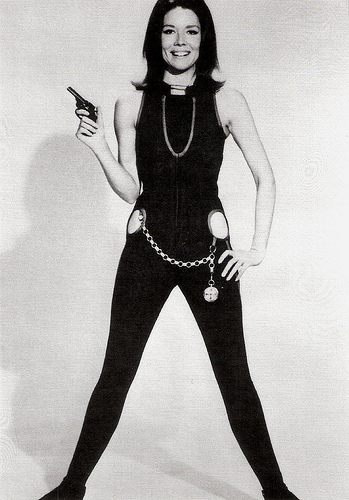
French postcard by Universal Collections, 2002. Photo: Canal+ Image UK Ltd.
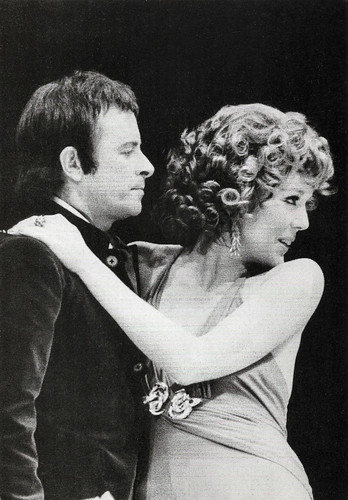
British postcard by The National Theatre. Photo: Dominic. Alec McCowen as Alceste and Diana Rigg as Célimène in the stage play 'The Misanthrope' (1973) by Molière. English version by Tony Harrison.
Captivating little boys of all ages
Enid Diana Elizabeth Rigg was born in Doncaster, then in the West Riding of Yorkshire, now in South Yorkshire, in 1938. Her parents were railway engineer Louis Rigg and his wife Beryl Hilda Rigg née Helliwell. Between the ages of two months and eight years, Rigg lived in Bikaner, India, where her father was employed as a railway executive.
She was then sent to a private boarding school, where she suffered through the discipline and rigours until one of her teachers introduced her to the world of the theatre. From 1955 till 1957, she trained as an actress at the Royal Academy of Dramatic Art, where Glenda Jackson and Siân Phillips were among her classmates.
Rigg made her professional stage debut in the RADA production of The Caucasian Chalk Circle at the York Festival in 1957. In 1959, she joined the Royal Shakespeare Company and stayed there till 1964. Her deeply distinctive voice, auburn red hair, and towering height (5'8") assured her such dynamic roles as Viola in Twelfth Night and Cordelia in King Lear.
In 1965, actress Elizabeth Shepherd was dropped from a popular BBC TV series after filming two episodes. Rigg auditioned for the role on a whim, without ever having seen the programme. Hal Erickson at AllMovie : “she was selected to replace Honor Blackman on the popular tongue-in-cheek TV-adventure series The Avengers and for the next two years captivated little boys of all ages with her energetic portrayal of coolheaded, leather-clad karate expert Mrs. Emma Peel.”
Fans were fond of the banter between Mrs. Peel and Patrick Macnee’s John Steed, delivered with champagne crispness. From 1965 till 1967, Rigg appeared in 51 episodes of the cult series. She became soured on the series when she discovered that she was earning less than some of the cameramen. After holding out for a pay raise, she returned for a second season, which would be her last.
Then film stardom followed. She became a Bond girl in On Her Majesty's Secret Service (Peter R. Hunt, 1969), playing Countess Teresa di Vicenzo a.k.a. Tracy Bond, 007's only wife, opposite George Lazenby. Although its cinema release was not as lucrative as its predecessor You Only Live Twice, On Her Majesty's Secret Service was still one of the top-performing films of the year.
Critical reviews upon release were mixed, but the film's reputation has improved over time. Donald Guarisco at AllMovie : “Diana Rigg also makes a vivid impression as Tracy, easily the toughest and most resourceful of all Bond heroines”. Rigg’s other films from this period include her film debut A Midsummer Night's Dream (Peter Hall, 1968), the black comedy The Assassination Bureau (Basil Dearden, 1969) with Oliver Reed, Julius Caesar (Stuart Burge, 1970) featuring John Gielgud , and the satire The Hospital (Arthur Hiller, 1971). All her films were well regarded but no box office hits.
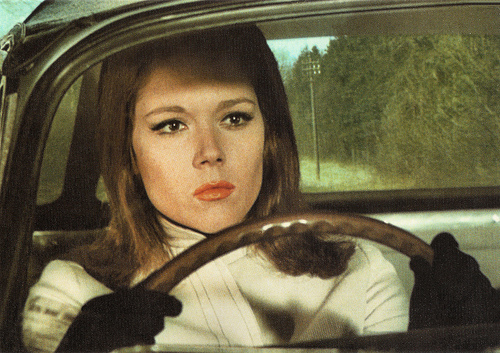
French postcard by Universal Collections, 2004. Photo: Canal+ Image UK Ltd. Publicity still for the TV series The Avengers (1965-1968), which was called in France Chapeau melon & Bottes de cuir.
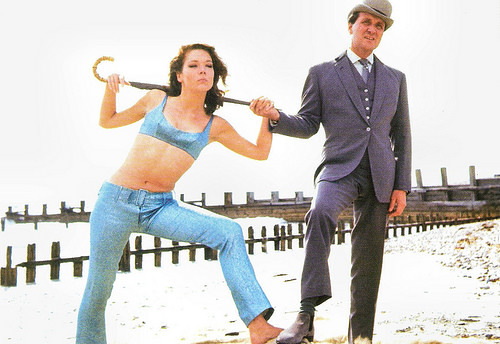
French postcard by Universal Collections, 2002. Photo: Canal+ Image UK Ltd. Publicity still for the TV series The Avengers (1965-1968), which was called in France Chapeau melon & Bottes de cuir.
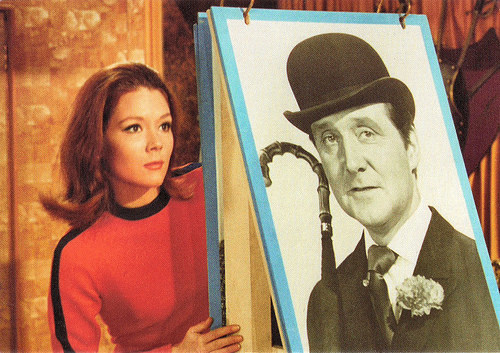
French postcard by Universal Collections, 2004. Photo: Canal+ Image UK Ltd. Publicity still for the TV series The Avengers (1965-1968), which was called in France Chapeau melon & Bottes de cuir.
Vincent Price’s loyal but homicidal daughter
In 1970, ‘theatre animal’ Diana Rigg returned to the stage in the Ronald Millar play Abelard and Heloise in London. According to IMDb , she was the first major actor (along with co-star Keith Michell) to appear nude on stage in this production. She made her Broadway debut with the play in 1971, earning the first of three Tony Award nominations for Best Actress in a Play.
She received her second nomination in 1975, for The Misanthrope. A member of the National Theatre Company at the Old Vic from 1972 to 1975, Rigg took leading roles in premiere productions of two Tom Stoppard plays, Dorothy Moore in Jumpers (1972) and Ruth Carson in Night and Day (1978).
In the cinema, she appeared in such films as the hilarious horror-comedy Theatre of Blood (Douglas Hickox, 1973) as Vincent Price ’s loyal but homicidal daughter, and the disastrous musical A Little Night Music (Harold Prince, 1977), starring Elizabeth Taylor .
On television, she appeared as the title character in The Marquise (1980), a TV adaptation of the play by Noël Coward. In 1981 she appeared on TV in the title role of Hedda Gabler, and in the cinema as Lady Holiday in The Great Muppet Caper (Jim Henson, 1981). The following year she received acclaim for her performance as glamorous actress Arlena Stuart Marshall in the film adaptation of Agatha Christie's Evil Under the Sun (Guy Hamilton, 1982), with Peter Ustinov as Hercule Poirot.
Craig Butler at AllMovie : “Diana Rigg and Maggie Smith, in particular, ;make scenery-chewing seem the most natural way of acting in a movie. (Riggs' performance of You're the Top - constantly interrupted by Smith - is particularly memorable.)”
Also in 1982, Rigg published the hilarious book No Turn Unstoned, in which she gathered together the worst reviews ever received by the world's best actors. The book, which includes a review by New York Magazine’s John Simon with uncouth remarks about her nude scene in Abelard and Heloise, became a bestseller and cult favourite.
She appeared as Regan, the king's treacherous second daughter, in a TV production of King Lear (1983), featuring Laurence Olivier . She co-starred with Denholm Elliot in a television version of Dickens' Bleak House (1985) and played the Evil Queen, Snow White's evil stepmother, in a film adaptation of Snow White (Michael Berz, 1987).
In 1987 she took a leading role in the West End production of Stephen Sondheim's musical 'Follies'. Then Rigg played obsessive mother Helena Vesey, who was prepared to do anything, even murder, to keep control of her son in the TV Mini-series Mother Love (1989). For her role, she won the BAFTA TV Award for Best Actress. In 1988, Rigg was made a Commander of the Order of the British Empire (CBE) and in 1994, a Dame Commander of the Order of the British Empire (DBE).
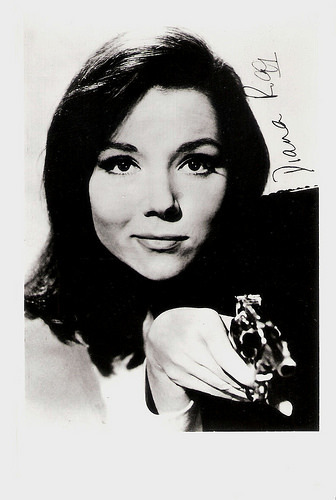
German postcard. Photo: ZDF. Publicity still for the TV series The Avengers (1965-1968), which was called in Germany Mit Schirm, Charm und Melone.
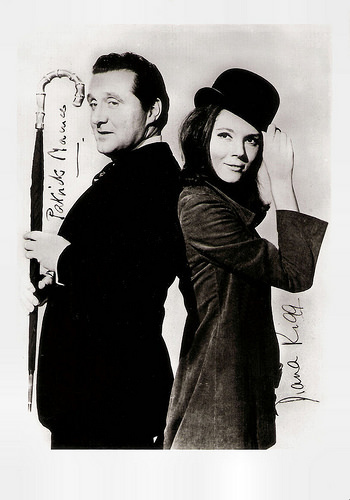
German postcard. Photo: ZDF. Publicity still for the TV series The Avengers (1965-1968), which was called in Germany Mit Schirm, Charm und Melone. Patrick Macnee was John Steed and Diana Rigg was Emma Peel.
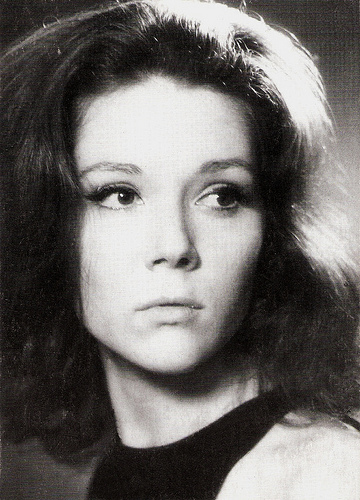
Danish postcard by Forlaget Holger Danske, no. 951.
The Queen of Thorns
In the 1990s, Diana Rigg had more triumphs on stage with her role as Medea at the Almeida Theatre in Islington in 1992. The production transferred in 1993 to the Wyndham's Theatre and in 1994 to Broadway. Rigg received the Tony Award for Best Actress for this performance. Other triumphs were her Mother Courage at the National Theatre in 1995 and Who's Afraid of Virginia Woolf? at the Almeida Theatre in 1996.
She won an Emmy Award for her role as the sinister Mrs. Danvers in Rebecca (Jim O’Brien, 1997). She also appeared in The Fortunes and Misfortunes of Moll Flanders (David Attwood, 1996), and as the eccentric old amateur detective Mrs. Bradley in The Mrs. Bradley Mysteries (James Hawes, Martin Hutchings, 1998-2000).
On stage, Rigg appeared in 2004 as Violet Venable in Tennessee Williams' play Suddenly Last Summer, and in 2007 as Huma Rojo in All About My Mother, based on the film by Pedro Almodóvar. She played in 2008 in The Cherry Orchard, and in 2009 in Noël Coward's Hay Fever. In 2011 she played Mrs. Higgins in Pygmalion, opposite Rupert Everett and Kara Tointon, having played Eliza Doolittle 37 years earlier at the Albery Theatre.
In the cinema, she could be seen as Grandmamma in the family film Heidi (Paul Marcus, 2005) and as a French Mother Superior who presides over a Chinese orphanage in The Painted Veil (John Curran, 2006) with Naomi Watts and Edward Norton.
In the 1960s, Rigg lived for eight years with actor/director Philip Saville. She was married to Menachem Gueffen, an Israeli painter, from 1973 until their divorce in 1976, and to Archibald Stirling, a theatrical producer, and former officer in the Scots Guards, in 1982, until their divorce in 1990. With Stirling, Rigg has a daughter, actress Rachael Stirling (1977).
In 2013, she appeared with her daughter Rachel in the hit series Doctor Who in the episode The Crimson Horror (Saul Metzstein, 2013). The same year, Rigg secured a recurring role in the third season of the HBO series Game of Thrones (2013-2017). She portrayed Lady Olenna Tyrell, a witty and sarcastic political mastermind popularly known as the Queen of Thorns, the grandmother of regular character Margaery Tyrell. Her performance was well received and earned her an Emmy nomination in 2013. She reprised her role in seasons four, five, and six, in an expanded role from the books.
In October 2015, to mark 50 years of Emma Peel, the BFI (British Film Institute) screened an episode of The Avengers followed by an onstage interview with Diana Rigg about her time on the cult 1960s TV show. On 10 September 2020, Diana Rigg passed away in London. She was 82. Her daughter, Rachael Stirling, said that the cause of death was cancer, which Rigg had been diagnosed with in March. Till her death, she kept appearing for the cameras. In post-production are the series Black Narcissus, in which she appears as Mother Dorothea, and the horror-thriller Last Night in Soho (Edgar Wright, 2021).
Official Trailer On Her Majesty's Secret Service (1969). Source: Movieclips Trailer Vault (YouTube).
Trailer Theatre Of Blood (1973). Source: Ian Hendry (YouTube).
Trailer Evil Under the Sun (1982). Source: jirluin (YouTube).
Sources: Stuart Jeffries (The Guardian), Hal Erickson (AllMovie), Donald Guarisco (AllMovie), Craig Butler (AllMovie), (IMDb), TCM, Wikipedia, and .

German postcard by Ludw. Povel & Co, Nordhorn.

French postcard by Universal Collections, 2002. Photo: Canal+ Image UK Ltd.

French postcard by Universal Collections, 2002. Photo: Canal+ Image UK Ltd.

British postcard by The National Theatre. Photo: Dominic. Alec McCowen as Alceste and Diana Rigg as Célimène in the stage play 'The Misanthrope' (1973) by Molière. English version by Tony Harrison.
Captivating little boys of all ages
Enid Diana Elizabeth Rigg was born in Doncaster, then in the West Riding of Yorkshire, now in South Yorkshire, in 1938. Her parents were railway engineer Louis Rigg and his wife Beryl Hilda Rigg née Helliwell. Between the ages of two months and eight years, Rigg lived in Bikaner, India, where her father was employed as a railway executive.
She was then sent to a private boarding school, where she suffered through the discipline and rigours until one of her teachers introduced her to the world of the theatre. From 1955 till 1957, she trained as an actress at the Royal Academy of Dramatic Art, where Glenda Jackson and Siân Phillips were among her classmates.
Rigg made her professional stage debut in the RADA production of The Caucasian Chalk Circle at the York Festival in 1957. In 1959, she joined the Royal Shakespeare Company and stayed there till 1964. Her deeply distinctive voice, auburn red hair, and towering height (5'8") assured her such dynamic roles as Viola in Twelfth Night and Cordelia in King Lear.
In 1965, actress Elizabeth Shepherd was dropped from a popular BBC TV series after filming two episodes. Rigg auditioned for the role on a whim, without ever having seen the programme. Hal Erickson at AllMovie : “she was selected to replace Honor Blackman on the popular tongue-in-cheek TV-adventure series The Avengers and for the next two years captivated little boys of all ages with her energetic portrayal of coolheaded, leather-clad karate expert Mrs. Emma Peel.”
Fans were fond of the banter between Mrs. Peel and Patrick Macnee’s John Steed, delivered with champagne crispness. From 1965 till 1967, Rigg appeared in 51 episodes of the cult series. She became soured on the series when she discovered that she was earning less than some of the cameramen. After holding out for a pay raise, she returned for a second season, which would be her last.
Then film stardom followed. She became a Bond girl in On Her Majesty's Secret Service (Peter R. Hunt, 1969), playing Countess Teresa di Vicenzo a.k.a. Tracy Bond, 007's only wife, opposite George Lazenby. Although its cinema release was not as lucrative as its predecessor You Only Live Twice, On Her Majesty's Secret Service was still one of the top-performing films of the year.
Critical reviews upon release were mixed, but the film's reputation has improved over time. Donald Guarisco at AllMovie : “Diana Rigg also makes a vivid impression as Tracy, easily the toughest and most resourceful of all Bond heroines”. Rigg’s other films from this period include her film debut A Midsummer Night's Dream (Peter Hall, 1968), the black comedy The Assassination Bureau (Basil Dearden, 1969) with Oliver Reed, Julius Caesar (Stuart Burge, 1970) featuring John Gielgud , and the satire The Hospital (Arthur Hiller, 1971). All her films were well regarded but no box office hits.

French postcard by Universal Collections, 2004. Photo: Canal+ Image UK Ltd. Publicity still for the TV series The Avengers (1965-1968), which was called in France Chapeau melon & Bottes de cuir.

French postcard by Universal Collections, 2002. Photo: Canal+ Image UK Ltd. Publicity still for the TV series The Avengers (1965-1968), which was called in France Chapeau melon & Bottes de cuir.

French postcard by Universal Collections, 2004. Photo: Canal+ Image UK Ltd. Publicity still for the TV series The Avengers (1965-1968), which was called in France Chapeau melon & Bottes de cuir.
Vincent Price’s loyal but homicidal daughter
In 1970, ‘theatre animal’ Diana Rigg returned to the stage in the Ronald Millar play Abelard and Heloise in London. According to IMDb , she was the first major actor (along with co-star Keith Michell) to appear nude on stage in this production. She made her Broadway debut with the play in 1971, earning the first of three Tony Award nominations for Best Actress in a Play.
She received her second nomination in 1975, for The Misanthrope. A member of the National Theatre Company at the Old Vic from 1972 to 1975, Rigg took leading roles in premiere productions of two Tom Stoppard plays, Dorothy Moore in Jumpers (1972) and Ruth Carson in Night and Day (1978).
In the cinema, she appeared in such films as the hilarious horror-comedy Theatre of Blood (Douglas Hickox, 1973) as Vincent Price ’s loyal but homicidal daughter, and the disastrous musical A Little Night Music (Harold Prince, 1977), starring Elizabeth Taylor .
On television, she appeared as the title character in The Marquise (1980), a TV adaptation of the play by Noël Coward. In 1981 she appeared on TV in the title role of Hedda Gabler, and in the cinema as Lady Holiday in The Great Muppet Caper (Jim Henson, 1981). The following year she received acclaim for her performance as glamorous actress Arlena Stuart Marshall in the film adaptation of Agatha Christie's Evil Under the Sun (Guy Hamilton, 1982), with Peter Ustinov as Hercule Poirot.
Craig Butler at AllMovie : “Diana Rigg and Maggie Smith, in particular, ;make scenery-chewing seem the most natural way of acting in a movie. (Riggs' performance of You're the Top - constantly interrupted by Smith - is particularly memorable.)”
Also in 1982, Rigg published the hilarious book No Turn Unstoned, in which she gathered together the worst reviews ever received by the world's best actors. The book, which includes a review by New York Magazine’s John Simon with uncouth remarks about her nude scene in Abelard and Heloise, became a bestseller and cult favourite.
She appeared as Regan, the king's treacherous second daughter, in a TV production of King Lear (1983), featuring Laurence Olivier . She co-starred with Denholm Elliot in a television version of Dickens' Bleak House (1985) and played the Evil Queen, Snow White's evil stepmother, in a film adaptation of Snow White (Michael Berz, 1987).
In 1987 she took a leading role in the West End production of Stephen Sondheim's musical 'Follies'. Then Rigg played obsessive mother Helena Vesey, who was prepared to do anything, even murder, to keep control of her son in the TV Mini-series Mother Love (1989). For her role, she won the BAFTA TV Award for Best Actress. In 1988, Rigg was made a Commander of the Order of the British Empire (CBE) and in 1994, a Dame Commander of the Order of the British Empire (DBE).

German postcard. Photo: ZDF. Publicity still for the TV series The Avengers (1965-1968), which was called in Germany Mit Schirm, Charm und Melone.

German postcard. Photo: ZDF. Publicity still for the TV series The Avengers (1965-1968), which was called in Germany Mit Schirm, Charm und Melone. Patrick Macnee was John Steed and Diana Rigg was Emma Peel.

Danish postcard by Forlaget Holger Danske, no. 951.
The Queen of Thorns
In the 1990s, Diana Rigg had more triumphs on stage with her role as Medea at the Almeida Theatre in Islington in 1992. The production transferred in 1993 to the Wyndham's Theatre and in 1994 to Broadway. Rigg received the Tony Award for Best Actress for this performance. Other triumphs were her Mother Courage at the National Theatre in 1995 and Who's Afraid of Virginia Woolf? at the Almeida Theatre in 1996.
She won an Emmy Award for her role as the sinister Mrs. Danvers in Rebecca (Jim O’Brien, 1997). She also appeared in The Fortunes and Misfortunes of Moll Flanders (David Attwood, 1996), and as the eccentric old amateur detective Mrs. Bradley in The Mrs. Bradley Mysteries (James Hawes, Martin Hutchings, 1998-2000).
On stage, Rigg appeared in 2004 as Violet Venable in Tennessee Williams' play Suddenly Last Summer, and in 2007 as Huma Rojo in All About My Mother, based on the film by Pedro Almodóvar. She played in 2008 in The Cherry Orchard, and in 2009 in Noël Coward's Hay Fever. In 2011 she played Mrs. Higgins in Pygmalion, opposite Rupert Everett and Kara Tointon, having played Eliza Doolittle 37 years earlier at the Albery Theatre.
In the cinema, she could be seen as Grandmamma in the family film Heidi (Paul Marcus, 2005) and as a French Mother Superior who presides over a Chinese orphanage in The Painted Veil (John Curran, 2006) with Naomi Watts and Edward Norton.
In the 1960s, Rigg lived for eight years with actor/director Philip Saville. She was married to Menachem Gueffen, an Israeli painter, from 1973 until their divorce in 1976, and to Archibald Stirling, a theatrical producer, and former officer in the Scots Guards, in 1982, until their divorce in 1990. With Stirling, Rigg has a daughter, actress Rachael Stirling (1977).
In 2013, she appeared with her daughter Rachel in the hit series Doctor Who in the episode The Crimson Horror (Saul Metzstein, 2013). The same year, Rigg secured a recurring role in the third season of the HBO series Game of Thrones (2013-2017). She portrayed Lady Olenna Tyrell, a witty and sarcastic political mastermind popularly known as the Queen of Thorns, the grandmother of regular character Margaery Tyrell. Her performance was well received and earned her an Emmy nomination in 2013. She reprised her role in seasons four, five, and six, in an expanded role from the books.
In October 2015, to mark 50 years of Emma Peel, the BFI (British Film Institute) screened an episode of The Avengers followed by an onstage interview with Diana Rigg about her time on the cult 1960s TV show. On 10 September 2020, Diana Rigg passed away in London. She was 82. Her daughter, Rachael Stirling, said that the cause of death was cancer, which Rigg had been diagnosed with in March. Till her death, she kept appearing for the cameras. In post-production are the series Black Narcissus, in which she appears as Mother Dorothea, and the horror-thriller Last Night in Soho (Edgar Wright, 2021).
Official Trailer On Her Majesty's Secret Service (1969). Source: Movieclips Trailer Vault (YouTube).
Trailer Theatre Of Blood (1973). Source: Ian Hendry (YouTube).
Trailer Evil Under the Sun (1982). Source: jirluin (YouTube).
Sources: Stuart Jeffries (The Guardian), Hal Erickson (AllMovie), Donald Guarisco (AllMovie), Craig Butler (AllMovie), (IMDb), TCM, Wikipedia, and .
Published on September 10, 2020 22:00
September 9, 2020
Directed by Karel Lamač
Karel Lamač (1897-1952), aka Karl Lamac, Carl Lamac, and Carl Lamač, was a Czech actor and filmmaker who directed more than 100 films in Czechoslovakia, Germany, France, Austria, the Netherlands, and Great-Britain. He was famous for the many comedies he directed with Czech actress Anny Ondra. Till 17 September 2020, CineGraph, the Národní Filmový Archiv (NFA) in Prague, and the Metropolis-Kino in Hamburg organise a retrospective with Lamac's films: Karel Lamač: Film-Europäer zwischen Prag und Hamburg.

Czech postcard, no. 53. Photo: Willy Ströminger, Praha. Anny Ondra and Karel Lamac in an unidentified film.

Austrian postcard by Iris Verlag, no. 5746.
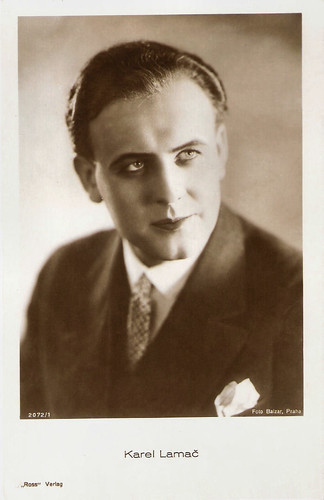
German postcard by Ross Verlag, no. 2072/1, 1927-1928. Photo: Balzar, Praha (Prague).

Austrian postcard by Iris-Verlag, no. 5334. Photo: Lux-Film Verleih. Karel Lamač and Anny Ondra in Kvet ze Sumavy/A Flower of the Sumava Mountains (Karel Lamac, 1927).

German postcard by Ross Verlag, no. 2072/2, 1927-1928. Photo: Balzar, Praha (Prague).

German postcard by Ross Verlag, no. 8717, 1933-1934. Photo: Ondra-Lamac-Film. Anny Ondra in Klein Dorrit/Little Dorrit (Carl Lamac, 1934).
The Strong Four
Karel Lamač was born in 1897 in Prague, Austria-Hungary (now Czech Republic). His parents were Karel Lamač sr., an opera singer, and a pharmacist, and Františka Lamačová (née Prusíková).
In his childhood, Lamač was interested in pharmacy, electrical engineering, stage magic, and acting. Before WWI he went to Dresden to become an apprentice at the camera manufacturing company of Ernemann.
During the war, he was a combat cameraman. After the war, he became a technical director at the film laboratory of Excelsiorfilm. He started working in films in 1918, first as an actor, later as a writer and a director.
In the Czech film Akord smrti (1919) he had his debut as (co-)director with Jan Stanislav Kolár. In 1920, he first co-acted with comedian actress Anna Ondráková ( Anny Ondra ) in Gilly poprvé v Praze/Gilly zum ersten Mal in Prag (1920).
Since then, he acted together with her in almost all of his films, and for a long time, they were married too (though some sources doubt this). In 1921 both founded the Kalos film company in Czechoslovakia, wherein in 1924 cameraman Otto Heller and in 1925 screenwriter Václav Wasserman joined them. This team was soon known as "the strong four".
Among his best films of the Czech silent era are the crime drama Otrávené světlo/The Poisoned Light (Jan S. Kolár, Karel Lamač, 1921), the comedy Chyťte ho!/ Catch Him! (Karel Lamač, 1925) and the drama Bílý ráj/White Paradise (Karel Lamač, 1924). From 1925 he directed films at the Kavalírka studio for the company Bratři Deglové. In 1928 Lamač had a huge succes as performer under direction of Martin Frič in Páter Vojtěch.
From 1924 Lamac also had a parallel career as an actor in the German cinema, first as Patroclus opposite Carlo Aldini as Achilles in the epic Helena (Manfred Noa, 1924).
In 1928 he moved to Germany for his film direction too, working for Hom-Film. He directed Anny Ondra as the star of comedy films such as Der erste Kuß/The First Kiss (1928), Saxophon-Susi/Suzy Saxophone (1928), and Das Mädel mit der Peitsche/The Girl with the Whip (1929), while he refrained from acting henceforth.
In the late 1920s he still worked in Prague too at times, e.g. Hříchy lásky/Sin of a Beautiful Woman (1929) with Marcella Albani , but this part of his career stopped when the Kavalirka studio burned down in 1929.
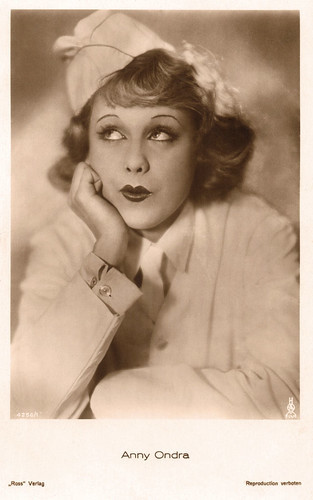
German postcard by Ross Verlag, no. 4250/1, 1929-1930.
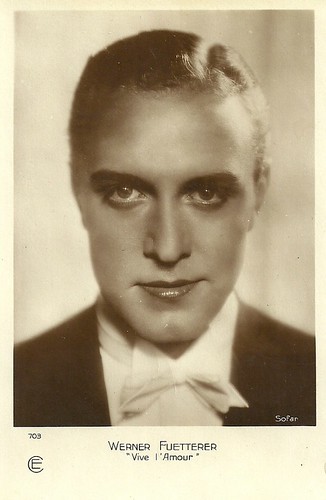
French postcard by CE (Editions Cinémagazine), no. 703. Photo: Sofar. Werner Fuetterer in Das Mädel mit der Peitsche/The Girl with the Whip (Carl Lamac, 1929), starring Anny Ondra . The film was released by Sofar in France as Vive l'amour.
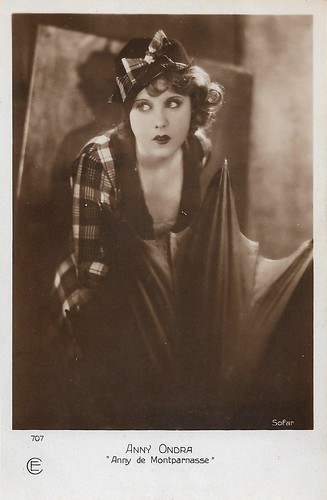
French postcard by Cinémagazine-Edition, Paris, no. 707. Photo: Sofar. Anny Ondra in Sündig und süß/Sinful and Sweet (Carl Lamac, 1929), released in France as Anny de Montparnasse.
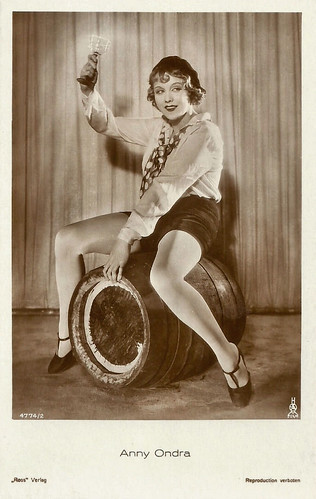
German postcard by Ross Verlag, no. 4774/2, 1929-1930. Photo: Hom Film. Anny Ondra in Sündig und süss/Sinful and Sweet (Carl Lamac, 1929).
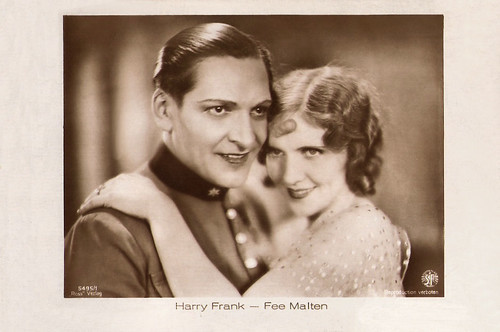
German postcard by Ross Verlag, no. 5495/1, 1930-1931. Photo: Süd-Film. Harry Frank and Fee Malten in Der falsche Feldmarschall/The Fake Field Marshal (Carl Lamac, 1930).
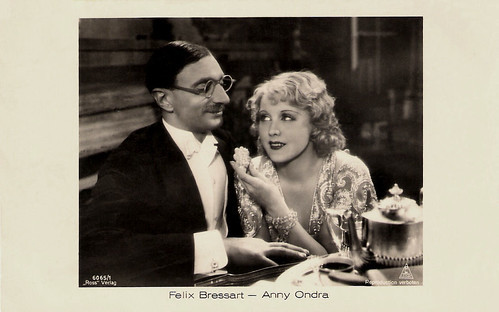
German postcard by Ross Verlag, no. 6065/1, 1931-1932. Photo: Ondra Lamac Film. Felix Bressart and Anny Ondra in Eine Freundin so goldig wie Du/A cute girlfriend like you (Carl Lamac, 1930).
Cause for Divorce
In 1929 Karel Lamač founded the production company Ondra-Lamač Film with Anny Ondra in Berlin. Their first joint film, Die vom Rummelplatz/Fairground People (1929), was a success and made up for Ondra's failed career in Britain, where her voice in Hitchcock's sound version of Blackmail (Alfred Hitchcock, 1929) was dubbed by the British actress Joan Barry.
During the 1930s Lamač was making films in Germany, Czechoslovakia, France, and Austria - some were multiple language versions such as Kiki (1932), shot in French and German, but with Ondra in both versions.
While Ondra was not in every film by Lamac anymore by the mid-1930s after she had married boxer Max Schmeling, Lamac still directed her in several films after 1933 and even had Ondra and Schmeling act together in his film Knockout (Carl Lamac, 1935). Ondra and Lamač remarkably worked together for the last time in a film called Der Scheidungsgrund/Cause for Divorce (Carl Lamac, 1937).
Instead, Lamač did various films with Czech actor Vlasta Burian in the mid-1930s. With the rise of the National Socialists, it became more and more difficult for Lamac to work in Germany. His last German film was Frühlingsluft/Spring air (Carl Lamac, 1938). After that began an odyssey through half of Europe.
After the Nazi occupation of Czechoslovakia, Lamač first left for France where he shot Place de la Concorde (Carl Lamac, 1939) with Albert Préjean , and Dolly Mollinger . In the Netherlands, he made De spooktrein/The Ghost Train (1939), an adaptation of the British play 'The Ghost Train' by Arnold Ridley.
He then moved to the United Kingdom where he joined the Czechoslovak Army. He served in the RAF until 1941 and in an infantry division until 1946. He made war documentaries and three feature films during WWII, including Schweik's New Adventures/It Started at Midnight (1943), based on the popular novel by Jaroslav Hašek. In 1926 Lamac had already filmed Hašek's original novel 'The Good Soldier Schwejk'.
After the war, he made two films in France. In 1947 then went to the USA where he worked on technical innovations of colour film and camera lenses. In 1951 he returned to Germany and directed his last film Die Diebin von Bagdad/The Thief of Bagdad (Carl Lamac, 1952) with Sonja Ziemann .
In 1952, Karel Lamač died in Hamburg, West Germany due to serious problems with his kidneys and liver. He was 55.
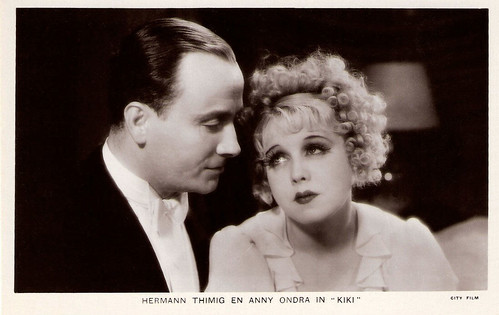
Dutch postcard. Photo: City Film. Hermann Thimig and Anny Ondra in Kiki (Carl Lamac, 1932).
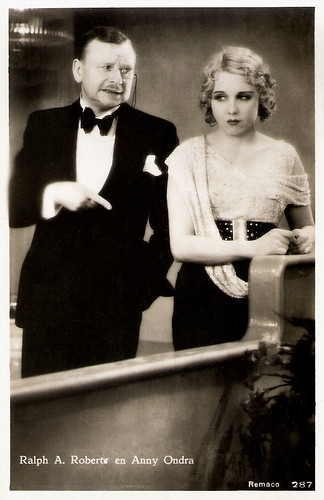
Dutch postcard by JosPe, no. 287. Photo: Remaco. Ralph Arthur Roberts and Anny Ondra in Eine Nacht im Paradies/One Night in Paradise (Carl Lamac, 1932).
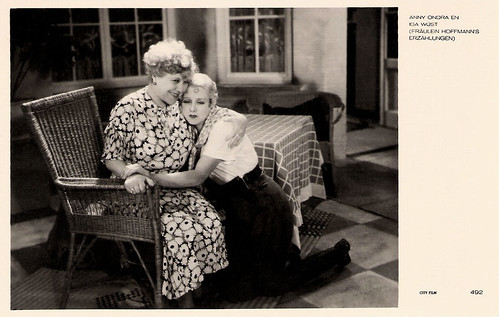
Dutch postcard by City Film, no. 492. Photo: Anny Ondra and Ida Wüst in Fräulein Hoffmanns Erzählungen/The Tales of Ms. Hoffmann (Carl Lamac, 1933).
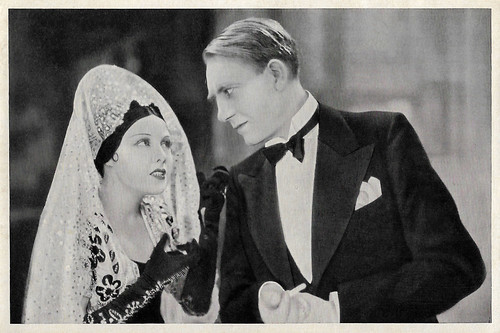
German collectors card in the series 'Vom Werden deutscher Filmkunst - Der Tonfilm', album no. 11, picture no. 55, group 44. Photo: Ondra-Lamac-Film / Ross Verlag. Anny Ondra and Mathias Wieman in Fraulein Hoffmanns Erzählungen/The Tales of Ms. Hoffmann (Carl Lamac, 1933).
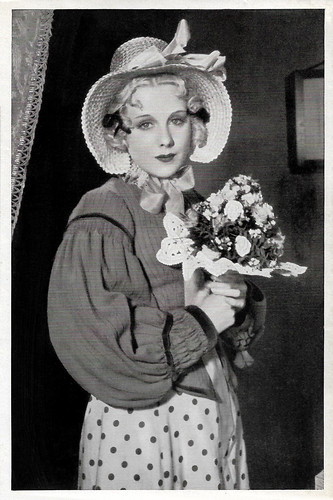
German collectors card in the series 'Vom Werden deutscher Filmkunst - Der Tonfilm', album no. 11, picture no. 56. Photo: Ondra-Lamac-Film / Ross Verlag. Anny Ondra in Klein Dorrit/Little Dorrit (Carl Lamac, 1934).
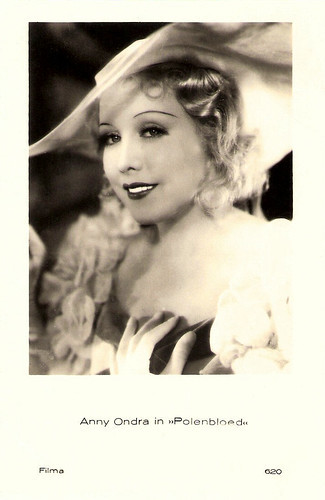
Dutch postcard by Filma, no. 620. Photo: Anny Ondra in Polenblut/Polish Blood (Carl Lamac, 1934). Collection: Geoffrey Donaldson Institute.
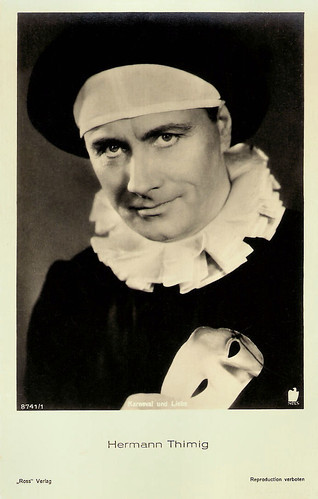
German postcard by Ross Verlag, no. 8741/1, 1933-1934. Photo: NDLS. Hermann Thimig in Karneval und Liebe/Carnival of Love (Carl Lamac, 1934).
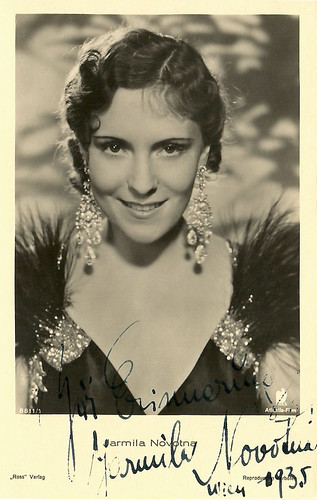
German postcard by Ross Verlag, no. 8811/1, 1933-1934. Photo: Atlantis-Film. Jarmila Novotná in Frasquita (Carl Lamac, 1934). Collection: Didier Hanson.
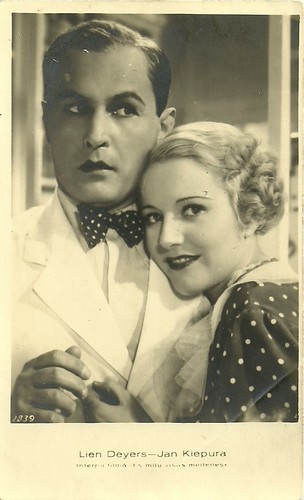
Latvian postcard by Ira, Riga, no. 1839. Jan Kiepura and Lien Deyers in Ich liebe alle Frauen/I Love All Women (Carl Lamac 1935).
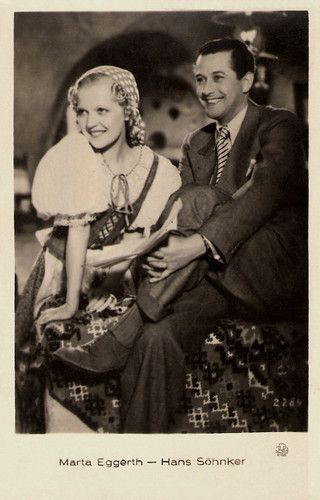
Latvian postcard, no. 2284. Photo: J. Rolin (?), Riga. Mártha (or Marta) Eggerth and Hans Söhnker in Wo die Lerche singt/Where the lark sings (Carl Lamac, 1936).
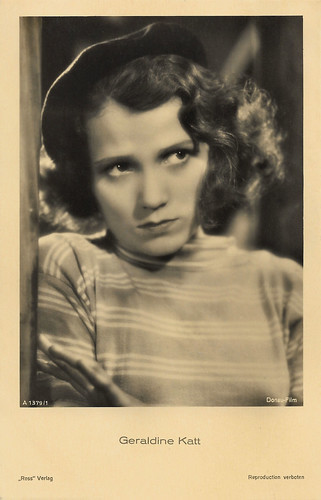
German postcard by Ross Verlag, no. A 1379/1, 1937-1938. Photo: Donau-Film. Geraldine Katt in Florentine (Carl Lamac, 1937).
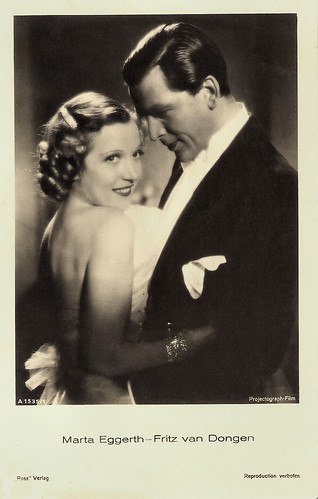
German postcard by Ross Verlag, no. A 1535/1, 1937-1938. Photo: Projectograph-Film. Marta Eggerth and Frits van Dongen in Immer wenn ich glücklich bin..!/Waltz Melodies (Karel Lamac, 1938).
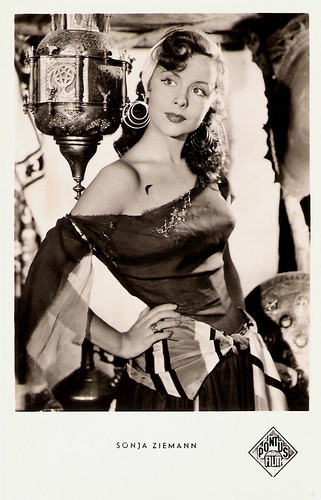
German postcard by Kunst und Bild, Berlin. Photo: Pontus Film.
Sonja Ziemann in Die Diebin von Bagdad/The Thief of Baghdad (Carl Lamac, 1952).
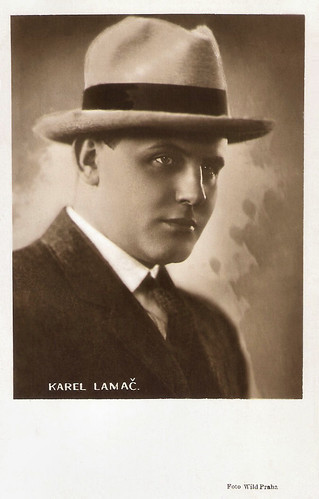
Czech postcard by Náki, M. Brandové, Praha. Photo: Wild, Praha (Prague).
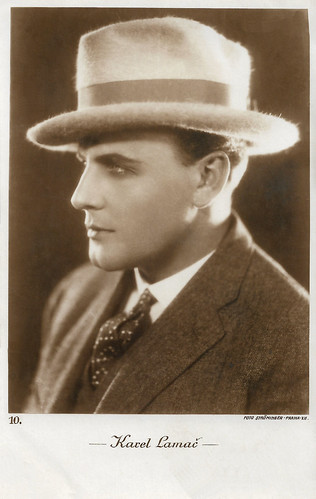
Czech postcard, no. 10. Photo: Willy Ströminger, Praha (Prague).
Sources: Wikipedia (English and German), and .

Czech postcard, no. 53. Photo: Willy Ströminger, Praha. Anny Ondra and Karel Lamac in an unidentified film.

Austrian postcard by Iris Verlag, no. 5746.

German postcard by Ross Verlag, no. 2072/1, 1927-1928. Photo: Balzar, Praha (Prague).

Austrian postcard by Iris-Verlag, no. 5334. Photo: Lux-Film Verleih. Karel Lamač and Anny Ondra in Kvet ze Sumavy/A Flower of the Sumava Mountains (Karel Lamac, 1927).

German postcard by Ross Verlag, no. 2072/2, 1927-1928. Photo: Balzar, Praha (Prague).

German postcard by Ross Verlag, no. 8717, 1933-1934. Photo: Ondra-Lamac-Film. Anny Ondra in Klein Dorrit/Little Dorrit (Carl Lamac, 1934).
The Strong Four
Karel Lamač was born in 1897 in Prague, Austria-Hungary (now Czech Republic). His parents were Karel Lamač sr., an opera singer, and a pharmacist, and Františka Lamačová (née Prusíková).
In his childhood, Lamač was interested in pharmacy, electrical engineering, stage magic, and acting. Before WWI he went to Dresden to become an apprentice at the camera manufacturing company of Ernemann.
During the war, he was a combat cameraman. After the war, he became a technical director at the film laboratory of Excelsiorfilm. He started working in films in 1918, first as an actor, later as a writer and a director.
In the Czech film Akord smrti (1919) he had his debut as (co-)director with Jan Stanislav Kolár. In 1920, he first co-acted with comedian actress Anna Ondráková ( Anny Ondra ) in Gilly poprvé v Praze/Gilly zum ersten Mal in Prag (1920).
Since then, he acted together with her in almost all of his films, and for a long time, they were married too (though some sources doubt this). In 1921 both founded the Kalos film company in Czechoslovakia, wherein in 1924 cameraman Otto Heller and in 1925 screenwriter Václav Wasserman joined them. This team was soon known as "the strong four".
Among his best films of the Czech silent era are the crime drama Otrávené světlo/The Poisoned Light (Jan S. Kolár, Karel Lamač, 1921), the comedy Chyťte ho!/ Catch Him! (Karel Lamač, 1925) and the drama Bílý ráj/White Paradise (Karel Lamač, 1924). From 1925 he directed films at the Kavalírka studio for the company Bratři Deglové. In 1928 Lamač had a huge succes as performer under direction of Martin Frič in Páter Vojtěch.
From 1924 Lamac also had a parallel career as an actor in the German cinema, first as Patroclus opposite Carlo Aldini as Achilles in the epic Helena (Manfred Noa, 1924).
In 1928 he moved to Germany for his film direction too, working for Hom-Film. He directed Anny Ondra as the star of comedy films such as Der erste Kuß/The First Kiss (1928), Saxophon-Susi/Suzy Saxophone (1928), and Das Mädel mit der Peitsche/The Girl with the Whip (1929), while he refrained from acting henceforth.
In the late 1920s he still worked in Prague too at times, e.g. Hříchy lásky/Sin of a Beautiful Woman (1929) with Marcella Albani , but this part of his career stopped when the Kavalirka studio burned down in 1929.

German postcard by Ross Verlag, no. 4250/1, 1929-1930.

French postcard by CE (Editions Cinémagazine), no. 703. Photo: Sofar. Werner Fuetterer in Das Mädel mit der Peitsche/The Girl with the Whip (Carl Lamac, 1929), starring Anny Ondra . The film was released by Sofar in France as Vive l'amour.

French postcard by Cinémagazine-Edition, Paris, no. 707. Photo: Sofar. Anny Ondra in Sündig und süß/Sinful and Sweet (Carl Lamac, 1929), released in France as Anny de Montparnasse.

German postcard by Ross Verlag, no. 4774/2, 1929-1930. Photo: Hom Film. Anny Ondra in Sündig und süss/Sinful and Sweet (Carl Lamac, 1929).

German postcard by Ross Verlag, no. 5495/1, 1930-1931. Photo: Süd-Film. Harry Frank and Fee Malten in Der falsche Feldmarschall/The Fake Field Marshal (Carl Lamac, 1930).

German postcard by Ross Verlag, no. 6065/1, 1931-1932. Photo: Ondra Lamac Film. Felix Bressart and Anny Ondra in Eine Freundin so goldig wie Du/A cute girlfriend like you (Carl Lamac, 1930).
Cause for Divorce
In 1929 Karel Lamač founded the production company Ondra-Lamač Film with Anny Ondra in Berlin. Their first joint film, Die vom Rummelplatz/Fairground People (1929), was a success and made up for Ondra's failed career in Britain, where her voice in Hitchcock's sound version of Blackmail (Alfred Hitchcock, 1929) was dubbed by the British actress Joan Barry.
During the 1930s Lamač was making films in Germany, Czechoslovakia, France, and Austria - some were multiple language versions such as Kiki (1932), shot in French and German, but with Ondra in both versions.
While Ondra was not in every film by Lamac anymore by the mid-1930s after she had married boxer Max Schmeling, Lamac still directed her in several films after 1933 and even had Ondra and Schmeling act together in his film Knockout (Carl Lamac, 1935). Ondra and Lamač remarkably worked together for the last time in a film called Der Scheidungsgrund/Cause for Divorce (Carl Lamac, 1937).
Instead, Lamač did various films with Czech actor Vlasta Burian in the mid-1930s. With the rise of the National Socialists, it became more and more difficult for Lamac to work in Germany. His last German film was Frühlingsluft/Spring air (Carl Lamac, 1938). After that began an odyssey through half of Europe.
After the Nazi occupation of Czechoslovakia, Lamač first left for France where he shot Place de la Concorde (Carl Lamac, 1939) with Albert Préjean , and Dolly Mollinger . In the Netherlands, he made De spooktrein/The Ghost Train (1939), an adaptation of the British play 'The Ghost Train' by Arnold Ridley.
He then moved to the United Kingdom where he joined the Czechoslovak Army. He served in the RAF until 1941 and in an infantry division until 1946. He made war documentaries and three feature films during WWII, including Schweik's New Adventures/It Started at Midnight (1943), based on the popular novel by Jaroslav Hašek. In 1926 Lamac had already filmed Hašek's original novel 'The Good Soldier Schwejk'.
After the war, he made two films in France. In 1947 then went to the USA where he worked on technical innovations of colour film and camera lenses. In 1951 he returned to Germany and directed his last film Die Diebin von Bagdad/The Thief of Bagdad (Carl Lamac, 1952) with Sonja Ziemann .
In 1952, Karel Lamač died in Hamburg, West Germany due to serious problems with his kidneys and liver. He was 55.

Dutch postcard. Photo: City Film. Hermann Thimig and Anny Ondra in Kiki (Carl Lamac, 1932).

Dutch postcard by JosPe, no. 287. Photo: Remaco. Ralph Arthur Roberts and Anny Ondra in Eine Nacht im Paradies/One Night in Paradise (Carl Lamac, 1932).

Dutch postcard by City Film, no. 492. Photo: Anny Ondra and Ida Wüst in Fräulein Hoffmanns Erzählungen/The Tales of Ms. Hoffmann (Carl Lamac, 1933).

German collectors card in the series 'Vom Werden deutscher Filmkunst - Der Tonfilm', album no. 11, picture no. 55, group 44. Photo: Ondra-Lamac-Film / Ross Verlag. Anny Ondra and Mathias Wieman in Fraulein Hoffmanns Erzählungen/The Tales of Ms. Hoffmann (Carl Lamac, 1933).

German collectors card in the series 'Vom Werden deutscher Filmkunst - Der Tonfilm', album no. 11, picture no. 56. Photo: Ondra-Lamac-Film / Ross Verlag. Anny Ondra in Klein Dorrit/Little Dorrit (Carl Lamac, 1934).

Dutch postcard by Filma, no. 620. Photo: Anny Ondra in Polenblut/Polish Blood (Carl Lamac, 1934). Collection: Geoffrey Donaldson Institute.

German postcard by Ross Verlag, no. 8741/1, 1933-1934. Photo: NDLS. Hermann Thimig in Karneval und Liebe/Carnival of Love (Carl Lamac, 1934).

German postcard by Ross Verlag, no. 8811/1, 1933-1934. Photo: Atlantis-Film. Jarmila Novotná in Frasquita (Carl Lamac, 1934). Collection: Didier Hanson.

Latvian postcard by Ira, Riga, no. 1839. Jan Kiepura and Lien Deyers in Ich liebe alle Frauen/I Love All Women (Carl Lamac 1935).

Latvian postcard, no. 2284. Photo: J. Rolin (?), Riga. Mártha (or Marta) Eggerth and Hans Söhnker in Wo die Lerche singt/Where the lark sings (Carl Lamac, 1936).

German postcard by Ross Verlag, no. A 1379/1, 1937-1938. Photo: Donau-Film. Geraldine Katt in Florentine (Carl Lamac, 1937).

German postcard by Ross Verlag, no. A 1535/1, 1937-1938. Photo: Projectograph-Film. Marta Eggerth and Frits van Dongen in Immer wenn ich glücklich bin..!/Waltz Melodies (Karel Lamac, 1938).

German postcard by Kunst und Bild, Berlin. Photo: Pontus Film.
Sonja Ziemann in Die Diebin von Bagdad/The Thief of Baghdad (Carl Lamac, 1952).

Czech postcard by Náki, M. Brandové, Praha. Photo: Wild, Praha (Prague).

Czech postcard, no. 10. Photo: Willy Ströminger, Praha (Prague).
Sources: Wikipedia (English and German), and .
Published on September 09, 2020 22:00
September 8, 2020
Irasema Dilian
Irasema Dilián or Eva Dilian (1924-1996), was a Polish-born, Italian actress. She had her breakthrough in Vittorio de Sica's Maddalena... zero in condotta/Maddalena, Zero for Conduct (1940), and became one of the most popular actresses of the Italian cinema of the 1940s. After the war, she became a star of the Mexican cinema.
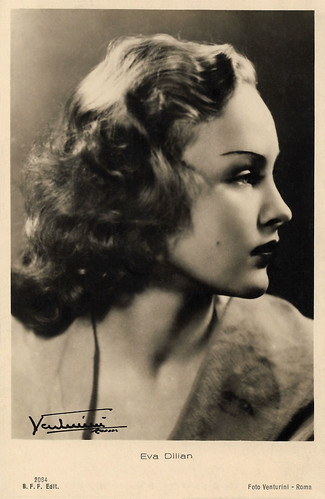
Italian postcard by B.F.F. Edit, no. 2084. Photo: Venturini, Roma.
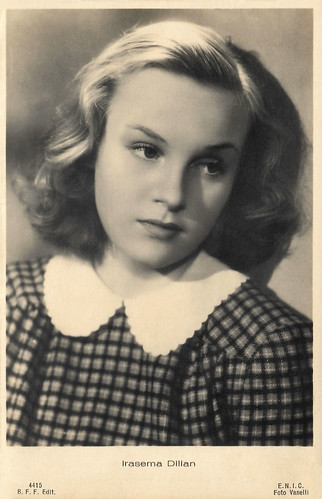
Italian postcard by B.F.F. Edit. (Casa Editrice Ballerini & Fratini, Firenze), no. 4415. Photo: Vaselli / E.N.I.C.
The rich private schoolgirl par excellence
Irasema Dilián was born as Irasema Warschalowska in 1924 in Rio de Janeiro in Brazil. She was the daughter of a Polish diplomat, who represented his country in Brazil in the 1920s.
She arrived at a very young age in Rome where she enrolled in the film school Centro Sperimentale di Cinematografia, graduating in 1940. She made her debut in a film by the French director Marcel L'Herbier, Ecco la felicità/La Comédie du bonheur/Comedy of Happiness (1940), starring Michel Simon and Ramon Novarro .
Noted by director Vittorio De Sica , Dilian became one of the students in Maddalena... zero in condotta/Maddalena, Zero for Conduct (Vittorio De Sica, 1940), alongside Carla Del Poggio . From 1940, using her first pseudonym of Eva Dilian, she became a hugely successful actress thanks to this role.
After Maddalena, she became the rich private schoolgirl par excellence of the Telefoni Bianchi, the Italian white telephones cinema. Dilian was certainly one of the most popular actresses of the 1940s, especially in the role of unpleasant students but at the same time endowed with beauty and sweetness.
This also goes for the spoiled, snobbish merchant's daughter and failed poetess Lilli Passalacqua, she played in Teresa Venerdì/Doctor, Beware (Vittorio De Sica, 1941), this time alongside Adriana Benetti as the protagonist.
But Irasema Dilián, her final pseudonym, found her consecration in Ore 9: lezione di chimica/Schoolgirl Diary (Mario Mattoli, 1941) alongside such young and beautiful actors as Alida Valli , Andrea Checchi and Bianca Della Corte. In the role of Maria, she was first credited in the opening titles and imposed herself on the audience as the sensitive and sincere girl that every male adolescent dreamed of marrying.
Dilian starred continuously in films that grossed a lot at the box offices like Violette nei cappelli/Violets in the hair (Carlo Ludovico Bragaglia, 1942), I sette peccati/The seven sins (Ladislao Kish, 1942), Malombra (Mario Soldati, 1942), and Fuga a due voci/Music on the Run (Carlo Ludovico Bragaglia, 1943), with Gino Bechi.
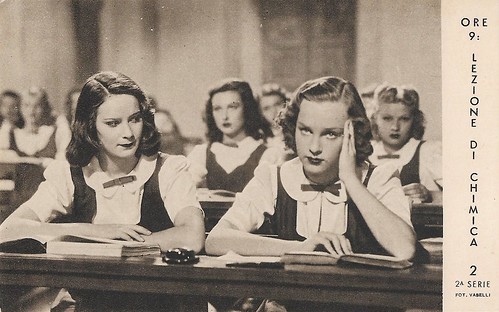
Italian postcard by Casa Editrice Italbore, Milano, no. 2. Photo Vaselli / Manenti Film. Alida Valli and Irasema Dilian in Ore 9: lezione di chimica/Schoolgirl Diary (Mario Mattoli, 1941).
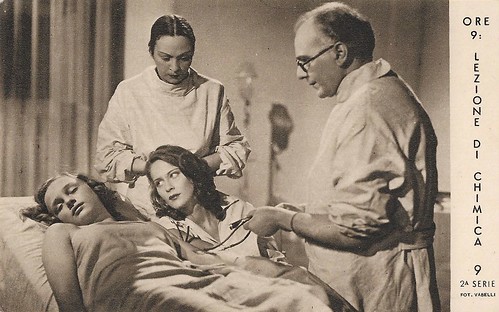
Italian postcard by Casa Editrice Italbore, Milano, no. 9. Photo Vaselli / Manenti Film. Irasema Dilian and Alida Valli in Ore 9: lezione di chimica/Schoolgirl Diary (Mario Mattoli, 1941).
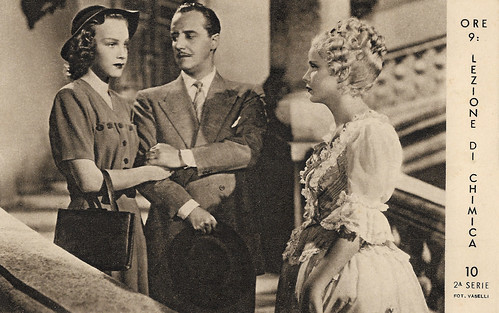
Italian postcard by Casa Editrice Italbore, Milano, no. 10. Photo Vaselli / Manenti Film. Irasema Dilian, Sandro Ruffini and Alida Valli in Ore 9: lezione di chimica/Schoolgirl Diary (Mario Mattoli, 1941).
Unexpected fame in Mexico
After the war, Irasema Dilián starred in the costume films Aquila nera/The Black Eagle (Riccardo Freda, 1946) with Rossano Brazzi , La figlia del capitano/The Captain's Daughter (Mario Camerini, 1947) and Il corriere del re/The king's courier (Gennaro Righelli, 1948), which characterised a new horizon for Dilian, who was now a woman.
During the RSI (Repubblica Sociale Italiana of Mussolini - the Republic of Salò, existing between September 1943 and May 1945), she had found artistic refuge in Spain together with other Italian stars. After the war, she returned very often to the Iberian peninsula to act in various films.
In 1950, Dilián married Arduino Maiuri, who became later an acclaimed screenwriter. After the flop of the international coproduction Donne senza nome/Women Without Names (Géza von Radványi, 1950), she moved with her husband to Mexico to shoot Muchachas de Uniforme/Girls in Uniform (Alfredo B. Crevenna, 1951), an exceptional Mexican remake of the German classic Mädchen in Uniform (Leontine Sagan, Carl Froelich, 1931).
This film was an extraordinary success and it catapulted Dilian towards unexpected fame in Mexico where she remained several years. With other actors and actresses, she created what was later called "the golden age" of the Mexican cinema.
She appeared in Luis Buñuel's Abismos de pasión/Wuthering Heights (1954), but it is perhaps the only film the director regretted shooting. However, the IMDb reviewers, all rave about the film. Dilian played Caterina/Cathy opposite Jorge Mistral as Alejandro/Heathcliff.
In the late 1950s, she retired from the film business, despite being still on the crest of the wave of success. She returned to live in Italy, where her husband Arduino Maiuri continued his successful career as a screenwriter. From their marriage two children were born, Coralla and Antonio.
Irasema Dilián died in Ceprano (Frosinone) in 1996. She was 71
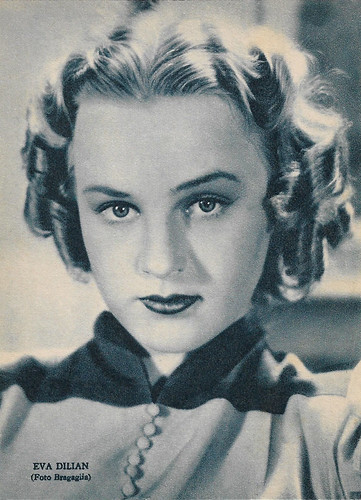
Italian postcard by Rizzoli & C., Milano, 1942. Photo: Bragaglia.
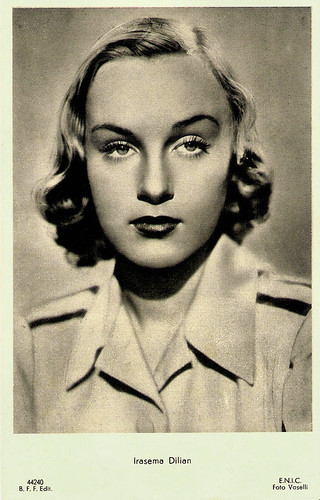
Italian postcard by B.F.F. Edit. (Casa Editrice Ballerini & Fratini, Firenze), no. 44240. Photo: Vaselli / E.N.I.C.
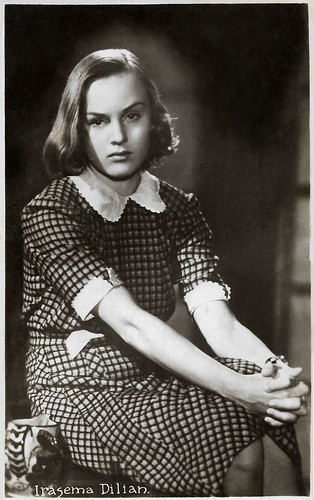
Italian or Romanian postcard.
Sources: Wikipedia (Italian), and .

Italian postcard by B.F.F. Edit, no. 2084. Photo: Venturini, Roma.

Italian postcard by B.F.F. Edit. (Casa Editrice Ballerini & Fratini, Firenze), no. 4415. Photo: Vaselli / E.N.I.C.
The rich private schoolgirl par excellence
Irasema Dilián was born as Irasema Warschalowska in 1924 in Rio de Janeiro in Brazil. She was the daughter of a Polish diplomat, who represented his country in Brazil in the 1920s.
She arrived at a very young age in Rome where she enrolled in the film school Centro Sperimentale di Cinematografia, graduating in 1940. She made her debut in a film by the French director Marcel L'Herbier, Ecco la felicità/La Comédie du bonheur/Comedy of Happiness (1940), starring Michel Simon and Ramon Novarro .
Noted by director Vittorio De Sica , Dilian became one of the students in Maddalena... zero in condotta/Maddalena, Zero for Conduct (Vittorio De Sica, 1940), alongside Carla Del Poggio . From 1940, using her first pseudonym of Eva Dilian, she became a hugely successful actress thanks to this role.
After Maddalena, she became the rich private schoolgirl par excellence of the Telefoni Bianchi, the Italian white telephones cinema. Dilian was certainly one of the most popular actresses of the 1940s, especially in the role of unpleasant students but at the same time endowed with beauty and sweetness.
This also goes for the spoiled, snobbish merchant's daughter and failed poetess Lilli Passalacqua, she played in Teresa Venerdì/Doctor, Beware (Vittorio De Sica, 1941), this time alongside Adriana Benetti as the protagonist.
But Irasema Dilián, her final pseudonym, found her consecration in Ore 9: lezione di chimica/Schoolgirl Diary (Mario Mattoli, 1941) alongside such young and beautiful actors as Alida Valli , Andrea Checchi and Bianca Della Corte. In the role of Maria, she was first credited in the opening titles and imposed herself on the audience as the sensitive and sincere girl that every male adolescent dreamed of marrying.
Dilian starred continuously in films that grossed a lot at the box offices like Violette nei cappelli/Violets in the hair (Carlo Ludovico Bragaglia, 1942), I sette peccati/The seven sins (Ladislao Kish, 1942), Malombra (Mario Soldati, 1942), and Fuga a due voci/Music on the Run (Carlo Ludovico Bragaglia, 1943), with Gino Bechi.

Italian postcard by Casa Editrice Italbore, Milano, no. 2. Photo Vaselli / Manenti Film. Alida Valli and Irasema Dilian in Ore 9: lezione di chimica/Schoolgirl Diary (Mario Mattoli, 1941).

Italian postcard by Casa Editrice Italbore, Milano, no. 9. Photo Vaselli / Manenti Film. Irasema Dilian and Alida Valli in Ore 9: lezione di chimica/Schoolgirl Diary (Mario Mattoli, 1941).

Italian postcard by Casa Editrice Italbore, Milano, no. 10. Photo Vaselli / Manenti Film. Irasema Dilian, Sandro Ruffini and Alida Valli in Ore 9: lezione di chimica/Schoolgirl Diary (Mario Mattoli, 1941).
Unexpected fame in Mexico
After the war, Irasema Dilián starred in the costume films Aquila nera/The Black Eagle (Riccardo Freda, 1946) with Rossano Brazzi , La figlia del capitano/The Captain's Daughter (Mario Camerini, 1947) and Il corriere del re/The king's courier (Gennaro Righelli, 1948), which characterised a new horizon for Dilian, who was now a woman.
During the RSI (Repubblica Sociale Italiana of Mussolini - the Republic of Salò, existing between September 1943 and May 1945), she had found artistic refuge in Spain together with other Italian stars. After the war, she returned very often to the Iberian peninsula to act in various films.
In 1950, Dilián married Arduino Maiuri, who became later an acclaimed screenwriter. After the flop of the international coproduction Donne senza nome/Women Without Names (Géza von Radványi, 1950), she moved with her husband to Mexico to shoot Muchachas de Uniforme/Girls in Uniform (Alfredo B. Crevenna, 1951), an exceptional Mexican remake of the German classic Mädchen in Uniform (Leontine Sagan, Carl Froelich, 1931).
This film was an extraordinary success and it catapulted Dilian towards unexpected fame in Mexico where she remained several years. With other actors and actresses, she created what was later called "the golden age" of the Mexican cinema.
She appeared in Luis Buñuel's Abismos de pasión/Wuthering Heights (1954), but it is perhaps the only film the director regretted shooting. However, the IMDb reviewers, all rave about the film. Dilian played Caterina/Cathy opposite Jorge Mistral as Alejandro/Heathcliff.
In the late 1950s, she retired from the film business, despite being still on the crest of the wave of success. She returned to live in Italy, where her husband Arduino Maiuri continued his successful career as a screenwriter. From their marriage two children were born, Coralla and Antonio.
Irasema Dilián died in Ceprano (Frosinone) in 1996. She was 71

Italian postcard by Rizzoli & C., Milano, 1942. Photo: Bragaglia.

Italian postcard by B.F.F. Edit. (Casa Editrice Ballerini & Fratini, Firenze), no. 44240. Photo: Vaselli / E.N.I.C.

Italian or Romanian postcard.
Sources: Wikipedia (Italian), and .
Published on September 08, 2020 22:00
September 7, 2020
Il Gattopardo (1963)
Luchino Visconti's Il Gattopardo/The Leopard (1963) is based on Giuseppe Tomasi di Lampedusa's 1958 bestseller 'Il Gattopardo' about an aristocratic Sicilian family's adjustment to a changing way of life during the Risorgimento. After the premiere, the long epic received mixed reviews but it is now seen by international critics and filmmakers as one of the greatest classics of the Italian cinema.
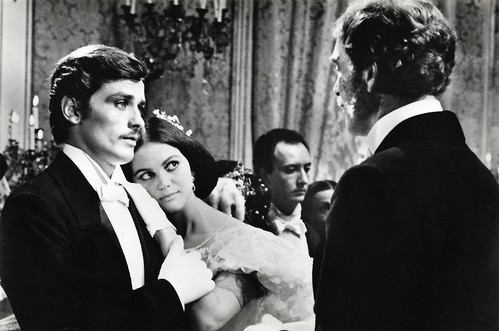
Czech postcard by UPTF / Pressfoto, Praha (Prague), no. C 198, 1965. Photo: G.B. Poletto. Alain Delon , Claudia Cardinale , and Burt Lancaster in Il Gattopardo/The Leopard (Luchino Visconti, 1963).
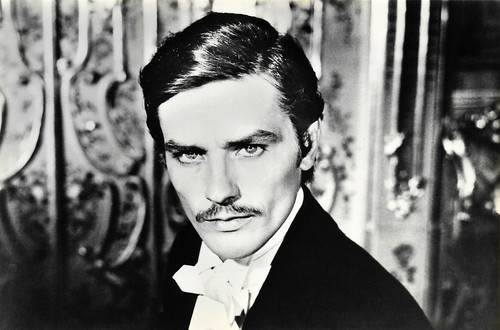
Czech postcard by UPTF / Pressfoto, Praha (Prague), no. C 199, 1965. Photo: G.B. Poletto. Alain Delon in Il Gattopardo/The Leopard (Luchino Visconti, 1963).
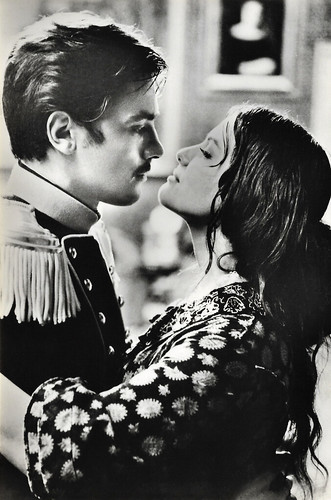
Czech postcard by UPTF / Pressfoto, Praha (Prague), no. C 200, 1965. Photo: G.B. Poletto. Alain Delon and Claudia Cardinale in Il Gattopardo/The Leopard (Luchino Visconti, 1963).
A ticket of admittance to the high-class soirées of the nobility
In Sicily in 1860, Don Fabrizio Corbera, Prince of Salina ( Burt Lancaster ) enjoys the customary comforts and privileges of an ancient and noble name. War has broken out between the armies of Francis II of the Two Sicilies and the insurgent volunteer redshirts of Giuseppe Garibaldi. Among the rebels is the Prince's remarkably handsome and dashing nephew, Tancredi ( Alain Delon ), with whose romantic politics the Prince shares some whimsical sympathy. Moved by the uprising, the Prince departs for nearby Palermo. Garibaldi's army conquers the city and Sicily from the Bourbons. The Prince muses upon the inevitability of change, with the middle class displacing the hereditary ruling class while on the surface everything remains the same.
Refusing to bend to the tide of necessity, the Prince departs for his summer palace at Donnafugata. A new national assembly has called a plebiscite which the nationalists win 512-0, thanks to the corruption of the town's leading citizen, Don Calogero Sedara ( Paolo Stoppa ), who sees his daughter, the exquisitely beautiful Angelica ( Claudia Cardinale ), as a ticket of admittance to the high-class soirées of the nobility. Bringing her with him to the villa of the Salinas, he watches as both the Prince and Tancredi fall abjectly in love with her. Realising his chance, he effectively pimps his daughter to the aristocracy, and Tancredi offers his hand. The Prince sees the wisdom of the match because he knows his nephew's vaulting ambition and need for ready cash, which Angelica's father, greedy for familial prestige, will happily make available. With the mutual blessing of the Prince of Salina and Don Calogero, Tancredi and Angelica become engaged.
A visitor from the constituent assembly comes to the villa. He begs the great scholar and nobleman to join the senate and help direct the ship of state; he hopes that the Prince's great compassion and wisdom will help alleviate the poverty and ignorance to be seen everywhere on the streets of Sicily. However, the Prince demurs and refuses this invitation, claiming that Sicily prefers its sleep to the agitations of modernity because its people are proud of who they are. He sees a future when the leopards and the lions, along with the sheep and the jackals, will all live according to the same law, but he does not want to be a part of this democratic vision. He notes that Tancredi has shifted allegiances from the insurgent Garibaldi to the king's army, and wistfully recognises that his nephew is the kind of opportunist and time-server who will flourish in the new Italy.
A great ball is held at the villa of a neighbouring Prince, and the Salinas and Tancredi attend. Afflicted by a combination of melancholia, the ridiculousness of the nouveau riche, and age, the Prince wanders forlornly from chamber to chamber, increasingly disaffected by the entire edifice of the society he so gallantly represents – until Angelica approaches and asks him to dance. Stirred and momentarily released from his cares, the Prince accepts, and once more he resembles the elegant and dashing figure of his past. Disenchanted, he leaves the ball alone and asks Tancredi to arrange a carriage for his family, and walks with a heavy heart to a dark alley that symbolises Italy's inordinate and fading past, which he inhabits.
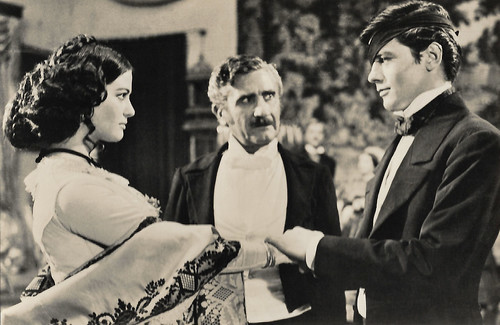
Small Czech collectors card by Pressfoto, Praha (Prague), 1965, no. S 101/6. Photo: G.B. Poletto. Claudia Cardinale , Paolo Stoppa , and Alain Delon in Il gattopardo/The Leopard (Luchino Visconti, 1963).
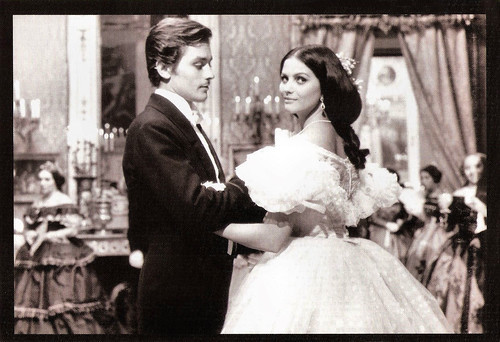
Vintage card. Photo: G.B. Poletto. Alain Delon and Claudia Cardinale in Il Gattopardo/The Leopard (Luchino Visconti, 1963).

Small Romanian collectors card. Photo: G.B. Poletto. Alain Delon and Claudia Cardinale in Il Gattopardo/The Leopard (Luchino Visconti, 1963).
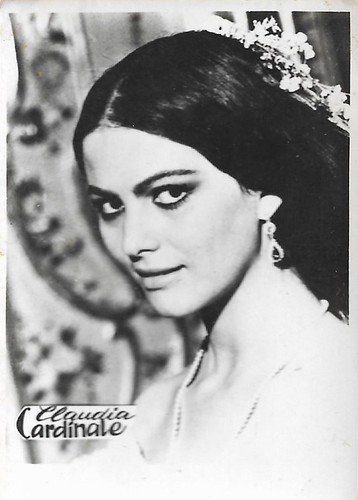
Small Romanian collectors card. Photo: G.B. Poletto. Claudia Cardinale in Il Gattopardo/The Leopard (Luchino Visconti, 1963).
One of the most spectacular sequences in film history
For the leading role in Il Gattopardo/The Leopard, the producers chose Hollywood star Burt Lancaster without consulting director Luchino Visconti. This insulted the director and caused tension on the set. However, Visconti and Lancaster ended up working well together, and their resulting friendship lasted the rest of their lives.
The epic cost production company Titanus $5 million. Visconti's first cut was 205 minutes long and was shortened to 195 minutes for its 1963 Cannes Film Festival premiere, where it won the Golden Palm for best picture. Visconti then cut the film further to 185 minutes for its official release and considered this version to be his preferred one. The picture was subsequently distributed by 20th Century Fox in a poorly dubbed, 165-min. English-language version, using an inferior colour process.
The film was a box office hit in Italy and other European countries, but international critics were mixed about the film. The restored Italian-language version, supervised by cinematographer Giuseppe Rotunno, appeared in 1990. Through the years, more and more people started to love the film. Martin Scorsese considers the film to be one of the greatest ever made, and in 2010, his Film Heritage Foundation restored the film to its original splendour.
Yuri German at AllMovie : "The closing section, an almost hour-long ball, is often cited as one of the most spectacular sequences in film history. Burt Lancaster is magnificent in the first of his patriarchal roles, and the rest of the cast, especially Delon and Cardinale, become almost perfect incarnations of the novel's characters. Filmed in glorious Techniscope and rich in period detail, the film is a remarkable cinematic achievement in all departments."
Ivo Blom in 'Visconti and the Visual Arts': "in Il Gattopardo, painting performs an important part in the sets of the film. A famous example is the painting don Fabrizio sees when entering a library during the ball in order to escape the crowd, a painting which reminds him of his own nearing death. A memento mori, so to say. The painting is a copy of Jean-Baptiste Greuze’s moralistic and sentimental work 'Le mauvais fils puni' (1778), today one of the masterpieces of the Louvre; a prodigal son returns too late, his father has died. (...)
Note also in Il Gattopardo the decaying old paintings in the attics of the palace, which Tancredi and Angelica see. They are not only indicators of the location, but also comment on the protagonists. Angelica’s old rose dress, though a bit old-fashioned for the period, stands out against the faded enormous battle scene she sees. Lampedusa already indicates it in the novel as Arturo Corbera at the Battle of Antioch, a battle scene between Crusaders and Muslims, but the painting in the film — an imitation made by Mario Brondi — is clearly a variation on Rubens’ 'Battle of the Amazons'. The painting is emblematical of the situation. Old glories of the aristocracy fade away, and the freshness and sensuality of Angelica is what counts."
Roger Ebert on his website: "Finally the prince dances with Angelica. Watch them as they dance, each aware of the other in a way simultaneously sexual and political. Watch how they hold their heads. How they look without seeing. How they are seen, and know they are seen. And sense that, for the prince, his dance is an acknowledgment of mortality. He could have had this woman, would have known what to do with her, would have made her his wife and the mother of his children and heard her cries of passion, if not for the accident of 25 years or so that slipped in between them. But he knows that, and she knows that. And yet of course if they were the same age, he would not have married her, because he is Prince Don Fabrizio and she is the mayor's daughter. That Visconti is able to convey all of that in a ballroom scene is miraculous and emotionally devastating, and it is what his movie is about."
Source: Film Heritage Foundation (YouTube). A clip from Il Gattopardo/The Leopard, restored in association with Cineteca di Bologna, L'Immagine Ritrovata, The Film Foundation, Pathé, Fondation Jérôme Seydoux-Pathé, Twentieth Century Fox and Centro Sperimentale di Cinematografia-Cineteca Nazionale - restoration funded by Gucci and the Film Foundation.

Cover of Ivo Blom's study 'Reframing Luchino Visconti'. Photo: Burt Lancaster in Il Gattopardo/The Leopard (Luchino Visconti, 1963).
Sources: Ivo Blom (Visconti and the Visual Arts), Roger Ebert, Yuri German (AllMovie), Julian Sanction (Vanity Fair), Wikipedia, and IMDb.

Czech postcard by UPTF / Pressfoto, Praha (Prague), no. C 198, 1965. Photo: G.B. Poletto. Alain Delon , Claudia Cardinale , and Burt Lancaster in Il Gattopardo/The Leopard (Luchino Visconti, 1963).

Czech postcard by UPTF / Pressfoto, Praha (Prague), no. C 199, 1965. Photo: G.B. Poletto. Alain Delon in Il Gattopardo/The Leopard (Luchino Visconti, 1963).

Czech postcard by UPTF / Pressfoto, Praha (Prague), no. C 200, 1965. Photo: G.B. Poletto. Alain Delon and Claudia Cardinale in Il Gattopardo/The Leopard (Luchino Visconti, 1963).
A ticket of admittance to the high-class soirées of the nobility
In Sicily in 1860, Don Fabrizio Corbera, Prince of Salina ( Burt Lancaster ) enjoys the customary comforts and privileges of an ancient and noble name. War has broken out between the armies of Francis II of the Two Sicilies and the insurgent volunteer redshirts of Giuseppe Garibaldi. Among the rebels is the Prince's remarkably handsome and dashing nephew, Tancredi ( Alain Delon ), with whose romantic politics the Prince shares some whimsical sympathy. Moved by the uprising, the Prince departs for nearby Palermo. Garibaldi's army conquers the city and Sicily from the Bourbons. The Prince muses upon the inevitability of change, with the middle class displacing the hereditary ruling class while on the surface everything remains the same.
Refusing to bend to the tide of necessity, the Prince departs for his summer palace at Donnafugata. A new national assembly has called a plebiscite which the nationalists win 512-0, thanks to the corruption of the town's leading citizen, Don Calogero Sedara ( Paolo Stoppa ), who sees his daughter, the exquisitely beautiful Angelica ( Claudia Cardinale ), as a ticket of admittance to the high-class soirées of the nobility. Bringing her with him to the villa of the Salinas, he watches as both the Prince and Tancredi fall abjectly in love with her. Realising his chance, he effectively pimps his daughter to the aristocracy, and Tancredi offers his hand. The Prince sees the wisdom of the match because he knows his nephew's vaulting ambition and need for ready cash, which Angelica's father, greedy for familial prestige, will happily make available. With the mutual blessing of the Prince of Salina and Don Calogero, Tancredi and Angelica become engaged.
A visitor from the constituent assembly comes to the villa. He begs the great scholar and nobleman to join the senate and help direct the ship of state; he hopes that the Prince's great compassion and wisdom will help alleviate the poverty and ignorance to be seen everywhere on the streets of Sicily. However, the Prince demurs and refuses this invitation, claiming that Sicily prefers its sleep to the agitations of modernity because its people are proud of who they are. He sees a future when the leopards and the lions, along with the sheep and the jackals, will all live according to the same law, but he does not want to be a part of this democratic vision. He notes that Tancredi has shifted allegiances from the insurgent Garibaldi to the king's army, and wistfully recognises that his nephew is the kind of opportunist and time-server who will flourish in the new Italy.
A great ball is held at the villa of a neighbouring Prince, and the Salinas and Tancredi attend. Afflicted by a combination of melancholia, the ridiculousness of the nouveau riche, and age, the Prince wanders forlornly from chamber to chamber, increasingly disaffected by the entire edifice of the society he so gallantly represents – until Angelica approaches and asks him to dance. Stirred and momentarily released from his cares, the Prince accepts, and once more he resembles the elegant and dashing figure of his past. Disenchanted, he leaves the ball alone and asks Tancredi to arrange a carriage for his family, and walks with a heavy heart to a dark alley that symbolises Italy's inordinate and fading past, which he inhabits.

Small Czech collectors card by Pressfoto, Praha (Prague), 1965, no. S 101/6. Photo: G.B. Poletto. Claudia Cardinale , Paolo Stoppa , and Alain Delon in Il gattopardo/The Leopard (Luchino Visconti, 1963).

Vintage card. Photo: G.B. Poletto. Alain Delon and Claudia Cardinale in Il Gattopardo/The Leopard (Luchino Visconti, 1963).

Small Romanian collectors card. Photo: G.B. Poletto. Alain Delon and Claudia Cardinale in Il Gattopardo/The Leopard (Luchino Visconti, 1963).

Small Romanian collectors card. Photo: G.B. Poletto. Claudia Cardinale in Il Gattopardo/The Leopard (Luchino Visconti, 1963).
One of the most spectacular sequences in film history
For the leading role in Il Gattopardo/The Leopard, the producers chose Hollywood star Burt Lancaster without consulting director Luchino Visconti. This insulted the director and caused tension on the set. However, Visconti and Lancaster ended up working well together, and their resulting friendship lasted the rest of their lives.
The epic cost production company Titanus $5 million. Visconti's first cut was 205 minutes long and was shortened to 195 minutes for its 1963 Cannes Film Festival premiere, where it won the Golden Palm for best picture. Visconti then cut the film further to 185 minutes for its official release and considered this version to be his preferred one. The picture was subsequently distributed by 20th Century Fox in a poorly dubbed, 165-min. English-language version, using an inferior colour process.
The film was a box office hit in Italy and other European countries, but international critics were mixed about the film. The restored Italian-language version, supervised by cinematographer Giuseppe Rotunno, appeared in 1990. Through the years, more and more people started to love the film. Martin Scorsese considers the film to be one of the greatest ever made, and in 2010, his Film Heritage Foundation restored the film to its original splendour.
Yuri German at AllMovie : "The closing section, an almost hour-long ball, is often cited as one of the most spectacular sequences in film history. Burt Lancaster is magnificent in the first of his patriarchal roles, and the rest of the cast, especially Delon and Cardinale, become almost perfect incarnations of the novel's characters. Filmed in glorious Techniscope and rich in period detail, the film is a remarkable cinematic achievement in all departments."
Ivo Blom in 'Visconti and the Visual Arts': "in Il Gattopardo, painting performs an important part in the sets of the film. A famous example is the painting don Fabrizio sees when entering a library during the ball in order to escape the crowd, a painting which reminds him of his own nearing death. A memento mori, so to say. The painting is a copy of Jean-Baptiste Greuze’s moralistic and sentimental work 'Le mauvais fils puni' (1778), today one of the masterpieces of the Louvre; a prodigal son returns too late, his father has died. (...)
Note also in Il Gattopardo the decaying old paintings in the attics of the palace, which Tancredi and Angelica see. They are not only indicators of the location, but also comment on the protagonists. Angelica’s old rose dress, though a bit old-fashioned for the period, stands out against the faded enormous battle scene she sees. Lampedusa already indicates it in the novel as Arturo Corbera at the Battle of Antioch, a battle scene between Crusaders and Muslims, but the painting in the film — an imitation made by Mario Brondi — is clearly a variation on Rubens’ 'Battle of the Amazons'. The painting is emblematical of the situation. Old glories of the aristocracy fade away, and the freshness and sensuality of Angelica is what counts."
Roger Ebert on his website: "Finally the prince dances with Angelica. Watch them as they dance, each aware of the other in a way simultaneously sexual and political. Watch how they hold their heads. How they look without seeing. How they are seen, and know they are seen. And sense that, for the prince, his dance is an acknowledgment of mortality. He could have had this woman, would have known what to do with her, would have made her his wife and the mother of his children and heard her cries of passion, if not for the accident of 25 years or so that slipped in between them. But he knows that, and she knows that. And yet of course if they were the same age, he would not have married her, because he is Prince Don Fabrizio and she is the mayor's daughter. That Visconti is able to convey all of that in a ballroom scene is miraculous and emotionally devastating, and it is what his movie is about."
Source: Film Heritage Foundation (YouTube). A clip from Il Gattopardo/The Leopard, restored in association with Cineteca di Bologna, L'Immagine Ritrovata, The Film Foundation, Pathé, Fondation Jérôme Seydoux-Pathé, Twentieth Century Fox and Centro Sperimentale di Cinematografia-Cineteca Nazionale - restoration funded by Gucci and the Film Foundation.

Cover of Ivo Blom's study 'Reframing Luchino Visconti'. Photo: Burt Lancaster in Il Gattopardo/The Leopard (Luchino Visconti, 1963).
Sources: Ivo Blom (Visconti and the Visual Arts), Roger Ebert, Yuri German (AllMovie), Julian Sanction (Vanity Fair), Wikipedia, and IMDb.
Published on September 07, 2020 22:00
Paul van Yperen's Blog
- Paul van Yperen's profile
- 13 followers
Paul van Yperen isn't a Goodreads Author
(yet),
but they
do have a blog,
so here are some recent posts imported from
their feed.



